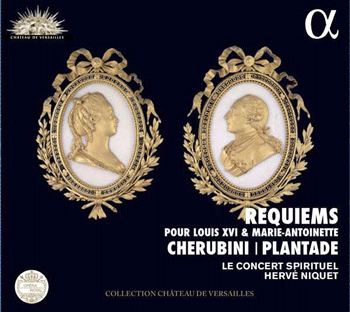June 27, 2017
Kathleen Ferrier Remembered
Bruno Walter accompanies Ferrier in two Schubert and two Brahms songs. Walter was a major influence on Ferrier, developing her style and repertoire and bring her to international prominence. Reputedly, she was so overcome rehearsing for Mahler's Das Lied von der Erde that she wept inconsolably. Perhaps it was that emotional directness that Walter recognized that convinced him that the relatively unknown young singer had potential. In these songs, recorded in the Edinburgh studios of the BBC, Ferrier's sincerity shines, though her delivery is more enthusiastic than refined. But that was part of her charm. Walter responds in kind, his playing particularly free and invigorating.
Ferrier's recordings of Mahler's Rückert Lieder and Kindertotenlieder are classics, but on this disc, she sings Urlicht, from Mahler's Symphony no 2. in the version for voice and piano. This recording was made on 28th September 1950. The following year, Ferrier sang the part with full orchestra in the recording of the symphony with Otto Klemperer and Jo Vincent in Amsterdam. The closer focus of this version concentrates attention on the voice and its distinctive colouring. Ferrier's vibrato is used to evoke fragility, in keeping with the nature of the piece. A worthwhile addition to the discography, since she didn't record this version for Decca. This recording predates the Christa Ludwig recording of this version of Urlicht by 13 years.
Apart from one track on this disc - C Hubert Parry's Love is a bable op 152/3 with Gerald Moore - all the other selections feature Ferrier with Frederick Stone. Ferrier sang a lot of Schubert and Wolf, her contralto richness is most effective in Brahms. Her Sonntag op 47/3 here, recorded in December 1949, is particularly impressive. Although Ferrier found fame, she was, at heart, down-to-earth and unaffected, rather like the "Das tausendschöne Jungfräulein" standing by her doorway, innocently capturing hearts. For this reason, perhaps, Ferrier is often most endearing when she sings traditional songs in the English language. This remastering makes Parry's Love is a Bable bright and shiny!
On this SOMM disc, we have Edmund Rubbra's Three Psalms op 61, which Ferrier recorded for Decca with Ernest Lush, in performance with Frederick Stone, from 1947. The piano settings are minimal, displaying the voice unadorned, suggesting private prayer. In Psalm 150, Rubbra writes extravagant lines, which let Ferrier's voice fly exuberantly free. SOMM has also uncovered a special rarity: Maurice Jacobson's Song of Songs, quite probably the original recording, which has lain in the BBC sound archives long known but hitherto unreleased. The text comes from the Book of Solomon, and the setting makes clear reference to Jewish tradition.
Anne Ozorio
image=http://www.operatoday.com/SOMMCD264-cover-Naxos-1024x1024.png
image_description=Kathleen Ferrier Remembered
product=yes
product_title=Kathleen Ferrier Remembered
product_by=SOMM Recordings
product_id=SOMMCD 264 [CD]
price=$16.99
product_url=http://www.arkivmusic.com/classical/album.jsp?ordertag=Perfrecom26738-2248248&album_id=2253572
Saint Louis Butterfly Soars
That is not to say there weren’t some distinctive touches. But here was a tradition-honoring, dramatically safe production of an evergreen classic that was first of all cast from strength. Cio-Cio San is a “big sing” and Rena Harms proved more than up to the task.
This, in spite of the fact that Ms. Harms was announced as indisposed with allergies. Since Cio-Cio San begins singing offstage, there is an especial emphasis on her voice alone, and owing to the circumstances, the first impression was that it was a bit guarded. Once she entered, we were able to observe that Rena is physically ‘right’ for the role, able to suggest a waif-like fifteen-year-old. In Act One, it seemed that she might be pacing herself, and her limpid soprano was prone to a slight flutter. That could also be owing to her affectation of innocence and naiveté.
Beginning in Act II, Ms. Harms really began to rally and go from strength to strength. Un bel di was touching and full voiced, and a spinto sheen began to evidence itself. Act III evolved into a no holds barred finale, with the diva hurling out full-throated, impassioned phrases that thrilled the ears and stirred the heart. The totality of her achievement was overwhelming, and the audience rose to their feet as one to laud her with an especially vociferous ovation.
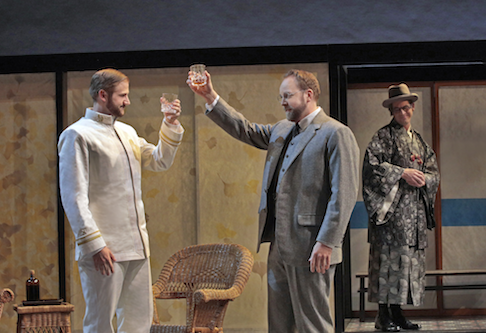 (L to R) Michael Brandenburg as B.F. Pinkerton, Christopher Magiera as Sharpless and John McVeigh as Goro
(L to R) Michael Brandenburg as B.F. Pinkerton, Christopher Magiera as Sharpless and John McVeigh as Goro
Michael Brandenburg was a smarmy, self-interested Pinkerton, nevertheless tall and handsome with a clear, muscular tenor. When he wasn’t ringing out over the full orchestra, he caressed his phony protestations of love with honeyed faux conviction. He also injected a tone of characterful cynicism into his early scenes that indelibly defined him as one of opera’s biggest cads.
It was wonderful to hear Christopher Magiera again. His mellifluous, burnished baritone has taken on new weight since last I heard him, and he brought gravity and a sympathetic, bungled paternalistic concern to Sharpless. Mr. Magiera’s assured presence and luminous vocalizing were one of the evening’s great strengths. Renée Rapier was also luxury casting as a potent Suzuki. Ms. Rapier's plummy mezzo radiated authority and her poised singing was a perfect partner for Ms. Harms, the two melding beautifully in their duet.
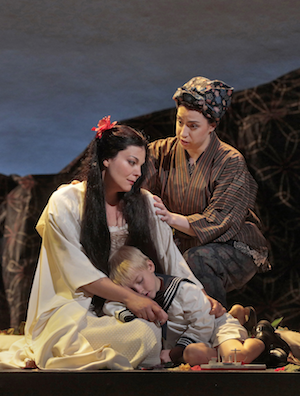 (L to R) Rena Harms as Cio-Cio-San, Sam Holder as Sorrow, and Renee Rapier as Suzuki
(L to R) Rena Harms as Cio-Cio-San, Sam Holder as Sorrow, and Renee Rapier as Suzuki
John McVeigh has a striking lyric tenor voice, but here he effectively subdued its polish to make Goro a mean-spirited, manipulative moneygrubber. Matthew Stump was an imposing, firm-voiced Bonze; Benjamin Taylor a somewhat stoic, though beautifully sung Prince Yamadori; and as Kate Pinkerton, Anush Avetisyan’s distinctive soprano contributed a pleasantly contrasting vocal quality.
In spite of the director’s program notes, Robin Guarino did not seem to re-define the roles of the three named women characters as much as she aspired. What Ms. Guarino did achieve was a cornucopia of effective business that helped define the established characters, as well as developing illuminative subtext that allowed them occasionally interact in fresh ways. She devised effective stage pictures and well-motivated movement, although the love duet curiously reverted to rather stock pairing poses.
Laura Jellinek’s set design was well considered, the upstage mountain appearing to be made of an origami collage. The house was positioned on a turntable to be able to suggest the “public” and “private” life of the heroine. This worked better at some times than others, and the long, flat structure got visually tiresome after a while. Too, there were times that it was turned and slightly angled to no real effect. Still, the suicide “inside” the house, followed by the revolve to allow Butterfly to stagger out the “public” side of the house superbly underscored the final effect.
Candice Donnelly devised and assembled a splashy, colorful set of costumes for the wedding, as well as more subtle, subdued garb for the principals. Tom Watson’s lovely, comprehensive wig and make-up design was notable for a tasteful lack of clichés. Christopher Akerlind’s reliable lighting provided the finishing touches to the look of the production.
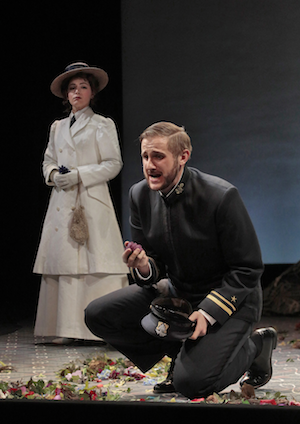 Anush Avetisyan as Kate Pinkerton and Michael Brandenburg as B.F. Pinkerton
Anush Avetisyan as Kate Pinkerton and Michael Brandenburg as B.F. Pinkerton
Michael Christie started off like gangbusters in the opening fugue, with a crackling downbeat. His urgent, breathless beginning soon mellowed out, and by the time we got to the expansive love duet, the Maestro’s pendulum seemed to have swung to the more languid realm. Whatever the tempi, Mr. Christie clearly knew what he wanted, and boy, did he get it! In the small Loretto Hilton theatre, the full scope of Puccini’s orchestral colors had a stunning immediacy, and his partnering with the singers was impeccable. Cary John Franklin’s chorus performed with its accustomed distinction.
In total, OTSL lovingly served up this timeless classic with an accessible translation, top tier talent, and conviction in a fool-proof formula that allowed Madame Butterfly to be a soaring achievement.
James Sohre
Cast and production information:
Pinkerton: Michael Brandenburg; Goro: John McVeigh; Suzuki: Renée Rapier; Sharpless: Christopher Magiera; Cio-Cio San: Rena Harms; Cousin: Andrea Núñez; Mother: Caitlin Redding; Uncle Yakuside: Dominik Belavy; Aunt: Stephanie Tritchew; Imperial Commissioner: Phillip Lopez; Office Registrar: Benjamin Dickerson; Bonze: Matthew Stump; Prince Yamadori: Benjamin Taylor; Kate Pnkerton: Anush Avetisyan; Conductor: Michael Christie; Director: Robin Guarino; Set Design: Laura Jellinek; Costume Design: Candice Donnelly; Lighting Design: Christopher Akerlind; Wig and Make-up Design: Tom Watson; Chorus Master: Cary John Franklin
image=http://www.operatoday.com/BFLY_3318a.png
image_description=Rena Harms as Cio-Cio-San and Michael Brandenburg as B.F. Pinkerton [Photo by Ken Howard]
product=yes
product_title=Saint Louis Butterfly Soars
product_by=A review by James Sohre
product_id=Above: Rena Harms as Cio-Cio-San and Michael Brandenburg as B.F. Pinkerton [Photos by Ken Howard]
Saint Louis: Gordon’s Revised Grapes
Not a festival goes by that OTSL does not present a world premiere, U.S. premiere, or an important second look at a recent notable composition, in this case Ricky Ian Gordon and Michael Korie’s The Grapes of Wrath.
Based on the celebrated Steinbeck novel, the sprawling masterpiece would seem difficult to tame. The Tony-winning play version produced by Steppenwolf Theatre Company succeeded, but even without music the show was overlong and occasionally hard to follow. The risk seems to be in trying to include too much.
Gordon’s Grapes premiered at Minnesota Opera in 2007 in a lengthy three-act version. In the intervening years, the creators have tightened the narrative considerably. The current two-act version distills the story to all the big moments strung skillfully together with well-defined character relationships and spare, meaningful dialogue. Thrilling choral moments lend an epic, almost cinematic sweep to the piece, elevating and ennobling the human suffering of the humble characters.
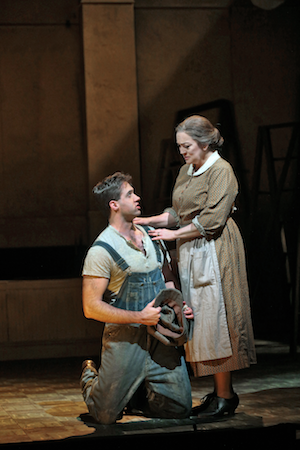 Tobias Greenhalgh as Tom Joad and Katharine Goeldner as Ma Joad
Tobias Greenhalgh as Tom Joad and Katharine Goeldner as Ma Joad
Mr. Gordon’s evocative, sometimes eclectic score is inspired by many another composer’s sound palette, including Copland, Bernstein, and Sondheim. Indeed some of the jauntier, folksier numbers recalled a miners’ number from Sondheim’s recent musical about the Meizner Brothers. (Or is it vice versa?) But no matter, Gordon has amalgamated these divergent influences and made this score sing with his own voice, thank-you-very-much. Orchestral writing is in turn varied, atmospheric, soaring, pulsating and colorful, and the vocal lines are grateful and illuminative of the characters’ outward plight as well as their inner feelings.
James Robinson has no equal when it comes to directing such sprawling, episodic contemporary works, and he has once again covered himself in glory as he drew the large ensemble into constant focus even as scenes and situations were in constant flux. When the action settled into an introspective aria, or a sensitive duet, Mr. Robinson deftly framed the moment to create a successive string of pearly ‘set pieces’ even as he preserved the forward motion of the narrative.
Set Designer Allen Moyer has provided an omnipresent soup kitchen as an overall metaphor, an environment in which all the various locales are suggested. As the audience enters the theatre, much of the cast is seated at tables in a parish hall, others loiter and converse in various groupings. A stage with US flag and red grand drape such as is often found in such venues, is up center. As the focal point, this platform is continuously re-dressed effectively to support many imaginative effects.
The cast constantly moves furniture and set pieces about with choreographed precision. At first, I wasn’t sure I was going to enjoy this rustic approach, and the first few scenes did not give me a good sense of time and place. I was won over in very short order, largely owing to the nonpareil lighting design by Christopher Akerlind.
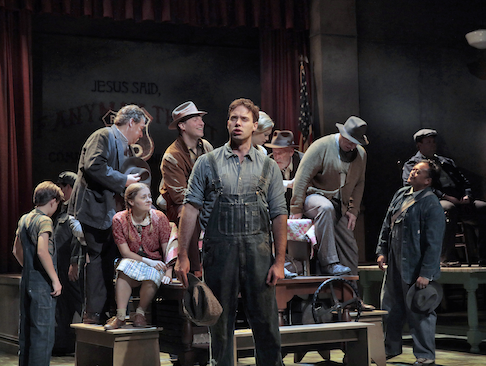 (Center) Tobias Greenhalgh as Tom Joad
(Center) Tobias Greenhalgh as Tom Joad
If I haven’t ever said before that Mr. Akerlind is a company treasure, I should have. His arsenal of effects was the beating heart of the physical production. To name just one heartrending visual: When slow-witted son Noah decides to drown himself to rid his family of the burden to feed him, he first “wades” in wash buckets lit from within. A large white cloth swoops in to cover him as he climbs on the platform. The cloth rises in front of him, and an intense blue spot backlights him as he ‘drowns’ as a floating shadow. All this is complemented by Ma Joad in an isolated special down right, sitting in a rocker with the infant Noah in her arms, a flashback to when she crooned him to sleep not that long ago. So searing, so simple, so profound.
Over the years, costume designer James Schuette has often dazzled us with attire of ravishing beauty. Here, he engaged us with a panoply of earthy, practical period street wear, work clothes and uniforms that aptly communicated the characters’ station in life. Is there room for a company to have two “treasures”? Hell, yes.
In the pit, Conductor Christopher Allen ruled with a sure hand and a full heart, wringing passion and pathos out of his musicians in equal measure. Maestro Allen not only embraced the sweeping cinematic phrases, he also injected sass and wit into the folk-like sections. Best, he managed to support and propel the soloists as they strove unrestrained to reach the emotional jugular in their arias and confrontations. He expertly shepherded the opera’s immense forces, including Cory John Franklin’s meticulously prepared chorus.
In the afore-mentioned Broadway play version of Grapes, Tom Joad got the last star bow. Here, Ma Joad was given that honor. It is easy to see why. While the piece is Tom’s journey (and he has one of the most famous inspirational speeches in all literature), Gordon, Korie, and Robinson have clearly made Ma the guiding force and (pace Steinbeck) I am convinced they are right.
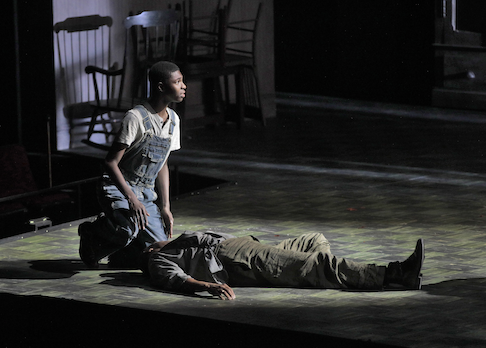 Nathaniel Mahone as The Boy in the Barn
Nathaniel Mahone as The Boy in the Barn
This role was such a perfect fit for Katharine Goeldener’s interpretive gifts, it is hard to know where Ms. Goeldener ended and Ma Joad began. Her Earth Mother presence swept all before it, barking orders one moment, comforting the sick another, healing the hurt as needed, and above all, trying to claw the family together with finger tips of steel. Here is a skilled vocalist with a sound technique who knows what her large, pointed mezzo-soprano can (and can’t) do. She takes some thrilling risks, pushing the voice for dramatic effect, and the results are often electrifying. But Katharine can also draw you in with sustained, floated pianissimi, so private and delicate that she breaks your heart. It is not often we are privileged to witness such a perfect marriage of artist and role.
In the same league, Tom Joad might have been written for baritone Tobias Greenhalgh, who dispatches the rangy role with solid commitment and vibrant vocalization. Mr. Greenhalgh has power to spare, but I did wonder if some of the role’s middle voice passages might not be too densely scored, especially if the piece were given in a larger house. Tobias’ sincere acting, handsome presence, pointed diction and strikingly rich voice made for a powerful impression, none more so than in his memorably sung I’ll be there aria.
Deanna Breiwick was an enchanting presence as Rosasharn. Her secure, silvery soprano floats effortlessly above the staff (and everywhere else, for that matter), and her slight physique and poised singing make her totally believable as the love struck, pregnant young wife. She infuses the opera’s final moments with such heart and hope and humanity that the tears I had been fighting for about the last twenty minutes came flooding like the ravaging rainstorm onstage.
As the Paterfamilias, Levi Hernandez brought tragic authority to Pa Joad, his rolling baritone a comforting presence. Geoffrey Agpalo creates another deeply affecting impersonation as Jim Casy, a former preacher with cheeky observations about life and living. His delectable lyric tenor was suavely deployed, and his opening aria accompanying himself on ukulele was a highlight. Andrew Lovato made the most of his stage time with a neatly sung Connie Rivers, Rosasharn’s restless husband. Mr. Lovato and Ms. Breiwick’s two duets were beautifully rendered, their effortless youthful timbres blending seamlessly.
Michael Day’s petulant Al Joad was wiry in demeanor, but smoothly sung with an assured, honeyed tenor. The waitress Mae has the most musical comedy-like aria with her humorous commentary on truckers and tipping, and Jennifer Panara delivered it with panache and a gleaming mezzo. Veteran Robert Orth used his experience and sometimes, sheer force of will to limn a memorable portrait of the crusty drunkard Uncle John.
Truth to tell, there was really no vocalist who did not excel in the many assignments they essayed. Please read the cast list below and know that each and everyone of them gets a personal bravo from me.
With this performance of The Grapes of Wrath, which closed the 2017 festival, I mused that this year’s four operas were perhaps the finest collection of my many OTSL experiences. While this will be a hard act to follow, I already can’t wait for what comes next.
James Sohre
Cast and production information:
Rosasharn: Deanna Breiwick; Ma Joad: Katharine Goeldner; Pa Joad: Levi Hernandez; Uncle John: Robert Orth; Connie Rivers: Andrew Lovato; Ruthie: Hannah Dishman; Winfield: Devin A. Best; Noah Joad: Hugh Russell; Al Joad: Michael Day; Tom Joad: Tobias Greenhalgh; Jim Casy: Geoffrey Agpalo; Pete Fowler: Michael Miller; Joe/Pump Guy 1: Evan Bravos; Fred/Pump Guy 2: Samuel Weiser; Hank/Lou: Matthew Dalen; Oklahoma Senator: Daevyd Pepper; Mulley’s Wife: Megan Callahan; Gramma: MaryAnn McCormick; Man in Suit/Agricultural Inspector: Alex Rosen; Constable/Trucker Joe: Dominik Belavy; Traffic Cop/Peach Checker: Phillip Lopez; Trucker/Striker Jim: Jeff Byrnes; Pump Guy 3: Matthew Swensen; Mae: Jennifer Panara; Val: Alexander McKissick; Trucker Bill/Commissary Clerk: Benjamin Dickerson; Cropper Woman/Hooverville Squatter: Nicolette Book; Cropper Husband/Washroom Guard/Vigilante George: Robert Stahley; Deputy: Rafael Helbig-Kostka; Cabin Mistress: Simona Genga; Striker Jake: Philippe L’Esperance; Soprano: Erica Petrocelli; Boy in Barn: Nathaniel Mahone; Conductor: Christopher Allen; Director: James Robinson; Set Design: Allen Moyer; Costume Design: James Schuette; Lighting Design: Christopher Akerlind; Wig and Make-up Design: Tom Watson; Chorus Master: Cory John Franklin
image=http://www.operatoday.com/GOR_0576a.png
image_description=The Joad Family [Photo by Ken Howard]
product=yes
product_title=Saint Louis: Gordon’s Revised Grapes
product_by=A review by James Sohre
product_id=Above: The Joad Family [Photos by Ken Howard]
Titus Lightens Up in Saint Louis
It made me laugh (and in a “good way”).
Productions of this least performed of Mozart’s mature operas usually are stiffly formal, with somber recitatives serving mostly as a respite from one extended aria after another, often posing as more a costumed concert than a viable dramma per musica.
Director Stephen Lawless and a witty translation by Daniel Dooner may have changed all that forever. Political intrigue still looms large in the telling of the story (how could it not?), but the plot twists hinge on a sex-kittenish Vitellia leading Sesto around by his . . .da capo aria. Have you ever laughed out loud as this villainess vamps the conflicted patrician? Has anyone? We did!
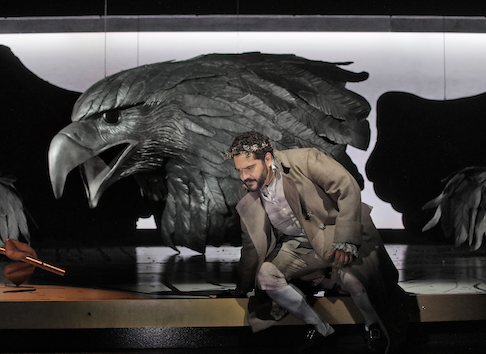 René Barbera
René Barbera
This does not mean to suggest that Mr. Lawless has encouraged gratuitous schtick. No, rather he has rooted the character relationships in truthful interaction, underscoring the naughty, lethal game being played out by a vengeful, power hungry daughter of the deposed emperor. He also understands that there is much about the piece that is uncompromisingly dramatic, infused with profound human emotions. He trusts that those moments will take care of themselves and be even better for some light-footed balance. His effective use of the playing space included having the chorus positioned in the house aisles for the more formal court scenes.
The director has been gifted with a cast that is nigh unto perfection. As Vitellia, Laura Wild seems well on her way to becoming the Mozart soprano of choice. Her creamy, evenly produced tone had outstanding presence in every register and she colored it beautifully to reflect her changing moods, starting out teasing and urging, and ending up repentant and confessorial. Ms. Wild is also highly adept at executing the florid writing and ornamentations, suggesting a woodwind-like quality that illuminated every extended melisma. Her dramatic gifts equal her splendid instrument, most especially her deft, subtle comic timing.
The title role can often be eclipsed by the musical machinations swirling around him, but not so here. René Barbera returned to OTSL, having scored early career successes here in comic roles in The Daughter of the Regiment and The Elixir of Love. Happily, Mr. Barbera found just as congenial a fit with the clement, benevolent emperor, his gleaming tenor ringing out with alluring, stylish aplomb. His is one of the most easily produced, engagingly warm male voices currently before the public, and his ingratiating charisma makes his every performance a joy.
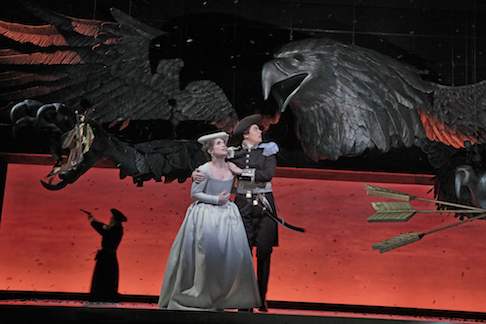 Monica Dewey and Emily D’Angelo
Monica Dewey and Emily D’Angelo
Whereas many practitioners of this role limit themselves to projecting the high-handed nobility of the emperor, René also incorporates all of the conflicted humanity, the deep hurt of his betrayal, and a convincing personal debate of whether or not to execute his beloved friend. You simply won’t see a more persuasive, well-rounded performance of the titular hero than that by René Barbera.
The two trouser roles were uncommonly well cast. Sesto has much of the opera’s very best material, and Cecelia Hall was more than up to the task. Her pliant, plangent mezzo created a convincing case for a lovesick, gullible youth, blind to the fast that he is being manipulated not only to betray his best friend, but also to commit a heinous crime. Ms. Hall made Parto, parto into a finely detailed musical journey as she mused and debated her inevitable course of action.
Emily d’Angelo was a potent match with her assured traversal of Annio. Her vibrant, focused tone was flexible and expressive, but also had a nice hint of metal in it that convinced us Annio was a headstrong foil for Sesto. Ms. D’Angelo’s demonstrative reading of her dramatically florid aria won one of the show’s biggest ovations. Icing on the cake: Both ladies-as-boys were lanky and trim, and were utterly convincing as two juvenile men.
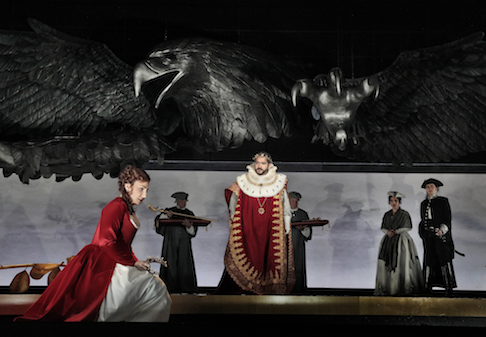 (L to R) Laura Wilde, René Barbera, Monica Dewey, and Emily D’Angelo
(L to R) Laura Wilde, René Barbera, Monica Dewey, and Emily D’Angelo
Rounding out the soloists, Monica Dewey was a jewel of a Servilia. Ms. Dewey doesn’t have as much stage time, but her gleaming, poised soprano and delightful stage manner immeasurably enhanced every scene she was in. As Publio, Matthew Stump’s solid bass-baritone and imposing stature provided a welcome balance.
Leslie Travers has provided a handsome set design that suggests ancient Rome, counter-balanced with a luxurious costume design that is more rooted in the time of the opera's composition. The rather severe formal attire for the chorus and most principals was rather severe, with black and white waistcoats, capes and tri-corn hats for the men (of both sexes) and chorus, and formal gowns for Servilia. Titus and Vitellia were afforded luxurious, red raiment, although Titus' costumes straddled both color palettes.
The environment includes a huge rectangular platform, subtly painted with a Roman street map, presided over by an immense suspended eagle sculpture suggestive of the Roman SPQR standard, with olive branch and arrows in its respective talons. This eagle de-constructs remarkably as the city is consumed by fire, and crumbles to the floor in four separate pieces as black “ash” confetti falls from the flies. Adding to the dramatic effect was Christopher Akerlind’s masterful lighting design.
Last but most certainly not least, this performance of Titus marked Stephen Lord’s last appearance on the podium as longtime Music Director. Maestro Lord has given us a lot to be grateful for over his tenure, but none more so that this lovingly rendered, stylistically correct, and dramatically propulsive reading of a Mozartean gem. His rapport with the singers and instrumentalists alike was remarkable and his inspired leadership was of the highest order. Bravo, Maestro, e buona fortuna!
James Sohre
Cast and production information:
Vitellia: Laura Wild; Sesto: Cecelia Hall; Annio: Emily d’Angelo; Publio: Matthew Stump; Tito: René Barbera; Servilia: Monica Dewey; Conductor: Stephen Lord; Director: Stephen Lawless; Set and Costume Design: Leslie Travers; Lighting Design: Christopher Akerlind; Wig and Make-up Design: Tom Watson; Choreographer: Seán Curran; Chorus Master: Cary John Franklin
image=http://www.operatoday.com/TITUS_0288a.png
image_description=(L to R) Cecelia Hall and Laura Wilde [Photo by Ken Howard]
product=yes
product_title=Titus Lightens Up in Saint Louis
product_by=A review by James Sohre
product_id=Above: (L to R) Cecelia Hall and Laura Wilde [Photos by Ken Howard]
Il turco in Italia: Garsington Opera
The production is set in a Naples of the 1950s. But this is a witty picture-postcard Naples, with clean-cut healthy gypsies, and sunny temperaments all round; Francis O'Connor's giant postcard forming a backdrop from which Fiorilla (Sarah Tynan) and Geronio's (Geoffrey Dolton) house appears, and the prow of Selim's (Quirijn de Lang) yacht dramatically pierces through. Prosdocimo's (Mark Stone) balcony overlooking the bay is always in view, and we see Prosdocimo at work constantly throughout the opera.
Duncan's production was very much a combination of music and movement, not for nothing was Nick Winston movement director and assistant director. Each solo and ensemble was carefully and wittily choreographed, in a way which charmed and delighted yet emphasised the artificiality of Rossini's drama. Yet Duncan and Winston never pulled focus, and the show was a brilliantly entertaining piece of musical theatre which ensured that we always concentrated on the right people on stage. The large set pieces mirroring Rossini's big ensembles were a particular delight.
As yet the production seems slightly under-cooked, as if there has not been quite enough rehearsal time on the Garsington stage. I was aware of small ensemble problems, and the fact that complex vocal ensembles are accompanied by complex movements does make the production a particular challenge. For the first time since coming to Garsington Opera's new home, I was aware of the sheer width of the stage, perhaps because Francis O'Connor's set, with its large postcard back drop set at an angle, was rather acoustically unhelpful, projecting sound at an angle.
In many ways Il turco in Italia is one of the most human of Rossini's comedies, and the character's less cardboard cut-out than some. But Duncan's production seemed to be encouraging us to enjoy the piece as a mechanism, and it did not always bring out the humanity of the characters. Perhaps, once the production has bedded in this will happen more, but you felt that the cast were concentrating more on performing a show for us rather than interacting as characters. There were, however, strong individual performers and those returning to the production (Quirijn de Lang, Mark Stone and Geoffrey Dolton) were most successful at making us care for their characters.
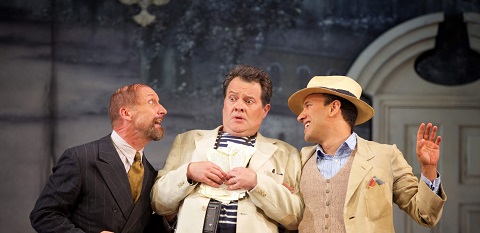 Geoffrey Dolton (Geronio),Mark Stone (Prosdocimo),Luciano Botelho (Narciso). Photo credit: Alice Pennefather.
Geoffrey Dolton (Geronio),Mark Stone (Prosdocimo),Luciano Botelho (Narciso). Photo credit: Alice Pennefather.
Mark Stone, on stage for most of the time and often acting as puppet master, really made the show. His is not always a natural Rossini voice, but he brought a frankness, openness and vivid sense of character to Prosdocimo which made you care for him, and made his need to find a plot and write his play really matter.
Quirijn de Lang in the title role as Pasha Selim really looked the part, even managing to look suave, elegant and sexy in a series of embarrassing be-jewelled mini-turbans. De Lang moved with suaveness and elegance, and really encapsulated the sort of untrustworthy lounge-lizard familiar from films (though to characterise a Turk like this seemed, perhaps, borderline racist). But this is a Rossini buffo bass part (the original singer also created Mustafa in L'Italiana in Algeri), and whilst I can understand the wish to try to re-invent the character somewhat, I would have liked a little more vocal swagger from De Lang. He sang Rossini's vocal lines efficiently though his passagework was a trifle smudgy, I would have liked more vocal bravura.
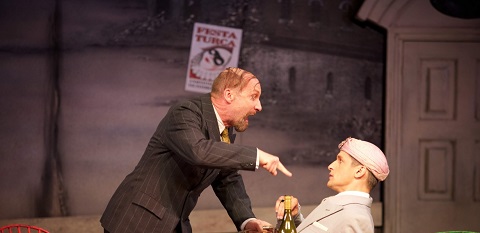 Geoffrey Dolton (Geronio), Quirijn de Lang (Selim). Photo credit: Alice Pennefather.
Geoffrey Dolton (Geronio), Quirijn de Lang (Selim). Photo credit: Alice Pennefather.
Sarah Tynan brought real vocal fireworks to the role of Fiorilla and her account of Fiorilla's final aria, when she thinks she is being divorced by Geronio, managed to combine bravura singing with the right degree of pathos. Selfish and uncaring of the men around her, Fiorilla is not the most sympathetic of characters, and for most of the opera we could admire the beauty of Tynan's singing and the incredibly stylish figure she cut on stage without really caring for Fiorilla. But perhaps this is churlish given the complexity and elegance of Tynan's singing.
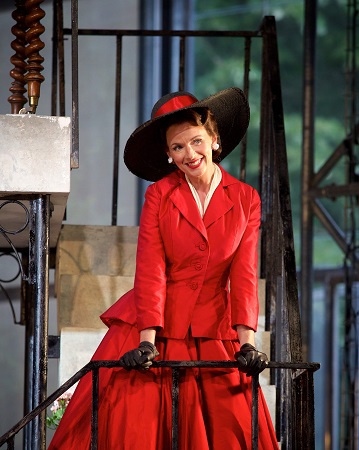 Sarah Tynan (Fiorilla). Photo credit: Alice Pennefather.
Sarah Tynan (Fiorilla). Photo credit: Alice Pennefather.
Katie Bray, as Selim's former lover Zaide, had perhaps an easier job to make her character sympathetic as the wronged innocent, but Bray really made Zaide count. She combined a vivacity with warmth of tone, and created a real sense of character. Geoffrey Dolton had the gift of being able to be terrifically funny, whilst still making us care for poor put-upon Geronio, constantly being imposed upon by his wife. Luciano Botelho bravely essayed the challenging role of Narciso with its high-wire acrobatics (it was written for Giovanni David who created Rodrigo in Otello and whose range went, easily, up to high F). Botelho has an attractive lyric tenor voice with a delightful stage presence, but when singing in alt his voice had a tight, edgy quality. Some of this may indeed be first night nerves, but you felt that a more acoustically helpful set might have added a little warmth. Jack Swanson made a very personable Albazar and you wished that he had more to do.
In the pit, David Parry drew some not unstylish playing from the orchestra, though we were also aware of the challenge of keeping some of the ensembles on track.
This was an enjoyable evening in the theatre, with some brilliant theatrical moments and engaging singing. Most of the audience will have gone home happily entertained, but I felt that the production had the capability of being something much more.
Robert Hugill
Rossini Il turco in Italia
Selim: Quirijn de Lang, Fiorilla: Sarah Tynan, Prosdocimo: Mark Stone, Zaida: Katie Bray, Don Geronio: Geoffrey Dolton; director: Martin Duncan, conductor: David Parry, designer: Francis O’Connor.
Garsington Opera, 26 June 2017
image=http://www.operatoday.com/Garsington%201.jpg image_description=Il turco in Italia, Garsington Opera 2017 product=yes product_title=Il turco in Italia, Garsington Opera 2017 product_by=A review by Robert Hugill product_id= Katie Bray (Zaida) with members of the chorusPhoto credit: Alice Pennefather
Glyndebourne's wartime Ariadne auf Naxos
When, in the Prologue, the Dancing Master jokes that the commedia dell’arte troupe’s vaudeville would be better performed after the new opera that His Lordship has commissioned - because once ‘the great and the good’ have stuffed themselves at dinner they will be bored stiff by the opera, nod off, and be ready for some more zippy entertainment - Glyndebourne patrons might feel that the self-referential nudges are getting a bit sharp.
I’m not sure how many meta-layers one has to plunge through before we’re into surreal territory, but there is certainly plenty of scope for farce during Thoma’s Prologue. The Composer, an over-sensitive idealist, becomes desperate and distraught when he learns that his patron - originally a nouveau riche in eighteenth-century Vienna - has decreed that his maiden opera, a lofty rendition of the myth of the god Bacchus rescuing Ariadne from Naxos, must, owing to time pressures over the dining arrangements, be performed simultaneously with a low-brow comic romp.
During the orchestral prelude, the Music Master and a few lackeys fuss about with malfunctioning front curtains. As the fraught preparations unfold, servants mount step-ladders to pin up patriotic bunting choreographed to the gloriously sensual peaks of Strauss’s score, while grumpy army personnel and petulant singers whizz back and forth slamming doors behind them. The palm tree on the ‘set’ of Naxos wilts, emasculated by drought or by the thought of the entertainment ahead, who knows. A barbershop quartet in natty green-and-white striped blazers put their feet through their paces and try out their poses (Strauss’s score indicates that they enter in ‘goose-step’ which despite the period setting Thoma wisely eschews), while the Prima Donna dons a leopard skin coat and, towering over the haughty Major-Domo, threatens to flounce out in pique.
The only one with a cool head is Thomas Allen’s Music Master and even he is momentarily wrong-footed by the butler’s announcement of His Lordship’s unusual request. As unswervingly dependable as ever, Allen’s diction and acting is superlative in the secco recitative: he placates the chest-puffing Tenor, destined for the role of Bacchus, and cajoles the diva soprano - she’ll be deemed even more sublime when judged against such riff-raff - and all prepare to get the show underway.
As the troupe’s leading lady, Zerbinetta, tries to win round the despairing Composer with a kiss, Strauss and Hofmannsthal entwine the opera’s two themes: the role of art in society and the nature of true love. Is this kiss, as Zerbinetta suggests, just a fleeting instant never to be relived or, as The Composer hopes, an eternal moment never to be forgotten?
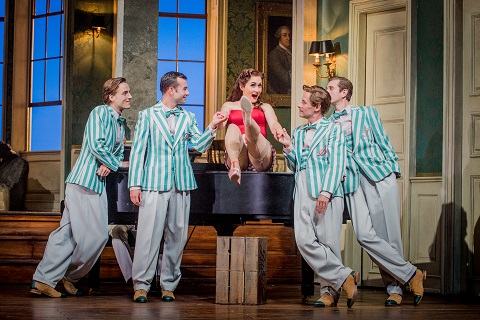 Four comedians (Daniel Mirosław, Björn Bürger, Manuel Günther, François Piolino), Dancing Master (Michael Laurenz) and Zerbinetta (Erin Morley). Photo credit: Robert Workman.
Four comedians (Daniel Mirosław, Björn Bürger, Manuel Günther, François Piolino), Dancing Master (Michael Laurenz) and Zerbinetta (Erin Morley). Photo credit: Robert Workman.
Attention is diverted, however, by looming shadows which are cast by the wings of a Luftwaffe squadron that swoops low over the gardens. The House takes a direct hit, the blast of explosive sparks usurping the promised firework display. Dinner guests, downstairs staff and artistes evacuate the burning building, with just the Composer left behind, writhing in despair, clutching his score and begging to be allowed to die with his integrity and artistic ideals intact: ‘Tod und Verklärung’ indeed.
At this point, Strauss asks us to sit back, watch the ‘hybrid entertainment’ and judge for ourselves between ‘high’ and ‘low’ art, and between unwavering faithfulness and cheerful promiscuity. Thoma, however, does not present us with the opera-within-an-opera but side-steps into a different narrative. The director professes to wish us to imagine that ‘something major happens between Parts 1 and 2’ and that the catastrophe of war has thrown The Composer ‘into a more urgent situation’.
So, we return to the manor house a few months later and discover that it is now serving as a hospital for the wounded and traumatised. Instead of naiads we have Florence Nightingales who tend to the nightmare-afflicted PTSD sufferers. To account for the presence of Zerbinetta and the harlequinade, Thoma turns them into ENSA entertainers who are preparing a wartime variety show to perk up the patients.
I’m not sure that soft shoe shuffles and musical hall ditties are the best kind of music therapy for the severely traumatised. When the sleeping Ariadne wakes, she entreats her entertainers to be relieved of the heartbreak of life; for a moment, I was reminded that the popular translation of the acronym ENSA was ‘Every Night Something Awful’.
In fact, the dapper quartet - Björn Bürger (Harlequin), François Piolino (Scaramuccio), Daniel Mirosław (Truffaldino) and Manuel Günther (Brighella) - croon charmingly and gambol with panache. And, taken on its own terms Thoma’s concept works well. The problem is that it has nothing to do with Strauss and Hofmannsthal’s intention that after the ‘realism’ of the Prologue we should be offered an artifice, the juxtaposition cleverly guiding us to interrogate the relationship between art and life. In literalising the question - making the Composer ‘face the reality that not only artistic interferences but the outside world are breaking into his ivory tower’ - Thoma disturbs the subtle balance and interplay devised by the original creators.
That said, this cast are so good that one can push such matters aside and simply enjoy the fantastic singing. Angela Brower’s Composer has theatrical presence and flashes with fury when his dream debut is being sabotaged. Brower is convincingly elevated and ecstatic when singing of the redeeming power of music, shaping the arioso beautifully.
Erin Morley’s frivolous, flirtatious Zerbinetta injects some vitality amid the misery and morbidity. When teasing The Composer, Morley apes his lyricism with tenderness, and her soprano sparkles through the roulades of her virtuoso showpiece, in which she advises Ariadne to adopt a laissez faire worldliness in her romantic liaisons. Her agility and reliability at the top did not seem to merit the punishment - being locked into a straitjacket - that the staid ward sisters inflict upon Zerbinetta.
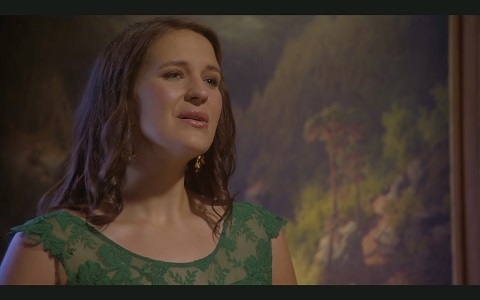 Lise Davidsen (Ariadne). Photo credit: Robert Workman.
Lise Davidsen (Ariadne). Photo credit: Robert Workman.
To say that Lise Davidsen is head-and-shoulders above the rest is not just a reflection on her statuesque height. Davidsen’s gloriously full and shining soprano transforms Ariadne - draped in a black hospital dressing-gown - back into a ‘goddess’. It’s no effort for Davidsen to swell through Strauss’s elated vocal peaks, her soprano bursting with lustre, but she can hold her huge voice back, too, shaping cool threads of sound to convey Ariadne’s vulnerability. Her reminiscence of love with Theseus was one of those moments when time seemed to stand still, triggering thoughts that at the premiere of the lament’s progenitor, Monteverdi’s 1607 setting of the same myth, it was recorded that ‘There was not one lady who failed to shed a tear’. And, in her joyful anticipation of death, Davidsen retained a grace and nobility which rose above the context.
Thoma struggles to make Bacchus’s arrival and subsequent wooing of Ariadne convincing. Bacchus has escaped from the sea nymph Circe and when he is spied approaching Naxos, Ariadne mistakes him first for Theseus and then for Hermes the Messenger of Death for whom she has been calling. AJ Glueckert’s Bacchus is not water-borne - the hospital is clearly not located by the seaside - but arrives by air. He’s a Battle of Britain pilot and it’s not clear who or what he’s escaped from, but once he has clambered through the window he’s quickly urged by the dulcet trio of Naiad (Hyesang Park), Dryad (Avery Amereau) and Echo (Ruzan Mantashyan) to continue his song and assuage Ariadne’s grief.
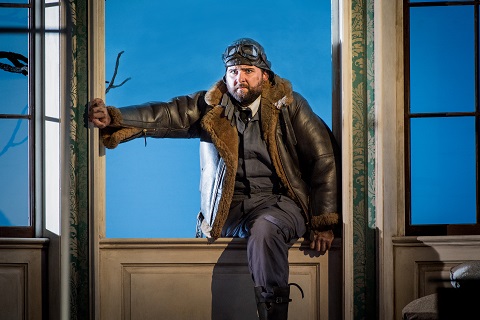 AJ Glueckert (Bacchus). Photo credit: Robert Workman.
AJ Glueckert (Bacchus). Photo credit: Robert Workman.
When Hofmannsthal wrote to Strauss clarifying the ‘meaning’ of the end of the opera, the composer encouraged him to publish what has become known as the ‘Ariadne letter’: the librettist explains that Ariadne and Bacchus are ‘transformed through mutual influence - she was prepared to die but reborn as immortal heavenly body; Bacchus realises the full nature of his divinity’. In the hospital ward, such thoughts seemed a long way off. Believing that she is about to be conducted to the land of the dead, Davidsen blindfolds herself and kneels before Hermes/Bacchus, but he seems unconcerned during her appeal to be released her from earthly suffering, preferring to read the newspaper. Fortunately, Glueckert’s appealing tenor is youthful and rich, and he has the stamina required to survive Strauss’s seemingly endless denial of the need for a perfect cadence. The final, lengthy duet certainly was ‘godly’.
Conducted by a sprightly Cornelius Meister, the London Philharmonic Orchestra played with airiness and clarity, the chamber-like forces rising to the challenges of Strauss’s instrumental sonorities. The lead clarinet and horn were especially elegant.
In a programme article, Thoma describes the opera as both a debate about merit of high and low art and ‘a journey from despair and disappointment to hope’. Her white hospital robe effectively becoming her wedding gown, Ariadne retreats behind the bed-curtains - which have been miraculously hoisted to the ceiling and are being gently stirred by wafts of air (has Bacchus left the window open?) - where she and Bacchus can be heard in rapturous celebration of their love.
The Composer reappears bearing a suitcase - he’s been discharged having apparently recovered from his mental anguish - and is amazed to espy his former idol canoodling with a fighter-pilot cum Greek god. In his astonishment, he spots the score of his opera lying on the table and flicks through to the final pages. There is a pause, a wry smile, a quick glance back at the transfigured couple, before our ‘hero’ departs reconciled, redeemed, restored. It is as if, in the opera’s final moments, Thoma has remembered The Composer’s climactic phrase from the Prologue: ‘Musik ist eine heilige Kunst’.
Claire Seymour
Richard Strauss: Ariadne auf Naxos
Ariadne - Lise Davidsen, Composer - Angela Brower, Zerbinetta - Erin Morley, Bacchus - AJ Glueckert, Music Master - Thomas Allen, Dancing Master - Michael Laurenz, Scaramuccio - François Piolino, Harlequin - Björn Bürger, Brighella - Manuel Günther, Truffaldino - Daniel Mirosław, Naiad - Hyesang Park, Dryad -Avery Amereau, Echo - Ruzan Mantashyan, Major-Domo - Nicholas Folwell, Lackey - Edmund Danon, Officer - John Findon; Director - Katharina Thoma, Conductor - Cornelius Meister, Set Designer - Julia Müer, Costume Designer - Irina Bartels, Lighting Designer - Olaf Winter, London Philharmonic Orchestra.
image=http://www.operatoday.com/The%20Composer.jpg image_description=Ariadne auf Naxos, Glyndebourne product=yes product_title= Ariadne auf Naxos , Glyndebourne product_by=A review by Claire Seymour product_id=Above: Angela Brower (The Composer)Photo credit: Robert Workman
June 25, 2017
On Trial in Saint Louis
This lean, mean, darkly humorous lyric piece is based on Franz Kafka’s story as adapted by librettist Christopher Hampton and composed by the prolific minimalist Philip Glass. Its disturbing relevance proves at once contemporary and cautionary.
Josef K., you see, is being arrested for an unspecified crime. He is under constant observation, his every move is questioned; his every statement parried or parsed. Innuendo and supposition substitute for evidence. Swirling around him is an ever-morphing ensemble of quirky, murky grotesques.
The anchor of the production is the physically slight, vocally towering performance of Theo Hoffman as Josef K. Seldom off stage, Mr. Hoffman deployed his ringing baritone to tremendous effect, mining every nuance out of a wide-ranging, emotionally draining characterization. His beautifully internalized acting made K a wholly engaging personality, a sympathetic patsy whose victimization was first cruelly comical, then horrifyingly tragic. His beautifully modulated singing was even throughout all registers, and was as notable for its powerful bursts of indignation as for its introspective, whimpering cries of disbelief. Theo has created as thrillingly definitive a rendition of this central character as is likely possible.
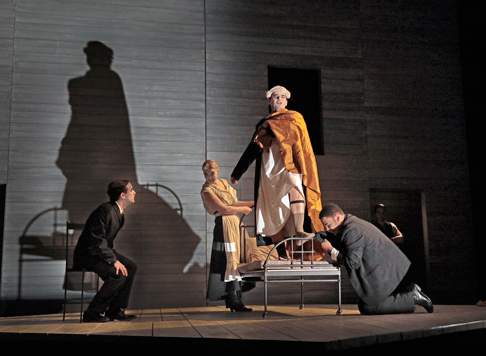 Theo Hoffman, Susannah Biller, Keith Phares, and Joshua Blue
Theo Hoffman, Susannah Biller, Keith Phares, and Joshua Blue
And OTSL, being such a reliably renowned company, has surrounded their riveting star with an equally accomplished cast of supporting players, all of whom assume multiple roles with equal success.
Joshua Blue and Robert Mellon set the bar very high with their initial appearances as the arresting officers (Guards) with secure vocalizing, theatrical energy, and uninhibited comic business. Both had notable success in their “name” roles as Block (Mr. Blue) and the Priest (Mr. Mellon), the latter having a penultimate scene with K that drew powerful, unrestrained vocalizing from Mr. Mellon.
Matthew Lau’s weighty bass brought a smarmy gravitas to the Inspector, and a sinuous presence to Uncle Albert. Sofia Selowsky was such a free-wheeling, sexed-up Washerwoman, her stage antics almost upstaged her beautifully free, rich-toned mezzo. She also shone in her doubling as Frau Brubach and Woman. Soprano Susannah Biller offered silvery singing and detailed acting in the dual roles of . Fräulein Bürstner and Leni. The latter especially highlighted Ms. Biller’s gifts, allowing not only for awesome vocal flights but also gripping acting.
Keith Phares seemed to be having a field day with the triple challenges of the Magistrate, Assistant, and the bed-ridden (or is he?) Lawyer Huld. Mr. Phares’ fluid baritone is warm and ingratiating, and it has adopted a pleasing patina over the years. Brenton Ryan was a solid Berthold, and a willing Flogger (don’t ask), but his bright tenor and unrestrained acting chops really packed a wallop as the eccentric painter Titorelli.
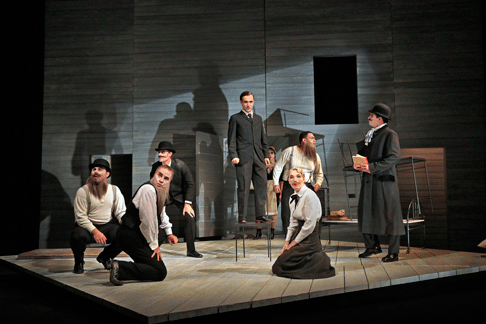 The cast of The Trial
The cast of The Trial
The Expressionistic set and costume designs by Simon Banham were notable for their smart starkness and highly effective in their blunt simplicity. A square platform was placed like a baseball diamond right up to the edge of the pit. It was backed by a floor-to-ceiling wall, both constructed with rustic, light gray wooden planking. The wall has a high window, a couple of doorframes, and double barn doors dead center that open and close to reveal changeable insets.
Late in the show, the wall parts and tracks off stage, leaving only the island of the platform, almost “floating” against the all-black background. Costumes were mostly black and white, and clearly communicated each character. The brilliant lighting design was one of Christopher Akerlind’s best, with its intentionally limited use of color, and its incorporation of cock-eyed, disorienting trapezoidal projections. The simple combination of carefully selected furniture and its seamless incorporation into the staging were admirable.
Director Michael McCarthy has brilliantly harnessed all this talent into a tightly focused, beautifully controlled whole. He has seized on the Big Brother concept. When actors are not directly involved in a scene, they are observing, hovering, menacing in an intriguing variety of stage pictures. Mr. McCarthy has created an awesome ensemble with these singers, able to turn on a dime, serving as a solo character one minute, observer another, and set changer yet another, before plunging back into the action as a totally different character. This high level of ensemble playing simply does not happen without a skilled director of the caliber of Michael McCarthy.
And speaking of a “high caliber of ensemble playing” (and I was), Conductor Carolyn Kuan worked equal magic in the pit. Maestra Kuan elicited the all-important, pulsating, rhythmically precise orchestral execution, to be sure. She also drew an abundance of color from her players and singers alike, achieving a varied palette of satisfying musical effects. In a score that has a fair share of twitchy, angular components, Ms. Kuan managed to cue each and every entrance with an incredible accuracy.
The Trial may not send you out of the theatre humming a tune, but owing to this illuminating production, it cannot help but leave you challenged and changed.
James Sohre
Cast and production information:
Josef K.: Theo Hoffman; Franz (Guard 1)/Block: Joshua Blue; Willem (Guard 2)/Court Usher/Clerk of Court/Priest: Robert Mellon; The Inspector/Uncle Albert: Matthew Lau; Frau Grubach/Washerwoman/Woman: Sofia Selowsky; Fräulein Bürstner/Leni: Susannah Biller; Magistrate/Assistant/Lawyer Huld: Keith Phares; Berthold, a Student/Flogger/Titorelli: Brenton Ryan; Conductor: Carolyn Kuan; Director: Michael McCarthy; Set and Costume Design: Simon Banham; Lighting Design: Christopher Akerlind; Wig and Make-up Design: Tom Watson
image=http://www.operatoday.com/TRIAL_0591a.png
image_description=Robert Mellon, Theo Hoffman, Joshua Blue, Susannah Biller, and Keith Phares [Photo by Ken Howard]
product=yes
product_title=On Trial in Saint Louis
product_by=A review by James Sohre
product_id=Above: Robert Mellon, Theo Hoffman, Joshua Blue, Susannah Biller, and Keith Phares [Photos by Ken Howard]
A Traditional Rigoletto in Las Vegas
On June 9, 2017, Opera Las Vegas presented a traditional production of Verdi’s Rigoletto conducted by Music Director Gregory Buchalter with a cast headed by veteran baritone Michael Chioldi. Before the curtain rose, however, Artistic Director James Sohre presented a beautiful glass plaque to retiring General Director Luana DeVol. One of the world’s most successful dramatic sopranos and an able fundraiser, it will be extremely difficult to find a replacement for DeVol.
The Judy Bayley Theatre is a five-hundred-fifty-seat venue at the University of Nevada in Las Vegas. The stage is reasonably wide but it isn’t very deep, so singers could easily be heard from upstage. Designer Lily Bartenstein’s set consisted of shoulder-high platforms with stairs on one side and frames that turned open spaces into windows. Minimal but functional, they allowed Director Cynthia Stokes to tell her story. The Duke had his court, Gilda and her father an apartment, Sparafucile a workspace and Maddalena, as she herself sings, had no roof over her bed.
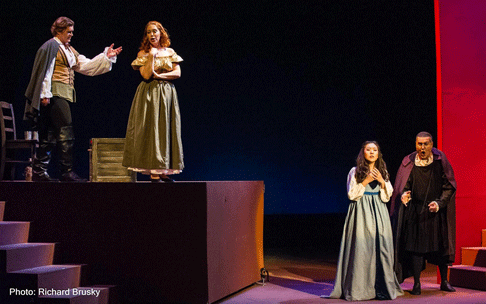 Kirk Dougherty as the Duke and Danielle Marcela Bond as Maddalena
Kirk Dougherty as the Duke and Danielle Marcela Bond as Maddalena
Chioldi, a most convincing Rigoletto, was a man in psychological pain from the begining of the opera. His fear and his vulnerability to the whims of the nobility were evident in every meaty, well-colored phrase he sang. His sweet innocent daughter was his only joy, so when she was harmed he had nothing left. In his second act aria, “Cortigiana, vil razza dannata,” he lashed out at the courtiers with fiery tones that could have brought on his arrest, but he finished by revealing his heartbreak over the abduction of his daughter.
Kirk Dougherty was a robust Duke, both vocally and physically. A young, rich, athletic member of the nobility, no law could come between this character and pleasure. Onlookers could understand how he managed to fascinate Gilda. His Duke sang with brilliant, energetic tones that helped make the rendition of the famous quartet a delight. Having paced his performance well, he still had plenty of voice left for the final round of “La donna è mobile” that told Rigoletto the Duke was still alive.
So Young Park has all the technical skills Gilda demands and in this performance she combined them with the utmost in artistry. She sang her “Caro nome” with total clarity, liquid phrasing and a long trill that crowned the scene with tonal beauty. Park has a complete arsenal of coloratura skills that is hard to match.
A proud noble who had been condemned to death for having confronted Mantua’s most powerful duke, Eugene Richards was a commanding Count Monterone with a well-burnished bass-baritone voice. Bass Rubin Casas was a mean and evil Sparafucile who had no compunction about killing a nobleman. He simply said his fee was higher for a duke. He sang with rich dark sounds that helped evoke interest in his character.
Emily Stephenson and Michael Parham as the Count and Countess Ceprano, along with Marco Varela as Borsa and Travis Lewis as Marullo, filled out the Mantuan Court's vocal riches. Stephanie Sadownik was a mendacious Giovanna and Danielle Marcelle Bond gave a fine rendition of Maddalena’s low-lying phrases.
Conductor Gregory Buchalter had a small group of instrumentalists to work with, but he drew a fine blend of Verdian sound from them. Together, they captured the work’s melodic greatness and its essential dramatic points, from its intense beginning and the forward motion of its many bright scenes to its culmination in darkness and death.
Maria Nockin
Cast and production information:
Conductor, Gregory Buchalter; Director, Cynthia Stokes; Duke of Mantua, Kirk Dougherty; Borsa, Marco Varela; Countess Ceprano, Emily Stephenson; Count Ceprano; Michael Parham; Marullo, Travis Lewis; Rigoletto, Michael Chioldi; Monterone, Eugene Richards; Sparafucile, Rubin Casas; Maddalena, his sister, Danielle Marcelle Bond; Gilda, So Young Park; Giovanna, her nurse, Stephanie Sadownik; Chorus Master Joseph Svendson; Set Design, Lily Bartenstein; Lighting, Ginny Adams; Costumes, Stephen dell’ Avesano @ Tri-Cities Opera.
image=http://www.operatoday.com/Rigoletto_Vegas_01.png
image_description=Michael Chioldi as Rigoletto [Photo by Richard Brusky]
product=yes
product_title=A Traditional Rigoletto in Las Vegas
product_by=A review by Maria Nockin
product_id=Above: Michael Chioldi as Rigoletto [Photos by Richard Brusky]
Thumbprint, An Amazing Woman Leaves an Indelible Mark
The opera, Thumbprint, originated with a play called Seven, a documentary work first performed in 2008 at New York City’s Ninety-Second Street “Y.” Seven tells the stories of seven women around the world who fought for the rights and wellbeing of women and girls. Susan Yankovich told of Mukhtar Mai, a Pakistani survivor of gang rape, who became a campaigner for women's education and won a 2006 Global Leadership Award.
Beth Morrison of Beth Morrison Projects suggested that Yankovich make her section of the play into an opera libretto for Indian-American composer Kamala Sankaram. Beth Morrison Projects commissioned Thumbprint as a song cycle that was first heard in 2009. As an opera, it received its world premiere in New York in 2014 and its West Coast premiere on Thursday, June 15, 2017. This reporter saw the first Los Angeles performance of Thumbprint as part of Los Angeles Opera’s “Off Grand” series performed at the REDCAT Theater.
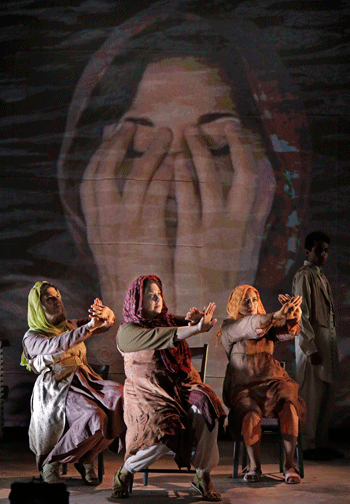 Phyllis Pancella (Mother), Kamala Sankaram (Mukhtar Mai) and Leela Subramaniam (Annu)
Phyllis Pancella (Mother), Kamala Sankaram (Mukhtar Mai) and Leela Subramaniam (Annu)
Indian-American composer Kamala Sankaram wrote a strong score for this opera. Her music is powered by short rhythmic phrases that drive it forward and undergird it with dramatic force. A singer herself, Sankaram wrote fine ensembles as well as arias and her music utilized the most colorful parts of each artist’s range. With soprano Leela Subramaniam as Annu singing above her and mezzo-soprano Phyllis Pancella as the Mother singing below her, Sankaram’s Mukhtar begins her story as a charming young girl in a loving family. When Mukhtar’s twelve-year-old brother was accused of a sexual offense, she volunteered to apologize for him. Her apology was not accepted and she was physically assaulted. Sankaram’s music, which had been delightfully decorated by the flute, then lost its light hearted charm to become stark and dramatic.
Sankaram's exquisitely colorful score gave Music Director Samuel McCoy six players to accompany the singers: percussionist Brian Shankar Adler, bass player Greg Chudzik, pianist and harmonium player Mila Henry, flutist Margaret Lancaster, violinist Andie Springer, and violist Philippa Thompson. Although they were few in number, they presented Sankaram’s fascinating and repetitive fusion of Western and Indian music with ever increasing intensity.
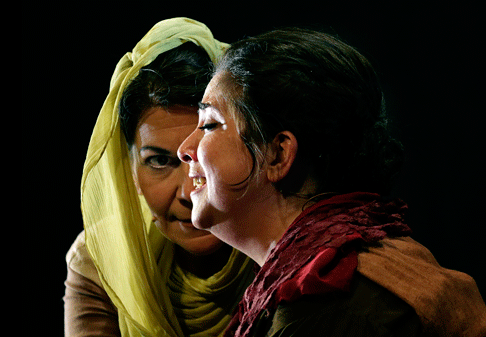 Kamala Sankaram (front) as Mukhtar Mai, with Phyllis Pancella (Mother)
Kamala Sankaram (front) as Mukhtar Mai, with Phyllis Pancella (Mother)
Director Rachael Dickstein, Scenic Designer Susan Zeeman Rogers, and the video designers of Automatic Release showed Mukhtar’s road to social redemption both on a screen and as a route around the stage. She walked across rectangular platforms that were also used to represent home furniture, a desk in a police station and the dock of a Pakistani Court. Kate Fry’s colorful Pakistani costumes featured long pants under full skirts and headscarves with intriguing designs for the women. The men wore light weight long shirts over slim pants.
Thumbprint is a dramatic piece in which the voices convey a story rather than concentrate on aural beauty. Sankaram, Subramaniam, and Pancella colored their tones so that they told of the events in Mukhtar's life with sound as well as words. Tenor Steve Gokool’s bright, powerful voice was the perfect foil for actor Manu Naroyan’s evil characters, while Kannan Vasudevan’s aptly created smaller characterizations filled out the roster of villagers. Although there were no supertitles and some words were hard to understand, Dickstein made sure that no member of the audience missed Mukhtar’s message.
At the end of the performance there was a Talk-Back at which the opera’s heroine, Mukhtar Mai, was present. Through a translator, she told us that her attackers were free on appeal and would probably never serve time in prison. She has put together a foundation, however, that provides education and support for women in Pakistan. She noted that little by little the tide is turning as village women begin to realize they have the power within themselves to ameliorate their situation.
Maria Nockin
Cast and production information:
Composer, Kamala Sankaram; Librettist, Susan Yankowitz; Creative Producer, Beth Morrison; Director, Rachel Dickstein; Music Director, Samuel McCoy; Lighting Design, Jeanette Oi-Suk Yew; Scenic and Object Design, Susan Zeeman Rogers; Costume Design, Kate Fry; Mukhtar, Kamala Sankaram; Mother, Minister of Justice, and other roles, Phyllis Pancella; Father, Judge, and other roles, Steve Gokool; Faiz, Police Chief, and other roles, Manu Narayan; Abdul, Shakur, Imam, other roles, Kannan Vasudevan; Annu and other roles; Leela Subramaniam.
image=http://www.operatoday.com/thumbprint-0613-01.png
image_description=Kamala Sankaram as Mukhtar Mai [Photo by Larry Ho]
product=yes
product_title=Thumbprint, An Amazing Woman Leaves an Indelible Mark
product_by=A review by Maria Nockin
product_id=Above: Kamala Sankaram as Mukhtar Mai [Photos by Larry Ho]
June 23, 2017
Kaufmann's first Otello: Royal Opera House, London
Iago’s gesture of vehement vexation opens the drama with the shattering of a symbol of deception and artifice that complements Iago’s masking of his ‘self’ - ‘I am not what I am’. Then, at the close of Act 2, Otello is confronted by a mirror which reflects back at him a masked figure. Finally, prone and emasculated, following a seizure brought on by Iago’s ‘proof’ of his wife’s unfaithfulness, the Moor is himself wreathed with this mask by his puppet-master. But, the destruction of this theatrical adornment at the start of the opera reminds us, too, that Iago’s iniquity will be exposed, as Shakespeare’s Iago himself foresees: ‘when my outward action doth demonstrate/ The native act and figure of my heart … I will wear my heart upon my sleeve/ For daws to peck at’.
Moreover, in placing Iago, rather than the eponymous Moor, centre-stage in the initial moments, Warner foregrounds an equality of dramatic status which mirrors Shakespeare’s text. Iago speaks by far the greater number of lines and it is his compelling soliloquies which make the audience almost complicit in the villain’s stratagems. And, in a letter to Boito, Verdi described Iago as ‘the Demon who moves everything’, noting that ‘Otello is the one who acts: he loves, is jealous, kills and kills himself.’ Despite Otello’s titular status, in Warner’s production Jonas Kaufmann’s introspective Moor and Marco Vratogna’s vengeful ensign are equal participants in the tragic unfolding, in a production which embraces the protagonists within a strong ensemble.
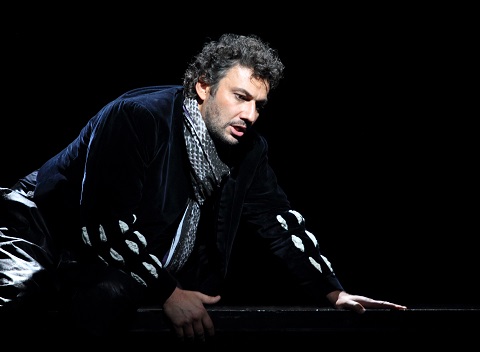 Jonas Kaufmann (Otello). Photo credit: Catherine Ashmore.
Jonas Kaufmann (Otello). Photo credit: Catherine Ashmore.
That said, it was undoubtedly Kaufmann whom the multi-national audience had come to see. And, tackling the role for the first time, he did not disappoint. Otello’s fairly low tessitura suits Kaufmann’s tenor which has baritonal resonances and he was pretty fearless in approach, holding nothing back vocally at the challenging peaks. Otello’s fears were passionately exclaimed in ‘Ora e per sempre addio sante memorie’; in contrast, ‘Dio mi potevi scagliar’ was distressingly meditative - often the barest whisper conveyed wistful introspection - though perhaps lacking a full palette of colour. Kaufmann’s Act 1 duet, ‘Già nella notte densa s'estingue ogni clamor’, with Maria Agresta’s Desdemona was particularly beautiful, though in general I wasn’t entirely convinced by the chemistry between the doomed lovers; here, as they narrated the tale of their courtship, their desires seemed aroused as much by their own vocal mellifluousness as by their memories of romance and adventure.
Kaufmann’s Otello is no commanding hero, though. His ‘Esultate!’ is not a thunderous entrance that would silence a storm; rather, this Otello surfaces within the crowd, though the victor’s cry rings with bright strength. Moreover, if he does not convey imposing ascendancy then neither is Kaufmann’s Otello petulant, despite the fact that Boito has his ‘hero’ repeatedly burst into rage. Indeed, the brevity and orchestral power of our introduction to Otello suggests that, in Verdi’s eyes at least, he is a figure of more than simply military might and physical power.
Boito and Verdi have created not a ‘noble savage’ - whom Shakespeare’s contemporaries might have considered overcome by his innate bestial sensuality (and Kaufmann is not blacked up, which is unproblematic given that Boito does not draw much attention to the Moor’s race and colour) - but a man of solipsistic susceptibility, which Kaufmann’s quiet anguish captures perfectly. His fragile pianissimos become an apt representation of the linguistic fragmentation of the text’s ‘Othello music’, as the grandiose imagery of ‘Olympus-high’ oceans ruptures into stuttering banality - ‘ Pish! Noses, ears, and lips.’ Verdi cannot disrupt the beauty of the vocal line in the way that Shakespeare deconstructs the linguistic metre and syntax, and so, in this way, Kaufmann’s reticence becomes almost a rhetorical strategy.
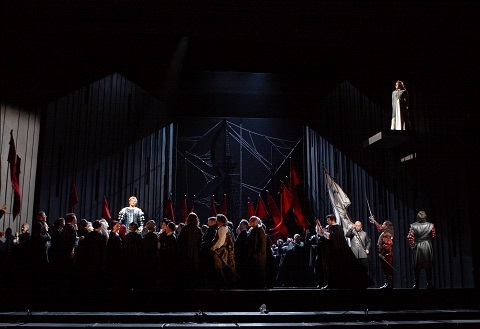 Photo credit: Catherine Ashmore.
Photo credit: Catherine Ashmore.
And, it is a strategy echoed in Boris Kudlička’s minimalist designs which profess Warner to be more concerned with the internal than the external workings of the drama. The walls of Kudlička’s ‘black box’ slide inwards, their trellis-tracery allowing figures to eavesdrop furtively, while also elegantly referencing Moorish filigree lanterns. We are presented with a psychological chamber in which we seem to explore what Melanie Klein termed ‘projective identification’: that is, the projection onto others of feelings that inspire suffering or thrill within a subject. If we view the opera in this way (as Richard Rusbridger does in his article in the International Journal of Psychoanalysis , February 2013), Warner’s opening gesture identifies the storm with the emotional turmoil in Iago’s mind, and not, as in Shakespeare’s play, the ensuing breakdown of natural, civil and domestic order.
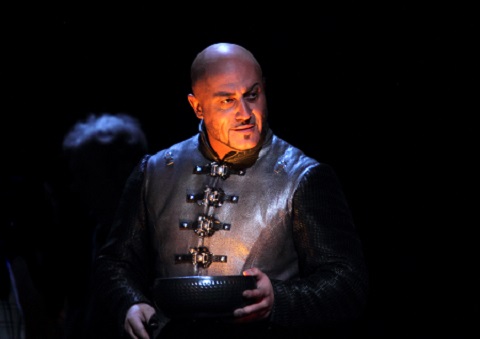 Marco Vratogna (Iago). Photo credit: Catherine Ashmore.
Marco Vratogna (Iago). Photo credit: Catherine Ashmore.
Indeed, Marco Vratogna’s Iago is undoubtedly hellbent on Hades. There is nothing clandestine about his malignity, though I’d suggest that in fact a little more serpentine slipperiness would not go amiss: after all, his ‘honesty’ as perceived by those around him, must be credible. Vratogna has a strong upper register - such as can provide propelling drive in the Brindisi - but his occasional hoarseness fittingly reminds us that Iago is a rough soldier, whose coarseness may have inclined Otello to promote the more urbane Cassio to be his lieutenant. That said, Vratogna’s light-breathed insinuations floated into Othello’s ear with the elegance of a lover’s discourse.
If Iago is ‘the Devil’, rejecting God in his Credo - ‘I believe that the righteous man is a mocking actor both in his face and in his heart, that all in him is a lie, tear, kiss, glance, sacrifice and honour’ - then Desdemona is his antithesis, an angel of saintliness, whose innocence and grace Iago is driven to violently expunge. There is little of Shakespeare’s playfulness or feistiness in Boito’s characterisation. Maria Agresta, often pushed to the hinterlands of the production, until the final scenes, sings with a rhapsodic lustre and fullness of tone that perhaps betrays a sensuality less than innocent, but her Willow Song and Ave Maria are composed and restrained, an acceptance of the inevitable and a welcoming of the hereafter.
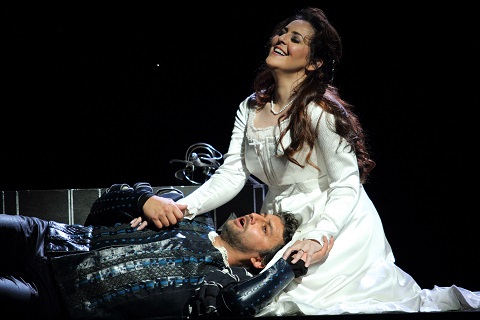 Jonas Kaufmann (Otello) and Maria Agresta (Desdemona). Photo credit: Catherine Ashmore.
Jonas Kaufmann (Otello) and Maria Agresta (Desdemona). Photo credit: Catherine Ashmore.
The rest of the cast are by no means ‘secondary’. Frédéric Antoun’s Cassio is elegantly persuasive but Iago’s duet with Cassio in Act 3 highlights the latter’s narcissism and superficiality. Thomas Atkins’ Roderigo and Kai Rüütel’s Emilia are finely drawn. A sense of Venetian grandeur is offered by Sung Sim’s noble Lodovico and Simon Shibambu’s courtly Montano.
Pappano conjures blazing intensity from the ROH players. Not everything is precise, but there is a visceral quality to both the orchestral and choral climaxes which is countered by subtleties such as the string sonorities of the Prelude to Act 3.
Warner’s vision does stumble at times: the arrival of the masted ship and the extending of the high gangplank for Desdemona’s disembarking lack refinement; the shattering of the winged lion seems cliched; and, perhaps because there is a focus on the interior rather than the exterior, some of the movement blocking, excepting the Chorus, is uninventive.
But, Iago’s greatest masterstroke is respected. He can literally turn white into black: ‘So will I turn her virtue into pitch,/And out of her own goodness make the net/ That shall enmesh them all.’
And, so, in the final moments, the ‘black box’, inflamed by Bruno Poet’s illumination, is made to contain a snow-white pearl - the white-upon-white canvas of Desdemona’s doom. The sumptuous bed is, perhaps inevitably, smeared with a painter’s flourish of red blood. This serves as a visual emblem of the tragedy’s catalyst and its conclusion (but the neon ‘halo’ is superfluous, surely?). For, it is the strawberry-spotted handkerchief which is Iago’s prime tool of deception and it is this antique token of affection which subsequently serves as an agent of truth, exposing his iniquity. Thus, it is, paradoxically, a delicate symbol of overpowering destiny. As Othello despairs, ‘Who can control his fate?’
Claire Seymour
Verdi: Otello
Otello - Jonas Kaufmann, Desdemona - Maria Agresta, Iago - Marco Vratogna, Cassio - Frédéric Antoun, Roderigo - Thomas Atkins, Emilia - Kai Rüütel, Montano - Simon Shibambu, Lodovico - In Sung Sim, Herald - Thomas Barnard; Director - Keith Warner, Conductor - Antonio Pappano, Set designer - Boris Kudlička, Costume designer - Kaspar Glarner, Lighting designer - Bruno Poet, Movement director - Michael Barry, Fight director - Ran Arthur Braun, Royal Opera Chorus (Concert Master - Vasko Vassilev), Orchestra of the Royal Opera House.
Royal Opera House, Covent Garden, London; Wednesday 21st June 2017.
Image=http://www.operatoday.com/2796ashm_0914%20JONAS%20KAUFMANN%20AS%20OTELLO%2C%20MARCO%20VRATOGNA%20AS%20IAGO%20%28C%29%20ROH.%20PHOTO%20BY%20CATHERINE%20ASHMORE.jpg image_description=Otello, Royal Opera House, Covent Garden product=yes product_title=Otello, Royal Opera House, Covent Garden product_by=A review by Claire Seymour product_id=Above: Jonas Kaufmann and Marco VratognaPhoto credit: Catherine Ashmore
June 22, 2017
Don Carlo in Marseille
Metteur en scène Charles Roubaud is nearly synonymous with the Opéra de Marseille, having initiated his opera career there in 1986 (an acclaimed Don Quichotte, seen in San Francisco in 1989). This Don Carlo is his 20th mise en scène for Marseille.
Roubaud is a minimalist. Eschewing all metaphor he favors image. Thus in recent stagings he has made much use of video washes projected onto substantial, abstract architectural shapes. His stagings occur in abstract ambience rather than specific locale. For this Don Carlo he was joined by long term collaborators, Avignon based set designer Emmanuelle Favre and Marseille based costume designer Katia Duflot. The video designer was Virgile Koering (of Montpellier origins).
Roubaud is also a conceptualist, imagining Verdi’s auto de fé spectacle as a relatively intimate court encounter between father and son, overseen by church and state, courtiers were lined up as observers. Finally he imagined a video procession of Flemish youth marching to their martyrdom. Nothing more.
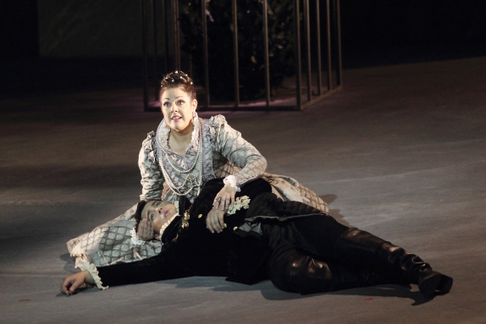 Yolanda Auyanet as Elisabetta, Teodor Llincal as Don Carlo
Yolanda Auyanet as Elisabetta, Teodor Llincal as Don Carlo
Based on intimacy and privacy such conceptual simplicity informed every scene. Don Carlo lay supine at the feet of Elisabetta for much of their fraught, post Fontainebleau encounter (this was the 4 act version). Eboli lay supine at the feet of Elisabetta to confess her betrayal. Every scene deployed its actors in abstract, emotionally charged positions, or abstract, strategically defined positioning rather than in active dramatic encounter.
Roubaud’s found Verdi’s theater not in Schiller’s drama, but in the expansion and implied collision of emotional worlds. Thus the theatrical climax fell onto the string of four huge arias that cap Verdi’s opera. Philip II’s Ella giammai, m’amò, Eboli’s “O don fatal,” Posa’s “Per me giunto è il di supreme, Elisabetta’s “Tu che le vanità conosce” riveted us to the complexity and richness of existentially separate human worlds. Roubaud made Verdi’s theater not in dramatic encounter but in the discovery and definition of these coexisting worlds.
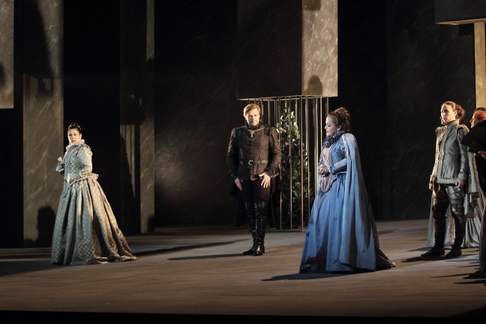 Yolanda Auyanet as Elisabetta, Jean-François Lapointe as Rodrigo, Sonia Ganassi as Eboli, Carine Sechaye as Tebaldo
Yolanda Auyanet as Elisabetta, Jean-François Lapointe as Rodrigo, Sonia Ganassi as Eboli, Carine Sechaye as Tebaldo
This concentration was only possible with the complicity of the pit. Conductor Lawrence Foster found Verdi’s empathy with his tormented souls, and allowed it to expand and elaborate without boundary. Dramatic moments were indeed pointed, but only to extend possibility of amplitude and expansion of the existential moment.
With such an operatic poetic occurring simultaneously on the stage and in the pit the historical veracity of Verdi’s actors was far less significant than the actors abilities to live the moment. And that they did without exception. If bass Nicolas Courjal is too young to be an actual Philip II, he is vocally able to find an immediacy of plight with an energy and passion that were not resignation. His was the presence and the urgency of character that declared Philip II the central force of Verdi’s opera, not its tired victim.
Jean-François Lapointe brought unusual intelligence to Marquis de Posa with a maturity of male vitality, purity of resolve and duplicity, establishing himself as the moral equal of Philip II in beautiful, powerful voice. Italian mezzo Sonia Ganassi as Eboli unleashed sophisticated, mature vocalism and Rossinian confidence (plus solid, secure high notes) to make Eboli grovel magnificently in self pity. Spanish soprano Yolanda Auyanet’s Elisabetta had the purity of voice to project marital, maternal and filial innocence and the power of character and voice to explode in her confusion.
Physically and vocally robust, Romanian tenor Teodor Ilincai established a full voiced and straight forward confidence for history’s troubled young prince. And he was well able to appropriately soften and manipulate his tone as needed, This solid Don Carlo was the powerful catalyst for Elisabetta, Eboli, Rodrigo and Philip II to achieve the epitome of great lyric theater — a seemingly infinite state of simultaneous, suspended realities.
Immobile, directly in front of a huge white light cross bass Woytek Smilek’s Grand Inquisitor assumed terrifying terrestrial authority, A 2014 Operalia winner, soprano Anaïs Constans promised celestial peace for his victims in truly heavenly voice.
Michael Milenski
Cast and production information:
Elisabetta: Yolanda Auyanet; Eboli: Sonia Ganassi; Tebaldo: Carine Sechaye; Une Voix Céleste: Anaïs Constans; Don Carlo: Teodor Ilincai; Philippe II: Nicolas Courjal; Rodrigo: Jean-François Lapointe; Le Grand Inquisiteur: Wojtek Smilek; Un Moine: Patrick Bolleire; Comte de Lerma: Éric Vignau; Députés Flamands: Guy Bonfiglio, Lionel Ddelbruyere, Jean-Marie Delpas, Alain Herriau, Anas Seguin, Michel Vaissiere; Un Araldo: Camille Tresmontant. Orchestre et Chœur de l’Opéra de Marseille. Conductor: Lawrence Foster; Mise en scène: Charles Roubaud; Scénographie: Emmanuelle Favre; Costumes Katia Duflot; Lumières: Marc Delameziere; Vidéos: Virgile Koering. Opéra de Marseille, June 17, 2017
image=http://www.operatoday.com/DonCarlo_MRS1.png
product=yes
product_title=Don Carlo in Marseille
product_by=A review by Michael Milenski
product_id=Above: Nicolas Courjal as Philip II [All photos by Christian Dresse, courtesy of the Opéra de Marseille]
June 21, 2017
Diamanda Galás: Savagery and Opulence
Now 61 years of age, the voice is as powerful, as cyclonic and ferocious as it was when I last heard her over a decade ago in Defixiones, Will and Testament. If anything, the mezzo layer of the voice is even more deeply impressive; she bevels her vocal range so masterly to the lowest mezzo F and beyond but it’s as solid as steel; you have to return to the recordings of some of the greatest Wagnerian mezzos to find comparable depth. The projection remains fabulous - though this is a voice as brilliantly and uniquely human as it is one that is filtered through microphones and some digital processing. That it never seems micro-managed, but a genuinely kaleidoscopic prism of the extremes of the human voice remains a formidable achievement (the difference being what is possible for Galás is impossible for others). Her stunning octave range remains as secure and formidably exact as before, though with that unique hard edge, like a saw against metal, that seems in part more Bel Canto than purely lyrical.
It’s only when you come to the folk song O Death (which some might know from the Coen Brothers) towards the end of the concert that the sheer vocal range and the extended techniques make an unforgettable impression. Many will never forget the thrilling sound of her floating long phrases - absolutely Straussian in their beauty - and the pyrotechnic vocal somersaults that enshrine the psychodramatic narrative that slices like a scythe through sonics crackling like a current of electricity or a semi-tuned radio. If this wrenching performance made you feel like glass is being crushed under a lethal stiletto or gravel is being fed down the throat until you howl - then it’s because that’s exactly how she sings it. There’s no question that this is still a voice that empowers women in a starkly dramatic way, though as so often is the case with this singer sentimentality is eschewed.
This concert showcased her two new albums, her first for almost a decade: All the Way, a songstress’s reworking of mid-Twentieth Century Thelonius Monk, Chet Baker, BB King and others whilst In Concert at Saint Thomas the Apostle Harlem highlights death songs from artists like Jacques Brei (Fernand) and Albert Ayler ( Angel). The two albums are strikingly different, and playing works from both in an alternative layering of them until you get a fusion of different styles proved unsettling, but inspired. The opening line of her poem Morphine (which she read so devastatingly), “There is no cure for loneliness/But itself” is in part the spiritual lacuna of these song cycles, one that has preoccupied Galás for decades. Loneliness, dispossession, death, disease are private declarations of suffering, but Galás sees them in a wider universal struggle of suffering. Mental and physical states are in decay, fragile to the extent they are at breaking point. Those who take their own life are celebrated. Galás challenges head-on the orthodox teachings of all churches and religions, even if the anguished madness and warrior-like anger at the principles of religion that guided works like Plague Mass is no longer so heavily articulated. The song Artemis, for example, is in part borne of personal tragedy - the death from AIDS of her brother, Philip, examined in her towering, ritualistic work Plague Mass - but grief is transposed into a global rite of collective tragedy that is entirely inclusive. The voice is everything here as it assaults the senses - or, as Galás herself once said: “My voice is an instrument of inspiration for my friends, and a tool of torture and destruction to my enemies”.
Likewise, the Italian poet Cesare Pavese, who hovers over some of this cycle, is an implicit point of reference, not just for the theme of loneliness but for some of the figures in this singer’s gallery of untouchables. There are the dispossessed, like prostitutes, and the isolated. When you read Pavese’s poetry the unescapable conclusion is that the loneliest of all his characters is himself, and this seems doubly true of Galás herself. Ferdinand Freiligrath, the other poetic inspiration for this cycle, gets the Galás treatment in a powerful performance of Die Stunde kommt (The Hour Comes). Freiligrath encapsulates both the exotic and the political - two Galás themes in her work - but Die Stunde kommt is co-morbid to the longer thematic reach of this cycle. Freiligrath writes of love, but also of graves and grassy cemeteries; Galás interprets it with all the monolithic darkness of the human experience.
If the death poem settings are more virtuosic, the familiar songs are given with a reshaping that is startling. This is a rebirth. The voice can be both lush and rumbling, but it can also use a vibrato that shakes like a siren. The pitch is perfect. Language is something that is torn from its linguistic roots - whether it be French, German or Greek. The irony of not necessarily understanding what she is singing needs no subtitles; her message is a universal one that is charted through the emotions of the voice. From the depths of her sepulchral mezzo through to the vertiginous, cascading high notes that pierce the ears the meaning is always apparent. It’s often noticeable that when she is thundering out bass chords on the piano the voice is flirting at the other end of the scale; likewise, when the keyboard is typed out at the higher registers, the voice is often resonant and percussive.
These albums are in some ways a move towards the past, something which Galás’s previous work doesn’t so obviously do. But the past is uncomfortable and not a place for reflection or safety. With just a piano (some of her previous concerts have been more instrumental) she cuts a lonelier figure than ever. That we can empathise with this condition and feel part of it is one of the positives from this concert. The operatic pervades it, but this isn’t opera. In the past, the theatricality of a Galás performance might have been more evident: the body swathed in blood. Today, it’s the keyboard of her piano that is more obviously streaked with the sweat, broken fingernails and blood from her hands that gives power to the staging. There are nods towards Bellinian madness, Berg’s cathartic power, or Schoenberg’s sprechgesang. But the opera singer is reinvented. Bathed in smoky light, the voice often becomes inseparable from the torch-like beams. As the voice becomes more hysterical and ecstatic light is used like Morse code. That the music can at one minute seem entirely never-ending, with those long notes floated for an eternity but not tapering off into an ending, contrasts with the ephemeral nature of the recital platform. It’s the very nature of some music, and singers, that it does indeed achieve the status of ephemerality. Whether she intends or not, Galás makes a concert unforgettable.
Marc Bridle
The Barbican, London; 19th June 2017.
Image=http://www.operatoday.com/Diamanda%20Galas%20credit%20Austin%20Young.jpg image_description=Diamanda Galás: Savagery and Opulence. product=yes product_title= Diamanda Galás: Savagery and Opulence product_by=A review by Marc Bridle product_id=Above: Diamanda GalásPhoto credit: Austin Young
Schubert Wanderer Songs - Florian Boesch, Wigmore Hall
Boesch and Martineau began at the peak, with Schubert's Der Wanderer D493, (1816 Schmidt von Lübeck). "Ich komme vom Gebirge her". A deceptively simple phrase, but delivered by Boesch with great authority, for this song is the quintessential symbol of the whole Romantic revolution. The song is itself a journey. The resolute beginning gives way to desolation, then to the short, lyrical "Wo bist du, wo bist du, mein Geliebtes Land". As Richard Stokes has written, the song "takes the form of a short cantata". Boesch's flexibility allowed him to mark the transitions clearly without sacrificing the line. In the last verse, his voice moved from firmness to despair, descending to ghostly whisper, so the last words rang out with anguished finality, connecting the last verse with the first. One of the most rewarding performances of Der Wanderer I've ever heard, and I've heard hundreds.
With its regular, repetitive lines, Der Pilgerweise D 789 (1823). can sometimes sound undistinguished, but Boesch and Martineau brought out its depths. The pilgrim is a beggar who struggles on though "Thread after thread is torn from the fabric of his happiness". So why carry on? No mention of religious faith in this text, written by Schubert's raffish friend Franz von Schober. Perhaps this pilgrim is the epitome of an artist, driven to create. He's poor but has the gift of song. Boesch coloured the words with gentleness, suggesting quiet strength. Rewarded be, those who hear the song so well interpreted.
In Der Wanderer an den Mond D870 (1826, Seidl), Martineau depicted the steady tramping pace in the piano part, over which the vocal lines float with carefree lyricism. In some ways, this song is the opposite of Der Wanderer. In the context of this programme, we were looking backwards before moving forward. I had wondered why Boesch's body language had become quite jaunty towards the end of Der Wanderer an den Mond. This fitted the upbeat mood, but also proved a good introduction to An den Mond D468 (1816,Hölty) Provocatively, Boesch spoke a few words before starting. "What's this song about? Who,is dead, the girl, or the man?" It's a curious poem, with an unidentified protagonist gazing down from the sky. Who is weeping on who's grave? A stimulating approach. There's no reason Lieder should be grim and stiff. Perhaps this was a song Schubert played in the company of friends, enjoying themselves for sheer pleasure.
Two more happy songs: Der Zufriedene D320 (!815, Reissig) and Der Weiberfreund D271 (1815, Abraham Cowley, translated Ratschky). The first concise and pointed, the second risqué. From contemporary drawings, we can assume that Liederabend audiences were open minded. Endless variety: the pious An Die Natur D372 (1815-6, Stolberg-Stolberg), with Bundeslied D258 (1815, Goethe). Schubert treats this as a drinking song, while Beethoven, setting the same text, makes connections to the drinking clubs of the time which fuelled political action. Thus Boesch and Martineau ended the set with Lacheln und Weinen DD777 (1823, Rückert). Laughter and tears - the landscape of Lieder is vast and varied.
Der Sieg D805, (1824 Mayrhofer) is an anthem, but its brave front is disguised by references to classical antiquity. The protagonist has slain the Sphinx. The song resumes in repose ("O unbewölktes Leben !") but the way Boesch sang the critical line "Und meine Hand - sie traf" haunted the peace with a sense of horror. Two songs of Spring, Frühlingsglaube D686 (1820 Uhland) and Im Frühling with An den Schlaf D447 (1816, anon) and Abendstern D 806 (1824 Mayrhofer), beautifully articulated by Boesch and Martineau.
This set of songs was balanced by the final set, with Prometheus D674 (1819 Goethe) and Grenzen der Menschheit D716 (1821 Goethe) , powerful songs which Boesch can sing with authority, all the more moving because his approach can evoke more sensitive feelings. Limitations of mankind, for men are human, not gods. Thus the unforced elegance of Boesch's An den Mind D296 (1819, Goethe and the tenderness in the two "motherhood" songs, Grablied für die Mutter D616 (1818 anon) and Die Mutter Erde D788 (1823 Stolberg-Stolberg). It's surprising that this song isn't performed more often as it exemplifies many of the themes in this Wanderer journey. The piano introduction is finely poised, suggesting slow footsteps "schwer und schwül". In the moonlight, someone is being buried. Diminuendos and a minor key, but the mood is "erhellt von sanfter Hoffnungn Schein" Mother Earth holds us all. Death does not triumph. This concert was being recorded live. If it's released, this song will be one of the highlights. Boesch and Martineau's encores were An den Mond D296 (Goethe) and Nachtviolen D752 (!824 Mayrhofer).
Anne Ozorio
image=https://upload.wikimedia.org/wikipedia/commons/thumb/b/b9/Caspar_David_Friedrich_-_Wanderer_above_the_sea_of_fog.jpg/256px-Caspar_David_Friedrich_-_Wanderer_above_the_sea_of_fog.jpg
product=yes
product_title=Franz Schubert Complete Song Series, Wigmore Hall : Florian Boesch, Malcolm Martineau, 17th June 2017
product_by=A review by Anne Ozorio
product_id=
June 19, 2017
La Bohème in San Francisco
Notably the crystalline story telling of Puccini’s sad little tale by director John Caird. Gone, well mostly gone, was his forced metaphor of life becoming art, i. e. the Paris of Marcello’s paintings (a collage) as the backdrop for Mimì’s death to become Rodolfo’s muse (blatant in his 2014 SFO staging). In its place nothing but detail, and no detail in the staging not discovered in the Puccini score — in large strokes the precise restaurant service at the Café Momu, in tiny strokes the sprinkling of water droplets to triangle tings. With this specificity director Caird found his story in the music. Marvelous even magical storytelling was the result.
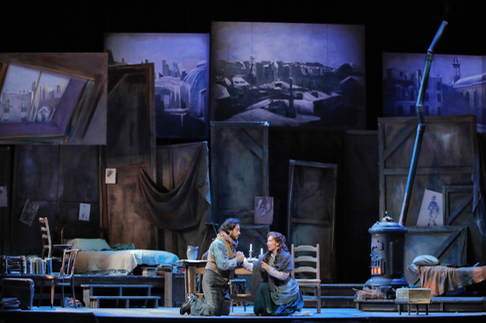 Arturo Chacón-Cruz as Rodolfo, Erika Grimaldi as Mimì
Arturo Chacón-Cruz as Rodolfo, Erika Grimaldi as Mimì
Conductor Carlo Montanaro was a skilled collaborator, providing an energetic canvas for director Caird’s realization of Puccini’s four brief vignettes of Parisian bohemian life. Montanaro’s reading vividly portrayed this Paris and its little tragedies without imposing the power of music to overwhelm their importance. His was a descriptive reading of that world, not a profound descent into its most private moments. Except, maybe, in soprano Mimì’s moving Donde lieta, splendidly delivered by Erika Grimaldi.
The masterpiece status of Puccini’s opera was resoundingly reaffirmed.
Amidst a cast that seemingly could have stepped right out of Montmartre Italian soprano Erika Grimaldi stood out as the voice of Italian opera, delivering the delights of Italian schooling (ma che scuola!). In a full, warm voice that bespoke Puccini’s Tuscan landscape she articulated language with throaty finesse and allowed her tongue ample freedom to roll and punctuate. The largest voice of the evening, well exploiting the sculpture of soaring lines la Grimaldi was indeed this Bohème — the title of the show.
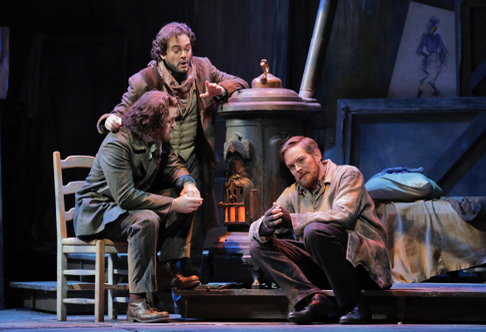 Brad Walker as Schaunard, Arturo Chacón-Cruz as Rodolfo, Scott Conner as Colline
Brad Walker as Schaunard, Arturo Chacón-Cruz as Rodolfo, Scott Conner as Colline
Mexican tenor Arturo Chacón-Cruz stretched his voice to take on Rodolfo, his lighter timbre permitting him to exploit the flow of Puccini line rather than to mimic tenorial mannerisms. His Rodolfo was youthful, charming and real. Norwegian baritone Auden Iversen was a small scale, believable Marcello, his darkly hued voice adding unexpected color and therefore an earthy reality to this mix of bohemians. American bass Scott Conner was a low affect Colline. He as well fit right into the gang, his aria to his coat sung softly and very beautifully. Adler Fellow Brad Walker made himself leader of the gang with his lively, fun and richly vocal presence.
Inexplicably cast (yet again) as Musetta Mozart soprano Ellie Denn made this vibrant Puccini character matronly in beautiful, measured tone.
Mimì’s death, the fourth vignette, slowly and softly revealed each of the bohemians coming to grips with death, making Rodolfo’s death cry a sudden recognition of finality to a magical vision of young life as art. It was indeed beautiful.
And very slick.
Michael Milenski
Cast and production information:
Mimì: Erika Grimaldi; Musetta: Ellie Dehn; Rodolfo: Arturo Chacón-Cruz; Marcello: Audun Iversen; Colline: Scott Conner; Schaunard: Brad Walker; Benoit: Dale Travis; Alcindoro: Dale Travis. San Francisco Opera Chorus and Orchestra. Conductor: Carlo Montanaro; Director: John Caird; Production Designer: David Farley; Lighting Designer: Michael James Clark. War Memorial Opera House, San Francisco, June 15, 2017.
image=http://www.operatoday.com/Boheme17_SFO1.png
product=yes
product_title=La Bohème in San Francisco
product_by=A review by Michael Milenski
product_id=Above: Erika Grimaldi [All photos by Cory Weaver, courtesy of San Francisco Opera]
A heart-rending Jenůfa at Grange Park Opera
Mitchell does away with the Czech village and its mill, and thus there is no sense of the external milieu - the living community whose disapproval and denunciation the Kostelnička so fears - to match the undeniable local colour in the score. More importantly, the religious oppression which stifles the protagonists’ lives is reduced to a token piece of iconography on a far wall. The result is that there it is not made clear how the actions and decisions, so often tragic, of the protagonists are inescapably driven by the context and community. In fact, the only hint of communal approbation comes when the Mayor’s wife (Hanna-Lisa Kirchen) dismisses Jenůfa’s understated, grey wedding-dress as unsuitably dour and inappropriate.
However, the confining walls of Mortimer’s austere 1930s kitchen certainly evoke a fitting claustrophobia, and the slanting ceiling seems further to crush down the inhabitants, much like the Kostelnička’s rigid authority. It has to be noted, though, that the lack of space inhibits the choreography of the ensemble scenes, such as Števa’s blustering arrival in Act 1 and the wedding celebrations in the final act. Act 2 tightens the psychological screw still further: hidden away by the Kostelnička, the new mother is condemned to a back room, a small black box, and the lack of decorative adornment focuses our attention on the emotional torment that afflicts all.
Welsh soprano Natalya Romaniw first came to my attention when she won the 2012 Kathleen Ferrier Competition . Since then she her rise has been steady and sure; she was an excellent Liza in Opera Holland Park’s Queen of Spades in 2016, and during the same summer performed Tatyana in Garsington’s Eugene Onegin . One of my colleagues noted Romaniw’s ‘wonderful lyrical dramatic voice’ and the ‘real sense of vibrant passion’ that she brought to the latter role - ‘you constantly felt Tatyana’s presence, whether singing or not, without ever pulling focus’ - comments that would not be out of place here. There was astonishing warmth in Romaniw’s portrayal of the hesitant peasant girl and a true sense of feeling - the fullness of Jenůfa’s desires and hopes, the veracity of her fears and doubts. In the first Act, the tone occasionally had a slightly harsh edge as she sang through the Czech text, but as she relaxed so the sound enriched. Jenůfa’s tenderness for her child, and the essential goodness conveyed through her Act 2 prayer, made her visible shock when learning of her son’s death even more intolerably tragic: ‘So he died’, she says, simply, when the Kostelnička bluntly informs her that she has lost her son. And, her terrible bereavement, at first quietly accepted, resurges with terrifying force when the dead body of the child is discovered under the ice and she recognises the tiny red cap that she knitted for him. Never has such a small motif borne an emotional weight of greater poignancy.
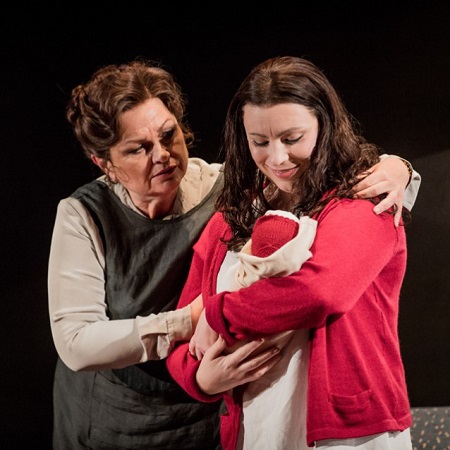 Susan Bullock (Kostelnička), Natalya Romaniw (Jenůfa). Photo credit: Robert Workman.
Susan Bullock (Kostelnička), Natalya Romaniw (Jenůfa). Photo credit: Robert Workman.
Susan Bullock is making her role debut as the Kostelnička, but it’s clear that she has a piercing appreciation of her character’s essential qualities, and how to convey them through both voice and body. Bullock is utterly convincing in communicating the sextoness’s unbending moral will, but she shows too how her own life is just as tragically constricted as the lives of those she dominates. Her love for her step-daughter is never in doubt, and her sense of damnation is palpable as she begs for Jenůfa’s forgiveness in the final Act.
In Act II she used incisive vocal inflections to take us deep into the Kostelnička’s psyche, as she formulated the words she would use to confront Števa with his moral fecklessness. And, there was a terrible irony as she envisaged the accusations that the villagers would fling at her and Jenůfa should they discover the existence of the illegitimate child, her imaginings foreshadowing the denunciation and disgrace of the final act.
The theatre has an excellent acoustic and there were a few occasions when Nicky Spence, a brazenly irresponsible Števa, and Peter Hoare, a dark and tense Laca, might have held back just a little. But, the soaring strength of their vocal lines conveyed enormous passion. Spence’s slightly warmer expansiveness matched the carefree profligacy of the drunken businessman, while Hoare’s intense focus imbued the veristic arioso with a blend of bitterness and love which literally, as he twisted his hands and his body shrank inwards, seemed to wrack his frame, as if he was being eaten from within by his jealousy. The utter credibility of their relationship and conflict is perhaps not surprising given that the pair are building upon their superb performances in David Alden’s production of the opera at ENO last summer.
The smaller roles were no less accomplished. Jihoon Kim was a sympathetic Mayor, Anne Marie Owens delivered Grandmother Burya’s exhortations with style, and Harry Thatcher sang with tremendous directness and agility as the mill foreman, Stárek. Eleanor Garside’s exuberant Jana - one of the village girls whom Jenůfa teaches to read, hoping that they may attain a better life - brought a welcome brightness and liveliness into the bleakness. Heather Ireson (Karolka), Alexandra Lowe (Barena), Amy Lyddon (Pastuchyna) and Jessica Robinson (Tetka) completed the fine cast and joined together to sing a beautifully sincere wedding song in the final Act.
William Lacey made sure that the BBC Concert Orchestra painted a colourful, sometimes biting, musical soundscape and if occasionally one might have wished for a little more Slavic warmth and fire this was more than made up for by the range of timbre and ceaseless energy of the playing.
Looking at the photograph in the season programme book of the state of the building site with just 83 days to go before curtain-up, it seemed incredible that we were sitting in a theatre at all, let alone enjoying such a vivid and heart-tugging performance.
There was just one ‘wrong note’: the ending. In the 1970s, one reviewer of the opera, Lindsay Browne remarked that the ending brought to mind the work of Thomas Hardy or the King Lear-Cordelia reconciliation scene, ‘for the kind of aching swell of generosity which shines forth from J’s resolution of many sorrows (Australian Sun-Herald 28 July 1974), and this doesn’t seem an inappropriate account of the experience of the final apotheosis of the opera when Laca and Jenůfa are finally reconciled.
Mitchell adds a closing scene of her own: an angelic young boy - the dead baby? - stands amid a garden of flowers and waves ambiguously (at whom?). This is at odds with hard-hitting realism of the rest of Mitchell’s production, and with the rejection of such mysticism by both the composer and the writer, Gabriel Preissová, on whose play (Její pastorkyňa; Her Foster-daughter) the libretto is based. It’s a pity, too, since this Jenůfa presents some powerfully penetrating psychological portraits.
Jenůfa continues, alongside Tosca and Die Walküre, until 8 July: https://grangeparkopera.co.uk/
Claire Seymour
Leoš Janáček: Jenůfa
Jenůfa - Natalya Romaniw, Števa - Nicky Spence, Kostelnička - Susan Bullock, Laca - Peter Hoare, Mayor - Jihoon Kim, Grandmother - Anne-Marie Owens, Starek - Harry Thatcher, Mayor’s Wife - Hanna-Liisa Kirchin, Karolka - Heather Ireson, Barena - Alexandra Lowe, Jano - Eleanor Garside, Pastuchyna - Amy Lyddon; director - Katie Mitchell, revival director - Robin Tebbutt, conductor - William Lacey, designer - Vicki Mortimer, original lighting designer - Nigel Edwards, lighting designer - Paul Keogan, original choreographer - Struan Leslie, revival choreography - Lucy Cullingford, BBC Consort Orchestra.
Grange Park Opera, West Horsley; Saturday 17th June 2017.
image= http://www.operatoday.com/Ensemble%20Jenufa%20Robert%20Workman.jpg image_description= Jenůfa , Grange Park Opera product=yes product_title= Jenůfa, Grange Park Opera product_by=A review by Claire Seymour product_id=Above: Grange Park Opera, ensemblePhoto credit: Robert Workman
June 18, 2017
Pelléas et Mélisande at Garsington Opera
Piper’s intricate set fuses the antique with the modern and embraces Maeterlinck’s allegory with the meticulousness of a pre-Raphaelite painter. The designer captures the realism of Maeterlinck’s natural world and decadent decay as well as the symbolic blindness of his text. The result is a timeless world of fairy-tale and scenic enchantment, allied with a tangible emotional drama.
Questions are posed from the start, when Mélisande, a princess bride of Arthurian lore, trails the ash-grey, twenty-five-foot train of her white gown as she glides in rapture towards a stagnant pool. Like her tumbling knee-length hair, the train possesses an erotic energy which immediately lures the leather-clad crossbow-clutching hunter, Golaud, as he espies her crown fall into the dark waters. This Golaud, in search of a wild beast in the forest surrounding the castle of the kingdom of Allemonde, might have wandered in from a Brothers Grimm tale. Mélisande is fearful, almost hysterical - “Don't touch me! Or I'll throw myself in the water!” - but sensing the strength of her will, Golaud is disconcerted and drawn. “Where do you belong? Where were you born?” Golaud asks. In these opening moments, Boyd effectively introduces this sensuous figure into an ambiguous narrative, establishing the opera’s tragic entwinement of loneliness and introspection with female beauty and sexual longing.
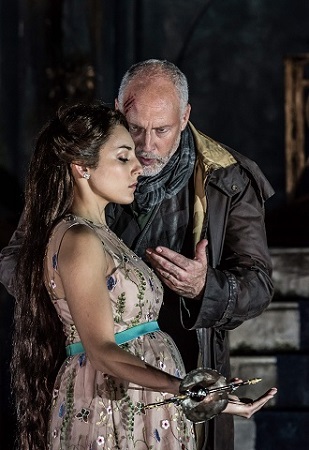 Andrea Carroll (Mélisande) Paul Gay (Golaud). Photo credit: Clive Barda.
Andrea Carroll (Mélisande) Paul Gay (Golaud). Photo credit: Clive Barda.
Piper’s set is a huge arching ‘cave’ which enfolds and encloses multiple terrains: a crumbling Gothic castle with a central curving stairwell rising to a decaying balcony and medieval turret; the mossy bank beside the Blind Man’s Well; the beggars’ hovel whose three inhabitants so alarm Mélisande; and, dangling aloft, the treacherous ladders that lead to the vaults where Golaud will test Pelléas’ resolve in the face of the stench of death.
Paradoxically, alongside such gloomy subterranean terrains, the blue ‘ceiling’ of the cave also evokes a world outside - the night sky, the seashell grotto where Mélisande professes to have lost her wedding ring - and glimpses of light through the panels in the decrepit castle doors foreshadow the final moments of the opera, when Mélisande will demand that the doors be opened so that she can watch the magical sunset over the sea, a symbolic reflection of her own fate.
Malcolm Rippeth’s delicate lighting offers unusual spotlights which do not always fall where we might expect, highlighting the tarnished gold of fractured balustrades, the foul vapour mistily swirling above the pool. Contrasting with the dark corners spotted with shifting shadows there is some brightness with the stately entrances of the aging, infirm Arkel and his entourage, the latter confirming the shroud of courtly romance which envelops the work.
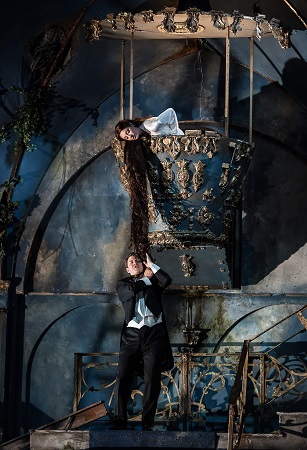 Jonathan McGovern and Andrea Carroll in title roles. Photo credit: Clive Barda.
Jonathan McGovern and Andrea Carroll in title roles. Photo credit: Clive Barda.
This was a night of tremendous debuts at Garsington for the eponymous pair of hesitant lovers. Jonathan McGovern has a lovely brightness at the top of his baritone which captured all of Pelléas’ youthful ardency, aspiration and doubt. The striking qualities that I admired back in 2011, when reviewing a recital at the Wigmore Hall , have ripened wonderfully and McGovern has developed flexibility alongside vigour and greater variety of colour. This is not his first essay at the role and he has built fruitfully on the experience garnered with English Touring Opera in 2015. The baritone’s declaration of love, before he is killed by Golaud, had a power as penetrating as the uncontrollable ecstasy that Pelléas experiences beneath the turret from which Mélisande unfurls her hair. While the French text was not always perfectly enunciated, McGovern used the fragmented phrases to reveal - for example, in the scene where he waits of Mélisande to arrive so that they might flee - all of Pelléas’ contradictions and delusions. Given that the role falls too low for many tenors and often taxes baritones at the top this could become a signature role for McGovern.
American soprano Andrea Carroll only recently completed two years as a member of the Houston Grand Opera Studio, but she has now been snapped up by the Vienna State Opera whose ensemble she has joined, and one can see why. Carroll has a vibrant, gleaming soprano which is particularly rich in the lower register. She articulated Debussy’s melodic fragments with utter naturalness, allying crystalline purity with vocal strength; moreover, she shaped the phrases superbly, guided by the rise and fall of Maeterlinck’s childlike French prose. Carroll’s vocal and physical beauty gave Mélisande a presence which was all-pervading. Joseph Kerman may have found Mélisande ‘exasperating … a mysterious, beautiful young creature who suffers quietly, asks nothing, and never acts’, but while there was no doubting this Melisande’s suffering - the Lady of Shalott’s lament, ‘I am half-sick of shadows’, never seemed more pertinent - Carroll conveyed not only her timidity but also her impulsiveness and her playful coquetry. Her mystery was duplicitous but there were also striking moments of truthfulness: as she sang her unaccompanied song, while combing her hair at the turret window, Mélisande seemed to step out of time, detaching herself from the dark drama which unfolded around her.
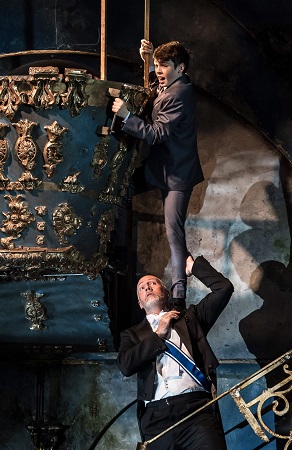 William Davies (Yniold), Paul Gay (Golaud). Photo credit: Clive Barda.
William Davies (Yniold), Paul Gay (Golaud). Photo credit: Clive Barda.
Paul Gay was vocally less secure, finding the upper lying lines difficult to control at times, but he conveyed all of Golaud’s contradictory, self-torturing qualities: his sullen moroseness, his immature violence, his agonised love, his tenderness for his son Yniold. In the scene in which he tries, in desperation, to force the boy - who is on the cusp of understanding - prematurely into the deceit and betrayal of the adult world was intensely moving. Faced with the disintegration of his world, at his own hands, Golaud’s passion breaks him, and Gay’s delivery of the unstable phrases with their rapid accelerations and jerking rhythms was tortured and tragic.
William Davies’ Yniold was a more significant presence in the drama than is often the case, as he played innocently with his golden ball which, though it hung like a moon-lantern, offered the protagonists no illumination. Inevitably the treble’s words did not always come across, but the purity of tone was a breath of freshness and serenity within the prevailing murky confusion and growing darkness.
Scottish bass Brian Bannatyne-Scott captured the fading health and status of King Arkel while retaining his nobility, but did not quite convey the poignancy of the role. Susan Bickley was a perfectly dignified consort in regal purple, as his wife Geneviève, although her account of the happier past might have had more sense of nostalgic regret for what has been lost. Dingle Yandell as the Doctor and Joseph Padfield as the Shepherd completed the fine cast.
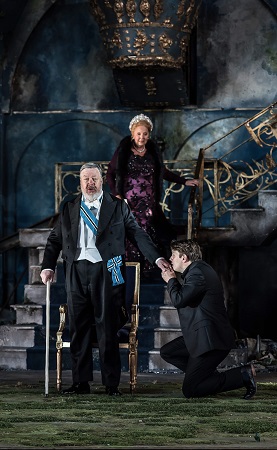 Brian Bannatyne-Scott (Arkel), Susan Bickley (Geneviève), Jonathan McGovern (Pelléas). Photo credit: Clive Barda.
Brian Bannatyne-Scott (Arkel), Susan Bickley (Geneviève), Jonathan McGovern (Pelléas). Photo credit: Clive Barda.
Garsington have just begun a five-year collaboration with the Philharmonia Orchestra and this was a fortuitous opera with which to open that partnership, for the players are fresh from their Aix-en-Provence performances of the work last summer. Under Jac van Steen’s baton the Philharmonic created exquisite soundscapes in the orchestral interludes and punctuated the vocal lines adroitly. Van Steen went for a less-is-more approach, and it worked well; he refrained from overt emotionalism and let the score speak, and there was a keen sense of unity and consistency between instrumental and vocal lines.
The details of Debussy’s music-painting were gorgeously crafted: the throbbing oboe that accompanies the dejected Golaud in the forest; the fateful chiming of the clarinet when Pelléas presses Mélisande to tell Golaud the truth about her lost ring, whose fall into the unreachable depths of the well is conjured by slithering harp glissandi; the tense, short crescendos for the lower strings, bassoon and timpani which depict the closing of the castle gates.
The pervasive secrecy of Debussy’s opera was preserved in Bond’s hands but he also suggested that the mysteries are more contradictory than we might at first imagine, the desires both more aimless and more complex. Boulez remarked that, ‘The real difficulty in interpreting Pelléas is to avoid both pointlessly heroic gestures and rhetorical attitudes on the one hand and timidity and “safe” understatement on the other.’ In this magical, troubling production, Boyd and Piper manage both to tell the (fairy-)tale and protect its intangibility.
Claire Seymour
Debussy: Pelléas et Mélisande
Pelléas - Jonathan McGovern, Mélisande - Andrea Carroll, Golaud - Paul Gay, Arkel - Brian Bannatyne-Scott, Geneviève - Susan Bickley, Yniold - William Davies, Doctor - Dingle Yandell, Shepherd - Joseph Padfield; Director - Michael Boyd, Conductor - Jac van Steen, Designer - Tom Piper, Lighting Designer - Malcolm Rippeth, Movement Director - Liz Ranken.
Garsington Opera, Wormsley; Friday 16th June 2017.
image=http://www.operatoday.com/Garsington%20Opera%202017%20Pelle%CC%81as%20et%20Me%CC%81lisande%20Andrea%20Carroll%20%28M%C3%A9lisande%29%20credit%20Clive%20Barda.jpg image_description=Pelléas et Mélisande, Garsington Opera product=yes product_title=Pelléas et Mélisande, Garsington Opera product_by=A review by Claire Seymour product_id=Above: Andrea Carroll (Mélisande)Photo credit: Clive Barda
June 12, 2017
Carmen: The Grange Festival
Almost before the overture, the opera opened with Aicha Kossoko and Tonderai Munyevu on-stage, almost conjuring the piece from a large shawl. Throughout, Kossoko and Munyevu acted as guides and interpreters, telling us what was going on and involving themselves in the action, as if they were using magic to create the story for us. The French dialogue was stripped to the bone (in what production is it not, nowadays), with Kossoko and Munyevu adding detail and background. The disadvantage of this was that there were places where, instead of hearing the characters developing in dialogue, we were told what was happening. But this version respected Bizet's mixed use of sung passages, melodrama and pure spoken text which is one of the opera's distinctive features.
Conductor Jean-Luc Tingaud studied with Manuel Rosenthal, who himself played the violin at the Opera Comique in the 1920s and knew people who had taken part in the premiere of Carmen. Whilst the programme book credited Fritz Oeser's edition of the opera, the version used by Tingaud was admirably traditional and avoided any of Oeser's eccentricities.
In many other respects, Bizet's Carmen is a tricky opera to get right. Arden and Parker clearly understood that, on a stage the size of the Grange Festival's less is more. Parker's set was a simple textured black backdrop (only in later acts did we realise it was made up of hundreds of draped shawls), with the metal superstructure beneath being revealed at times. The playing area was articulated with platforms and ramps moved by the cast. There was very little scene setting, instead Arden used her young cast to admirable effect, this was very much about the characters and the ensemble. Arden and Parker (jointly credited with the movement) drew a highly expressive, very physical performance from the ensemble which engaged throughout. Costumes were modern-dress, loosely 1970s with standard fatigues for the soldiers.
Whilst I was not keen on the use of the two narrators, Kossoko and Munyevu, I cannot fault their performance. Elsewhere in the opera, Arden had a good feel for Bizet's distinctive stylistic mix. I enjoyed the way she brought out the musical comedy aspect of the smugglers Dancaire (Tiago Matos), Christophe Ponce de Solage (Remendado) and their girls Frasquita (Marianne Croux) and Mercedes (Filipa van Eck), without ever resorting to low comedy. Tingaud ensured that the music for these four, particularly the ensembles, was nicely pointed but things could turn nasty in an instant such as the ensemble after the card trio in Act Three, which started light but then at the end the smugglers round on Don Jose.
The Israeli mezzo-soprano Na'ama Goldman sprang to fame in 2012 when she stepped in at the last moment to sing the title role in Carmen at the Masada Festival. She made an enchanting and unhackneyed Carmen, bringing a freshness to the role. In a theatre the size of The Grange she was able to sing Carmen's solos with a beautifully shaped, unforced line, sometimes reducing both musical and physical gesture down to telling details. She managed to convey Carmen's complex mix, so that the fatalism in the later acts did not come out of nowhere, and she avoided gloomy portentousness. The voice had a lightness to it, and a nice sheen, but the lower register still told.
American-Italian tenor Leonardo Capalbo is a lyric who seems to be moving into more dramatic territory. He really brought out Don Jose's neediness and sense of obsession, creating a strong portrait the character's downward spiral. Thanks to the extra information from Kossoko and Munyevu we knew that he already had gambling problems and Capalbo's Don Jose was flawed from the beginning of the action. Musically I felt that there were times when Capalbo was pushing a little against the grain of his voice. Moments like 'La fleur que tu m'avais jetée' were best when he sang with a quiet, unforced lyricism. But Don Jose is as much about character as about beauty of tone, and Capalbo showed musicality and intelligence here.
Shelley Jackson made a warmly expressive Micaela, though she seemed to take time to really find her feet. The Act One duet with Capalbo was nicely sung but did not quite achieve the sense of radiant innocence which it needs, but in Act Three Jackson really brought out Micaela's hidden reserves of strength.
The standard of sung French was a little variable, but on the whole creditable though Capalbo sometimes resorted to Italian vowels. Baritone Phillip Rhodes as Escamillo impressed because he not only sang with decent French but actually sang with elements of French style giving the music a slight nasal twang which was perfect. In this relatively small theatre, he was able to demonstrate his nicely fluid top, and decent low notes in the Toreadors song. For all the fame of the music, this is a role which can easily fall flat in the theatre, and Rhodes ensured that it didn't.
The smaller roles were all finely done, acutely avoiding caricature and seamlessly forming part of the dynamic and dramatic ensemble. Filipa van Eck and Marianne Croux made a fine pairing as Mercedes and Frasquita, creating a neat double act whilst differentiating the characters and forming a fine foil for Goldman's Carmen. Tiago Matos and Christophe Poncet de Solages caught the operetta elements of Le Dancaire and le Remendado but made it a characterful double act which never fell into hackneyed comedy. Grigory Soloviov was a handsome but dim Zuniga, whilst Toby Girling created a character out of very little with Morales.
The chorus was almost a character in its own right singing with unforced enthusiasm and engaging charm, whilst creating a very vivid dramatic atmosphere thanks to Arden and Parker's extensive movement plot. The performance took advantage of the youth of the singers to project with lively engagement.
In the pit, Jean-Luc Tingaud brought a real sense of style, drawing some nicely sophisticated performances from the Bournemouth Symphony Orchestra whilst never pushing the piece too far in the direction of either operetta or grand tragedy.
The sound design rather favoured the spoken narrators too much so that Kossoko and Munyevu seemed to be operating in a different aural world to the rest of the cast. A more naturalistic balance might have made their contributions less intrusive.
Ultimately this was quite a dark production, which respected Bizet's overall drama but brought light and shade by respecting the style and character of the music. Arden drew vivid performances from all of her ensemble, and whilst I was less enamoured of the idea of using the narrators, I cannot fault the performers for the vividness of the engagement and the strong sense of style.
Robert Hugill
Bizet: Carmen
The Grange Festival, 11 June 2017
Director: Annabel Arden, designer: Joanna Parker
Conductor: Jean-Luc Tingau, Bournemouth Symphony Orchestra
Carmen: Na’ama Goldman, Don Jose: Leonardo Capalbo, Micaela: Shelley Jackson, Escamillo: Phillip Rhodes, Mercedes: Filipa van Eck, Frasquita: Marianne Croux, Dancaire: Tiago Matos, Remendado: Christophe Poncet de Solage, Zuniga: Gregory Siloviov, Mora
Image=http://www.operatoday.com/Carmen%20The%20Grange.jpg image_description=Carmen, The Grange Festival 2017 product=yes product_title=Carmen, The Grange Festival 2017 product_by=A review by Robert Hugill product_id=Tiago Matos, Christophe Poncet de Solages, Philip Rhodes, Na'ama GoldmanPhoto credit: Robert Workman
June 11, 2017
Don Giovanni in San Francisco
Originally staged in 2011 by Italian actor and theater director Gabriele Lavia, a sometime Nicola Luisotti collaborator for opera productions in Italy and Japan, this SF production hung twenty two huge, framed mirrors that flew in and out of an empty black space. Lavia did sometimes move the action among them, but usually he simply paraded the protagonists back and forth across the front-of-stage where maestro Luisotti could keep them under his baton.
The mirror metaphor can indeed be visually effective, and it does infer all sorts of conceptual profundity. But mostly it simply reflects what is and then simply asks what it all means. Responding to this lack of content San Francisco Opera brought in an alternate director, Italian theater director Jacopo Spirei who brought with him Tommi Brem, a theatrical video designer. No longer reflections, the mirrors framed video portraits of characters of interest to whomever might be singing an aria. This was only sometimes. Usually the frames were blank.
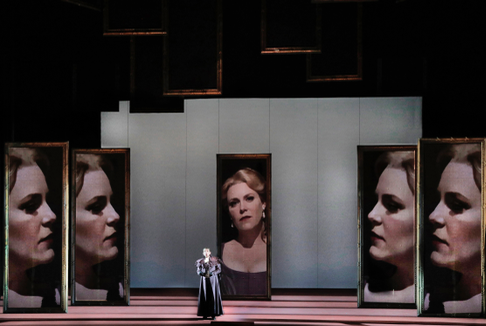 Erin Wall as Donna Anna plus Donna Anna in video image
Erin Wall as Donna Anna plus Donna Anna in video image
It all ended with the face and hands of the consumed Don Giovanni plastered on a number of frames, evidently trying to get back in. Or something.
Though Luisotti was no longer in the pit, the protagonists still crossed and re-crossed the front-of-stage pathway to sing the arias we know so well. The new conductor was Marc Minkowski, once famed as an early music conductor now general director of Opéra National de Bordeaux. Minkowski is not insensitive to what happens on stage — as example his conducting of the 2013 inebriated production of Don Giovanni at the Aix Festival was absolutely wacko. In keeping with this production however he gave us the score exactly as written, his quick, very quick tempos avoiding any exploration of the score whatsoever. And that is what was on the stage.
The splendid San Francisco Opera orchestra did indeed keep the pace, but the smooth sounds of a modern symphony orchestra do not give the bite and scratch needed to articulate the phrasing and structure of a Mozart score at such speed. Arms flailing in the overture Minkowski did indeed let us know he is a divo. His pit erected an orchestral entity that remained haughtily separate from the world of the stage — even though evidently he fully knew what was there. The finales of both acts I and II were a mess. He could not have cared.
Even so it was, after all, Don Giovanni, and there was a cast well qualified to perform the roles. Thus some of the magic of the masterpiece did shine through from time to time. All excellent singers, they were seven artists in search of a production.
Da Ponte’s characters came straight off the pages of the score, no deeper exploration at all, i.e. the production asked no questions (though no doubt these artists had many). Ildebrando D’Arcangelo, the Don Giovanni, was seductive, defeated and unrepentant. Leporello, sung by Erwin Schrott was quick, articulate and knew the score (no puns intended). Donna Anna, sung by Erin Wall, was indeed aggressed by the Don and indeed suffered, Don Ottavio, sung by Stanislas de Barbeyrac, fully understood her need of a year to recover. Donna Elvira, sung by Ana Maria Martinez, was sillily obsessed by the Don. Zerlina and Masetto, sung by Sarah Shafer and Michael Sumuel, gamely did their thing.
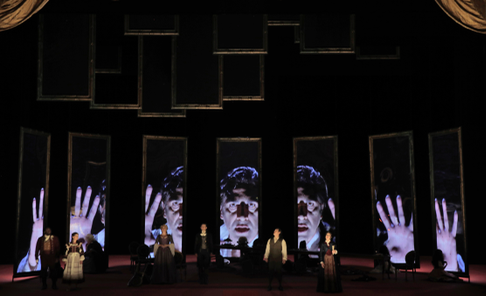 All principals in Epilogue and final video image of Don Giovanni
All principals in Epilogue and final video image of Don Giovanni
No doubt the simulcast of the opera house performance onto the score board of AT&T stadium on June 30 is the place to get the best of this Don Giovanni. On-screen opera focuses on the faces of the performers rather than on the production.
Michael Milenski
Cast and production information:
Don Giovanni: Ildebrando D’Arcangelo; Donna Anna: Erin Wall; Donna Elvira: Ana María Martínez; Leporello: Erwin Schrott; Don Ottavio: Stanislas de Barbeyrac; Zerlina: Sarah Shafer; Masetto: Michael Sumuel; Commendatore: Andrea Silvestrelli. Chorus and Orchestra of the San Francisco Opera. Conductor: Marc Minkowski; Stage Director: Jacopo Spirei; Projections and Scenic Adaptations: Tommi Brem; Costume Designer: Andrea Viotti; Lighting Designer: Gary Marder; Original Set Designer: Alessandro Camera. War Memorial Opera House, San Francisco, June 8, 2017.
image=http://www.operatoday.com/Giovanni2017_SFO1.png
product=yes
product_title=Don Giovanni in San Francisco
product_by=A review by Michael Milenski
product_id=Above:Ana Maria Martinez as Donna Elvira (Ildebrando D'Arcangelo as Don Giovanni in video image) [All photos by Cory Weaver, courtesy of San Francisco Opera]]
June 10, 2017
Dutch National Opera puts on a spellbinding Marian Vespers
Then, for close to two hours, a spellbinding ritual unfolds. This was not a wake for a Catholic notable, but Claudio Monteverdi’s 1610Vespro della Beata Vergine, conceived by director Pierre Audi as a mise-en-écoute. The premiere of this Dutch National Opera production, or rather art installation with live music, opened the 70 th edition of the Holland Festival. The corpse lying in state was Berlinde De Bruyckere’s Cripplewood (2012-2013), a huge, fractured tree trunk, made of wax and textile, the Belgian exhibit at the 2013 Art Biennale in Venice. Its raw and bandaged branches were inspired by the martyrdom of Saint Sebastian, who was tied to a tree and pierced with a volley of arrows. Audi’s solemn and understated presentation was centered around this moving contemplation on suffering and mortality.
For the occasion the Gashouder in Amsterdam, a spacious circular building for gas storage from 1902, was transformed into a cavernous crypt. The music, by conductor Raphaël Pichon and his Pygmalion baroque ensemble, was the spectacle, underlined by subtle visuals. Seats were upholstered in neutrals and pale pastels matching the bandages and ligatures of Cripplewood. The singers moved deliberately, acting as both celebrants and congregation, in monochrome clothes, from contemporary smart casual to Victorianesque. Elusive video projections on the cloth-lined walls suggested light filtered through stained glass. Curling wisps on the cast-iron ceiling of the Gashouder called up pillowy clouds in church paintings. Felice Ross lit Cripplewood in a slow dance of light and shadow – exposing its jutting bones while clothing the rest in darkness, tinting it a restful bluish-gray, or intensifying its pink stains, the color of weak blood.
The musicians occupied a slice of the stands, with the audience seated on the rest of the circle. The singers reconfigured their positions for each excerpt, in front, behind and above the public. Pichon reproduced the early baroque cori spezzati (separated choruses) by scattering the chorus across the venue. He achieved the most effective result when the singers lined themselves up in the aisles among the public, wrapping the space in surround sound. Monteverdi probably composed the Marian Vespers, together with a mass for six voices, as a job application for a prestigious appointment in either Rome or Venice. Rome did not oblige, but in 1613 he was appointed maestro di cappella at St Mark's Basilica in Venice. As such, it is not so much a single whole as a collection of parts from which a vespers service can be assembled. Pichon chose to add Gregorian chant antiphons (call and response prayers) between Monteverdi’s alternating psalms and motets, adding about twenty-five minutes to customary performances of the work. The choir sang superbly, with just the right dose of vibrato, its fresh soprano section plating their sound with silver. The first Monteverdi versicle of Deus in adiutorium was calculatedly slow. Pichon then set his style of unhurried but varying tempi in the psalm Dixit Dominus. The musicians were not always as agile as the choir, but they provided rich continuo accompaniment and enchanting string solos featuring a lira da braccio.
All eight soloists, miked by necessity, were thoroughly accomplished. However, the two female soloists achieved a higher plane of tonal beauty, both individually and in their duets. Giuseppina Bridelli’s mezzo-soprano was the fertile earth above which Eva Zaïcik’s lighter-hued voice flowered gorgeously. Having the soloists answer and echo each other high above the public created sonic magic, especially in Duo Seraphim, where two male singers echo each other’s rippling melismas, then are joined by a third when they declaim the mystery of the holy trinity. Appropriately, at the end the Magnificat, Mary’s hymn of praise at the start of her pregnancy, superseded what went before. Pichon gave it a light brilliance while maintaining the greatness of its architecture. A pensive Renaissance Madonna appeared on the wall, eyes cast down at her infant. It was as if she was envisaging his suffering, all human suffering, as attested by the mass of tortured limbs on the ground. As the staging was not connected to the text, there were no surtitles to translate the Biblical and liturgical excerpts. Regardless of how familiar people were with the words, the sound and images invited personal associations. Beauty, suffering, mystery, heaven and earth – Monteverdi’s ravishing Marian Vespers embodies all of these, as did this production. After the Magnificat Pichon added another antiphon. He then repeated the Toccata from Monteverdi’s opera L’Orfeo quoted at the beginning of the Vespers, bringing this extraordinary performance full circle.
Jenny Camilleri
Credits:
Eva Zaïcik, mezzo-soprano; Giuseppina Bridelli, mezzo-soprano; Magnus Staveland, tenor; Emiliano Gonzalez-Toro; Olivier Coiffet, tenor; Virgile Ancely, bass; Renaud Bres, bass; Geoffroy Buffiere, bass; Pierre Audi, director; Berlinde De Bruyckere, sculpture and concept scenography; Roel van Berckelaer, costumes and set design; Felice Ross, lighting design; Mirjam Devriendt, video; Jan Panis, sound. Pygmalion Choir and Orchestra; Raphaël Pichon, conductor. Seen at the Gashouder, Westergasfabriek, Amsterdam, Saturday, 3rd June, 2017.
image=http://www.operatoday.com/mariavespers0026.png image_description=Scene from Marian Vespers [Photo courtesy of Dutch National Opera] product=yes product_title=Dutch National Opera puts on a spellbinding Marian Vespers product_by=A review by Jenny Camilleri product_id=Above: Scene from Marian Vespers [Photo courtesy of Dutch National Opera]Into the Wood: A Midsummer Night's Dream at Snape Maltings
A Midsummer Night’s Dream is a felicitous choice for this year’s Aldeburgh Festival as it was the opera with which Britten opened Snape Maltings Concert Hall fifty years ago in 1967. Since then, the Maltings have burned to the ground, been reborn (in 1970), and undergone significant development while always remaining true to Britten’s vision and ethos. But, the concert hall itself, wide and lacking wings, is not the most accommodating space for opera. Jones makes a virtue of a problem, and dispenses with the usual trappings of theatre - set, props (bar a pendulous swing centre-stage), using digital projection, colour, light and movement to conjure an eerie hinterland.
The deep-blue back-screen twitches with a filigree of cobwebs, leaves as fragile as butterfly wings, and trembling droplets of dew on dandelion threads; images which echo the woods and waterfalls of John Piper’s original designs. It’s as if we are wandering through the botanical woodcuts of an Elizabethan herbal. And, with the night come bees and beetles, spiders and owls, busily spiralling or coolly perching. But, there are other visual resonances too. Velvety petals unfold and sticky stamens twitch with the sensuousness of Georgia O’Keeffe’s lilies; moreover, the exquisite detail recalls Richard Dadd’s The Fairy Feller’s Master-Stroke with its mesmerising vision of the microscopic secrets of the world sprites and spirits.
Spot-lit silhouettes mirror their subjects but, desynchronised movements also teasingly elaborate and challenge. The foliage seems to stretch out and enfold; figures drapes themselves in the leafy shadows. The disruptions of scale and distortion of perspective blur boundaries between the real and the fantastic. The overall effect is disorientating but mesmerising.
At the heart of this vision-scape is Iestyn Davies’ malevolent Oberon - a silvery portrait of, paradoxically, stillness and wrath. Like an alchemist skilled in secret arts, Oberon’s darkness is distilled in syrup of love-in-idleness, drops of which splash and infuse the sleepers’ dreams. This medic can both cure and harm, as the winding sinuousness of the snake who ‘throws her enammel’d skin’ reminds us. Davies was initially a cruel Oberon: the low range of his penetratingly precise countertenor resonated with menace. But, disembodied against his silhouette, his voice had a disturbing beauty which spoke of the fairy monarch’s passion for his estranged Queen. Touched by pity for the doting Tytania, Oberon removes the ‘hateful imperfection’ from her eyes, and as the vocal line fell once more in register, Davies’ imbued it with an expressive warmth, blending movingly with the tone-clusters in the low cellos and double basses.
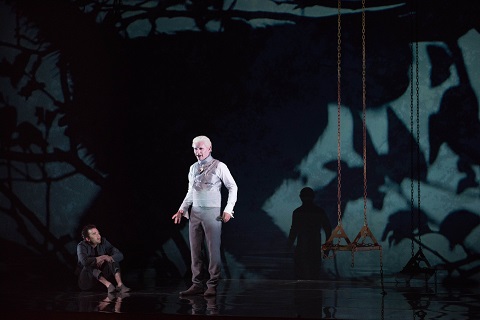 Jack Lansbury (Puck) and Iestyn Davies (Oberon). Photo credit: Hugo Glendinning.
Jack Lansbury (Puck) and Iestyn Davies (Oberon). Photo credit: Hugo Glendinning.
Like Prospero taunting Ariel, this Oberon dangles Puck on an invisible magnetic cord, spitefully tugging, pulling and twisting his goblin servant in meanness and rage. The acrobatic grace and physical responsiveness of Jack Lansbury’s lithe Puck was breath-taking; this Puck was mischievous but not malign, and his punishment - underscored by a vicious timpani roll and stabs of gong, cymbal and xylophone - emphasised the heartlessness of the imperious Oberon.
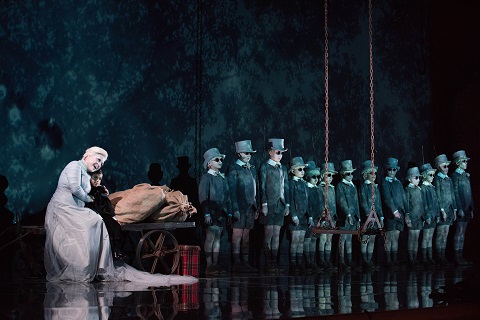 Sophie Bevan (Tytania) and the Fairies. Photo credit: Hugo Glendinning.
Sophie Bevan (Tytania) and the Fairies. Photo credit: Hugo Glendinning.
Jones’ fairy world is blanched of colour, drenched in silver light. School-boy fairies in shorts, knee-high socks and top-hats, protect their eyes with dark glasses, as they stand guard over the reposing Fairy Queen, the disputed Indian boy a tiny black-frocked figure in their midst. The boys of Chelmsford Cathedral choir sang their lilting lullabies and heralded their mistress’s beloved Bottom with purity, sweetness and strength. But, there was golden warmth, too, in the form of Sophie Bevan’s gloriously luscious soprano which had the density of bullion and the diamond-brightness of the stars. At the close of Act 1 when Tytania calls her elfin brood around her and reflects on the ‘clamorous owl’ that wonders at the ‘quaint spirits’, Bevan nailed the top C# with thrilling power, running down the octave with the elegance of Oberon’s melismatic charms. The besotted Tytania’s infatuation with the beastly Bottom was entirely credible: ‘Oh how I love thee! How I dote on thee!’ was radiantly soporific, burningly with monomaniacal passion. It was hard to know if such love was ridiculous or sublime.
Jones’ projections in the mechanicals’ scenes - a mosaic of cogs and buttons - alluded to their trades, and the rehearsals for their play were fittingly downbeat: these were a pretty dull and maladroit bunch of would-be thespians, lacking interest and energy and needing the bicycling Bottom’s coercive enthusiasm to stir them to creative endeavour. Matthew Rose was no buffoon, though his sonorous bass conveyed the weaver’s sense of his own stature and worth; even when adorned with ass’s horn and tail, and stripped to stockings and suspenders, Bottom was more a figure of pathos than of ridicule, as he executed a nifty Morris dance to the fairies’ percussive accompaniment.
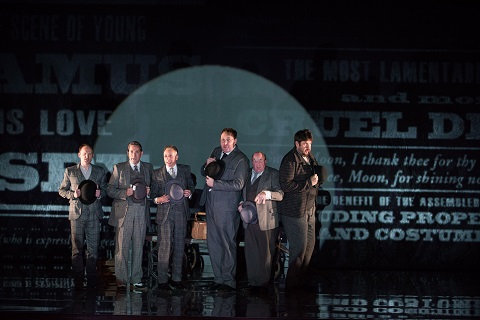 The Mechanicals. Photo credit: Hugo Glendinning.
The Mechanicals. Photo credit: Hugo Glendinning.
Act 3’s play-within-a-play is always in danger of being more ‘lamentable’ than comic, but Jones avoided too much hamming and dealt deftly with the stage ‘business’ of moonshine, walls and lions: the rustics chimed tunefully as a barbershop sextet, and though Snout (Nicholas Sharratt) and Starveling (Simon Butteriss) looked as if they might break out into ‘Brush Up Your Shakespeare’ they confined themselves to a quick toe-spin. Lawrence Wiliford’s Flute avoided too many echoes of Peter Pears’ original Joan Sutherland send-up, and Rose did not make a meal of Pyramus’ demise, adding only one extra "die", to the five expirations indicated in the libretto!
When, following a rehearsal, the mechanicals leave one of their carts behind in the wood, it provides a bed first for Lysander, then Tytania and finally for Bottom himself, thereby neatly linking three worlds. Awakening, Bottom puzzles over his experiences: it is ‘past the wit of man to say what dream it was’. Rose’s rendition of ‘Bottom’s Dream’ was a beautifully expressive climax to the opera, his bass falling with a beguiling sway through the descending thirds. Here it became clear that the weaver’s synaesthesic confusion - ‘The eye of man hath not heard, the ear of man have not seen’ - had been so perfectly embodied by Jones’ design.
In contrast to the albino fairies, the mortal lovers’ arrival is accompanied by an injection of crimson red and verdant greens, the rustling leaves shifting with sensuousness, and the striking palette complementing the richness of the blended quartet of voices. The opera’s set pieces belong to the Fairies and to Bottom though, and it was harder for the four mortals to project the text (there were no surtitles), though there was a good attempt to individualise and distinguish between the quartet of duped beloveds.
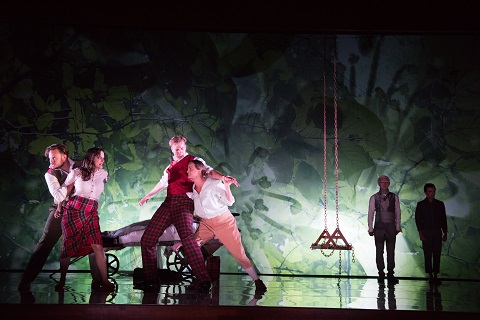 Nick Pritchard (Lysander), Clare Presland (Hermia), George Humphreys (Demetrius), Eleanor Dennis (Helena). Photo credit: Hugo Glendinning.
Nick Pritchard (Lysander), Clare Presland (Hermia), George Humphreys (Demetrius), Eleanor Dennis (Helena). Photo credit: Hugo Glendinning.
Nick Pritchard’s Lysander was earnest and his tenor had an occasional grain which deepened the characterisation, while George Humphreys’s tall, tartan-trousered Demetrius was forthright, sonorous and indignant. Clare Presland’s Hermia flashed with fire during the exchanged of insults with Eleanor Dennis’s Helena, the latter’s breeches emphasising her height advantage over the ‘dwarfish’ Hermia, and the creamy richness of her soprano winning our sympathy for the maiden spurned by Demetrius: ‘I am sick when I do look on thee’. There were some welcome dashes of humour, too, to lighten the belligerent resentment of the fairies’ feud, as when Lysander’s struggles to lift his beloved Hermia’s suitcase, as they made their escape from the oppressive Egeus, indicated that this eloper did not intend to travel light.
The shift to the courtly elegance of the final act is always something of a jolt; as if not just the characters but we too are awakening from the compelling charms of the subconscious. Jones chooses to emphasise the schism by presenting a stunning sunrise of complementary indigos and oranges which brought to mind the vivid palette of Turner’s Dawn After the Wreck. White grid lines dissect the projection, emphasising the artifice of the image - a fitting complement for Theseus’s discourse on mimesis and myth. Clive Bayley was a stentorian monarch and Leah-Marian Jones his feisty consort.
Conductor Ryan Wigglesworth gave the Aldeburgh Festival Orchestra a pretty free rein, which allowed us to enjoy Britten’s orchestral mastery: celeste and percussion were an uncanny presence during Oberon’s pronouncements, the trumpet chirruped brightly during Puck’s escapades, the harps rocked with tenderness as Tytania instructed her fairies to attend to Bottom’s every need. This is a score I know well but there were still many places where my ear was caught by a fresh detail or colour. The lethargic glissandi which penetrate the score had the deep-breathed absorption of sleepy oblivion, but the richness and urgency of Wigglesworth’s account did at times make it difficult for the singers to get the text across.
But, leaving the Maltings, bathed in the serene glow of the full midsummer moon, I felt that I had been truly bewitched.
Claire Seymour
Benjamin Britten: A Midsummer Night’s Dream
Oberon - Iestyn Davies, Tytania - Sophie Bevan, Puck - Jack Lansbury, Theseus - Clive Bayley, Hippolyta - Leah-Marian Jones, Lysander - Nick Pritchard, Demetrius - George Humphreys, Hermia -Clare Presland, Helena - Eleanor Dennis, Bottom - Matthew Rose, Quince - Andrew Shore, Flute -Lawrence Wiliford, Snug - Sion Goronwy, Snout - Nicholas Sharratt, Starveling - Simon Butteriss, Cobweb - Elliot Harding-Smith, Peaseblossom - Ewan Cacace/Angus Hampson, Mustardseed - Adam Warne, Moth - Noah Lucas, Chorus of fairies (Willis Christie, Lorenzo Facchini, Angus Foster, Nicholas Harding-Smith, Kevin Kurian, Charles Maloney-Charlton, Robert Peters, Matthew Wadey; chorus master - James Davy).
Netia Jones - direction/design/projection, Ryan Wigglesworth - conductor, Oliver Lamford -assistant director, Jenny Ogilvie - choreographer, Sam Paterson - production manager, Joe Stathers-Tracey - video technical manager, Katie Higgins & Madeleine Fry - costume supervisors, Aldeburgh Festival Orchestra.
Snape Maltings Concert Hall, Friday 9th June 2017.
image= http://www.operatoday.com/Fairy%20silhouette.jpg image_description=A Midsummer Night’s Dream, Snape Maltings, Aldeburgh Festival 2017 product=yes product_title=A Midsummer Night’s Dream, Snape Maltings, Aldeburgh Festival 2017 product_by=A review by Claire Seymour product_id=A fairy silhouettePhoto credit: Hugo Glendinning
June 7, 2017
Rigoletto in San Francisco
The two Rigoletto’s were clearly evident, that of its protagonists in the persuasive lyricism of the jester and his daughter and the Duke of Mantua, and that of its clumsy dramatic rhetoric — the curse of Monterone. British stage director Rob Kearney, working in the 20 year-old sets designed by Michael Yeargan (SFO’s current Ring among countless others), exploited Yeargan’s minimalist abstractions of neoclassic architecture and blocks of primary color to frame Verdi’s actors in abstracted, often long sustained dramatic poses when not responding to the commotion of the courtiers in detailed lazzi (commedia dell'arte staging tricks) by four dancers.
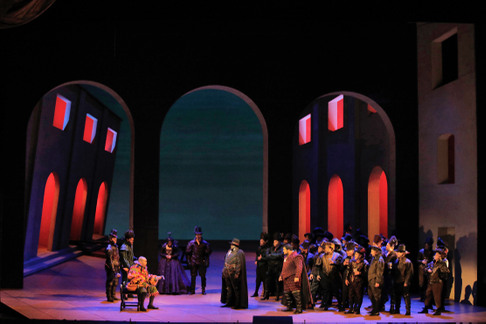
Respecting a (i.e. my) perceived Luisotti dictum director Kearney moved the action into and out of the downstage areas easily controlled by the maestro’s baton. In this splendid evening however it was evident that three powerful artists had the maestro in their thrall. This synergy created what may have been conductor Nicola Luisotti’s finest hour at San Francisco Opera as he led an impeccably measured exposition of Verdi’s early middle period opera as pure bel canto.
Beautiful singing is basic to Rigoletto as its basic emotions are beautiful and very human — the love of a father for his daughter and the freshness of youthful desire. Baritone Quinn Kelsey, once a Merola participant and then a house singer at San Francisco Opera, has matured into a formidable bel canto artist, able to discover larger and longer contours in Verdi’s musical lines and to manipulate the inherent emotion of text without breaking line. Now in his vocal prime, Kelsey possesses a strong instrument of golden tone he has placed in service to high style.
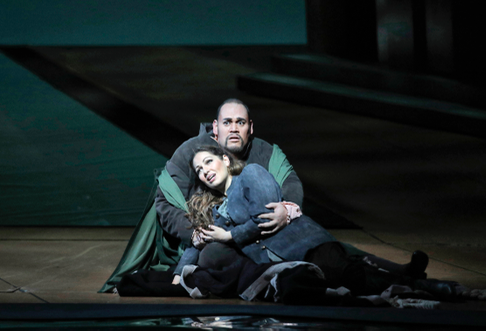 Quinn Kelsey as Rigoletto, Nino Machaidze as Gilda
Quinn Kelsey as Rigoletto, Nino Machaidze as Gilda
Soprano Nino Machaidze has a warm maturity of voice and a command of style that goes far beyond the innocence of Victor Hugo’s young victim. It was her intelligence that thrust this performance to a musical plateau where anything is possible, in this case a virtual musical embodiment of an adolescent girl gilded in magnificent sound. It was this ideal of bel canto that gave unique definition to the drama of this Rigoletto.
Ingénu tenor Pene Pati is purely and simply the vocal embodiment of the Duke of Mantua, possessing the vocal swagger, the freshness of voice, and the creative energy that makes the Duke, indeed all youth, lovable. The artistic achievement of this debut in a major role on a major stage was formidable, this young artist fusing surprisingly graceful stage movement with nearly impeccable vocal delivery. And there was solid tenorial attitude. Aplenty.
These three artists inhabited their musical worlds to the fullest. It was the collision of their worlds that created high operatic drama on the War Memorial stage, and proved, as does happen every so often, that opera is the most rarefied and distilled of all theatrical worlds.
If conductor Luisotti’s pit was devoid of all exaggeration, so was director Kearney’s stage, the melodrama of Monterone’s curse was defused by placing it always front and center and always thundering it in the voice of bass Reginald Smith, Jr. Nothing more. The fulfillment of the curse was relegated to the shadows. Andrea Silvestrelli in his signature role as Sparafucile, emerged from the darkness from time to time to realize the Monterone’s vengeance. Maddalena, sung by Adler Fellow Zanda Švēde appeared only in the dim environs of his inn and then only to satisfy the Duke’s desire. Nothing more.
San Francisco Opera resident lighting designer Gary Marder created a mottled darkness that permeated the evening, offset from time to time by saturated blocks of primary color. Mr. Marder’s lighting discovered entirely new atmospheres for this old production, atmospheres that were instrumental in upholding the intense musical level of this remarkable evening. Even the Yeargan set was swept up in the musicality, when required its elements changed position, motion seemingly initiated not by mechanics but by the sheer power of the music. Gesamtkunstwerk indeed.
Luisotti’s orchestra played with requisite finesse, the lower strings elegantly grinding gutsy drama into Rigoletto’s realization that he had been tricked, solo wind instruments suavely adding subtle feeling to arias à la Rossini. Kelsey Quinn’s “Cortegiani” acquired an unusual sophistication in tones that moved us, and moved the resplendent San Francisco Opera’s courtiers to back off, thus creating a quite powerful emotional vista — amply rewarded with prolonged applause.
Michael Milenski
Cast and production information:
Rigoletto: Quinn Kelsey; Gilda: Nino Machaidze; The Duke of Mantua: Pene Pati; Maddalena: Zanda Švēde; Sparafucile: Andrea Silvestrelli; Count Monterone: Reginald Smith, Jr.; Marullo: Andrew G. Manea; Borsa: Amitai Pati; Count Ceprano: Anthony Reed; Countess Ceprano: Amina Edris. San Francisco Opera Chorus and Orchestra. Conductor: Nicola Luisotti; Stage Director: Rob Kearley; Set Designer: Michael Yeargan; Costume Designer: Constance Hoffman; Lighting Designer: Gary Marder. War Memorial Opera House, San Francisco, June 6, 2017.
image=http://www.operatoday.com/Rigoletto17_SFO1.png
product=yes
product_title=Rigoletto in San Francisco
product_by=A review by Michael Milenski
product_id=Above: Pene Pati as the Duke of Mantua [All photos by Cory Weaver, courtesy of San Francisco Opera]
June 5, 2017
My Fair Lady at Lyric Opera of Chicago
The role of Eliza Doolittle is performed by Lisa O’Hare and that of Henry Higgins by Richard E. Grant. Additional leading parts are taken by Nicholas Le Prevost as Colonel Pickering, the colleague of Higgins, Donald Maxwell as Eliza’s father Alfred Doolittle, Brice Pinkham as the smitten Freddy Eynsford-Hill, Cindy Gold as Mrs. Pearce the housekeeper of Higgins, and Helen Carey as his mother, Mrs. Higgins. The production was created for the Théâtre du Châtelet, Paris and the Mariinsky Theatre, St. Petersburg. The original director was Robert Carsen and the revival director is Olivier Fredj. Set designs are by Tim Hatley and costume designs by Anthony Powell. The Lyric Opera Orchestra is conducted by David Chase and the Lyric Opera Chorus Master is Michael Black.
After a sprightly performance of the orchestral introduction, before and during which the words “Mea pulchra femina” appear projected on the curtain, the first scene captures immediately the social bustle of a winter’s evening outside London’s Covent Garden. While snow falls on the throngs of theater-goers searching for transportation, Freddy Eynsford-Hill collides with Eliza and upsets her flower-basket. Ms. O’Hare’s reaction as Eliza emphasizes a spunky character in keeping with her social background and present vocation. The occasional positioning of performers at stage front in this first scene initiates a technique used to good effect in later parts of this production. For now, Henry Higgins emerges from behind a pillar at stage rear once Eliza is informed anonymously that “a bloke” is writing up her “ev’ry blessed word.” Higgins’s preoccupation with his task as phonetician and his purely objective and cold devotion to a project based on human speech is well embodied by Mr. Grant. His performance of “Why can’t the English teach their children to speak?” is delivered with gusto and acerbic hauteur. One of the bystanders to whom Higgins addresses his rant on linguistic purity has, coincidentally, written on Sanskrit and traveled from India to consult with the London phonetician.
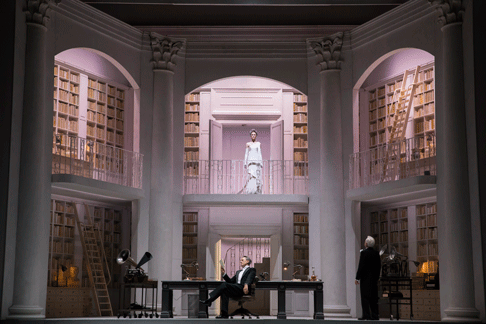
As the befuddled Colonel Pickering Mr. Le Prevost delivers his lines in character and with an appealing, dry wit. Once the two linguists become rapt in each other’s field and leave the public premise, Eliza and her cockney associates dream of the attributes of a better life in “Wouldn’t it be loverly?” The societal and linguistic differences occasioned by this series of accidents and accidental meetings persist throughout the drama, yet emotional tensions and familial relations are gradually woven into the personal involvements. As the first of these, Alfred Doolittle begs money for beer from his daughter Eliza on the following morning. Although she resents the intentions expressed with believable fervor by Mr. Maxwell’s Doolittle, Eliza’s loyalty to her father wins out and she yields him a half-crown. At the same time, this encounter prompts renewed thoughts of an improved life, and O’Hare’s character displays neatly the transition prompting her to visit the Higgins household to gain the needed talents. Since the London linguist had boasted to Pickering that he could teach her to speak properly, Eliza’s determination brings her squarely into conflict with the domestic staff of the Higgins household. As Mrs. Pearce the housekeeper Cindy Gold steals the show for now with her droll statements, at first opposing and ultimately in sympathy with the young flower-seller. Once Pickering offers to pay for Eliza’s lessons and Higgins succumbs to the temptation of transforming the girl, she is promptly established in the household. Higgins declares “I’m an ordinary man,” and this number is performed by Grant with declarative vigor in his home and, as a featured solo, immediately in front of the curtain during a change of scene. This technique, when repeated in the production, allows for smooth transitions between locales and draws the audience’s attention to the performer on the proscenium.
Once the mercenary intrusions of Eliza’s father are satisfied, the drudgery of lessons and drills becomes the focus of performers and chorus. In the following extended scene with numerous celebrated melodies from “Just You Wait” through “The Rain in Spain” the tension between protagonists intensifies against the greys and soft pastels of an upper-class interior. A droning chorus of “Poor Professor Higgins” is effectively lengthened by the stage lighting until Eliza experiences a late-night apotheosis. The choreography supporting O’Hare’s performance of “I Could Have Danced All Night” shows an ingenious use of bodily movement dependent on lyrics as Mrs. Pearce assists Eliza in changing clothes. She has now been declared ready for public display.
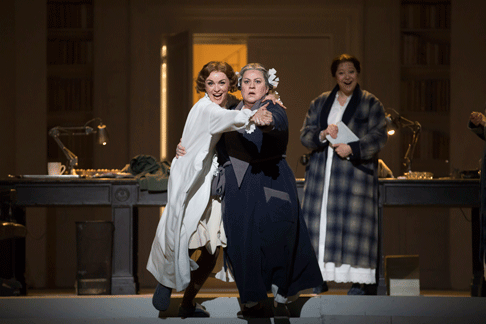
During the social event of the race at Ascot it becomes clear that Eliza’s training has been mechanically successful yet limited in achieving independent discretion. Mrs. Higgins, to whose box at the race Henry has invited Eliza, is portrayed by Ms. Carey with delightful indignation when she learns of her son’s plan. Although Mrs. Higgins advises after Eliza’s numerous social gaffs that Henry abandon his plans, Carey already reveals the humanity that will turn her into Eliza’s ally in the briefer second act. Equally impressive in this scene and its aftermath is Mr. Pinkham’s Freddy in his infatuation with Eliza’s honest display of character. Perhaps the most satisfying vocal performance of this production is Mr. Pinkham’s rendition of “On the Street Where You Live” with top pitches securely in place and effective use of rubato in lines such as
All at once, am I / several stories high.” In the following scene, the delight experienced by this Henry Higgins as they prepare to leave for the Embassy Ball in Eliza’s next outing sets him up for the shift in emotional relations in the second act.
The irony of Eliza’s success at the Embassy Ball is captured when the trio of Higgins, Pickering, and the transformed Miss Doolittle returns home from the event. After a series of self-congratulatory comments delivered by a patronizing Higgins, O’Hare’s Eliza explodes into the independence that will color her part until the conclusion of the act. Once she leaves the Higgins house and encounters Freddy still waiting outside, O’Hare’s performance of “Show Me” is essentially a fusion of the earlier flower-girl with the spirit of an enlightened woman. Her eventual return to Henry Higgins is credibly staged in this production as Grant’s final soliloquy, “I’ve Grown Accustomed to Her Face,” is recited with a sustained sense of loss. When they are again together, the request that Eliza find his slippers is now only rough on the surface.
Salvatore Calomino
image=http://www.operatoday.com/MY-FAIR-LADY_WS-35_c.Andrew-Cioffi.png
image_description=A scene from My Fair Lady [Photo by Andrew Cioffi]
product=yes
product_title=My Fair Lady at Lyric Opera of Chicago
product_by=A review by Salvatore Calomino
product_id=Above: A scene from My Fair Lady
Photos by Andrew Cioffi and Todd Rosenberg
Henze: Elegie für junge Liebende
Among the most often performed of Henze’s 14 operas is Elegy for Young Lovers (Elegie für junge Liebende), which premiered in 1961. Its popularity stems in part from the libretto by W. H. Auden and Chester Kallman, which focuses on the self-absorbed, amoral and sometimes sociopathic behavior of artists. This theme has been an obsessional threat in opera over the past century: from Béla Bartók and Paul Dukas’s Bluebeard operas to George Benjamin’s Written on Skin.
In Elegy, Auden and Kallman dissect in precise and painful detail how an artistic genus to fuels his artistic inspiration by manipulating and ultimately sacrificing his associates, friends and lovers. An imaginary Austrian writer named George Mittenhofer is spending the summer in the mountains with his entourage. In the final act, he sends a young couple, his former lover and her boyfriend (also his doctor’s son), out to die on a mountaintop—all so he can create romantic poetry about their last moments. The plot might seem unremittingly grim, yet at times the treatment borders on farce, combining comic irony and personal tragedy in the spirit of Hugo von Hofmannsthal, to whom it was dedicated.
Central to Elegy’s success is also the brilliance of its score. Henze was a rebel. Like Benjamin Brittan, the other preeminent European composer of opera in the quarter century after World War Two, he was a radical critic of traditional politics and society in his home country, embraced an alternative gay lifestyle at a time when few did so openly, spent time in exile—and rejected the prevailing musical establishment. Henze not only threw off the weighty legacy of Wagnerian romanticism, as everyone did in those decades, but rejected the then sleek and politically correct “new orthodoxy” of serialism as well.
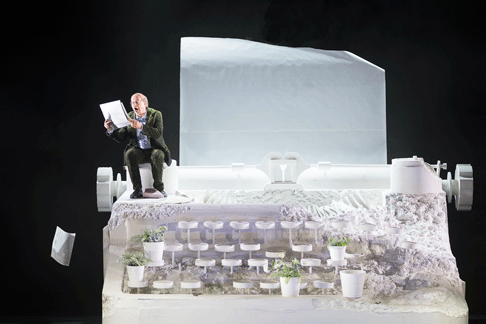 Martin Winkler (Dr. Wilhelm Reischmann)
Martin Winkler (Dr. Wilhelm Reischmann)
Yet Henze was nonetheless deeply embedded in the German and European canon. No modern opera composer was a more versatile and assured craftsman. He wove sonic tapestries from an eclectic mix of Mozart, Mahler, Brecht, Stravinsky, jazz and much more—even the serialism he abhorred. All this is held together not just by Henze’s extraordinary emotional exuberance, but also by contrapuntal virtuosity, innate lyricism, rhythmic vitality, a keen ear for timbre and other conventional musicianly virtues.
Opera offered particular fertile ground for Henze, perhaps because it disciplined his exuberance. While his massive symphonies sometimes layer clashing rhythms, timbres, tonalities and harmonies into a manic mass of sound, he scored his operas for a lucid chamber orchestra. He is careful to delicate instrumental timbres and renders almost all vocal lines intelligibly singable.
To hear Henze, there is no place like the Theater an der Wien. It is the oldest of Vienna’s three opera houses, founded in 1801 by Emanuel Schikaneder, who wrote the libretto and sang Papageno in the debut of Mozart’s Die Zauberflöte. Yet today the company bills itself as “Das neue Opernhaus” (the new opera house). It aims explicitly to present more challenging repertory and productions than the celebrated Staatsoper up the road or the Volksoper around the corner. The theater is well-suited to the task: it seats just 1000, with clear sightlines warm and clear acoustics. And in Vienna people know their opera: the house was filled for the final performance of the run, and to judge from the conversations I overheard, filled with remarkably knowledgeable spectators.
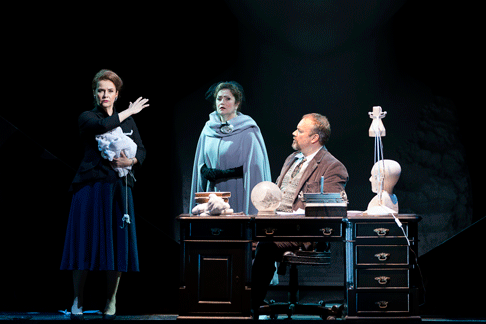 Angelika Kirchschlager (Carolina, Gräfin von Kirchstetten), Laura Aikin (Hilda Mack), Johan Reuter (Gregor Mittenhofer)
Angelika Kirchschlager (Carolina, Gräfin von Kirchstetten), Laura Aikin (Hilda Mack), Johan Reuter (Gregor Mittenhofer)
The world-class orchestra in the pit consisted of 25 players from the Wiener Symphoniker conducted by the German-born director of the Dutch National Opera, Marc Albrecht. (Albrecht comes by it honestly: his father, George Alexander Albrecht, conducted a lot of Henze.) The musicians delivered a smooth and sparking rendition of the score, with drive, virtuosity and Mozartian clarity of line: even the soloist on the musical saw played with astonishing intonation and tonal beauty.
Despite the vocal demands Henze places on them, great singers have enthusiastically embraced his operas. While it is hard to match the casts assembled for early performances of Elegy, which included Dietrich Fischer-Dieskau, Elisabeth Söderström and Martha Mödl, the Vienna cast was exceptionally strong.
The first voice one heard was that of soprano Laura Aikin in the role of Hilda Mack, the older woman whose hallucinatory ravings about her lost husband Mittenhofer had plagiarized in his poetry. Aiken is an American who has sung in Europe for some years, specializing in modern music, and one cannot imagine a more accomplished delivery of these difficult atonal intervals—surely meant as a parody of “crazy” 12-tone music.
Best-known of the cast members was Salzburg-born mezzo Angelika Kirchschlager as Carolina, the aristocratically stern yet emotionally tormented secretary to the great writer. Kirchschlager sang with warmth, expression and precision, resisting until the last moments a direct emotionality that would have been unsuited to the character.
The Danish bass-baritone Johan Reuter portrayed Mittenhofer, around whose whims the rest of the cast organizes their lives. His characterization was appropriately full-voiced, as befits someone who sings German bass-baritone roles at top houses—including Wotan in the much-discussed “Copenhagen Ring,” available on DVD. Yet one missed the absurdly juxtaposed extremes of pomp and menace that define Mittenhofer’s personality.
Innsbruck-born tenor Paul Schweinester, active in Vienna and elsewhere, and Köln-born soprano, Anna Lucia Richter, brought fresh voices to the roles of the young couple Toni and Elisabeth—and they looked the part. No wonder they are rising young singers on the European circuit. Martin Winkler, a Vienna-based singer who has performed much modern opera—I first heard him in the Metropolitan’s recent Lulu—portrayed Mittenhofer’s genially venal doctor Wilhelm Reischmann with clear diction and a firm tone.
The theater also commissioned a new production and staging from the team of Keith Warner and Es Devlin. Striking semi-abstract sets portrayed giant snow-white replicas of objects found on a writer’s desk. The opening tableau illustrates the approach: an empty black set with a white desk lamp towering dozens of feet above a woman with a bowed head and a fancy floral hat. One’s first impression—surely a deliberate analogy—was of an insect under a microscope, but when she lifted her head, she was instantly transformed into a middle-aged woman. Over the course of the evening, more giant white objects were added, with actors clambered between and over a pile of books, a reclining statue of a nude, a human head, and typewriter.
As occurs particularly often in German-speaking opera houses, the stage director and set designer occasionally went over the top. In the penultimate scene, for example, the objects (covered with white sheets) became a stormy mountaintop, over which the two doomed young lovers scrambled. This was a clever conceit, but it clashed with musical-dramatic moment, in which Henze portrays the stillness and emotional innocence of their tender farewell in deliberate juxtaposition to the artificiality and deception that surround them. Henze would surely have criticized such a directorial choice as insufficiently “music-driven”—a virtue he prized.
Similarly inappropriate was insertion of a 10-second sex scene, unsanctioned by the libretto, in which a young female dominatrix flogs Mittenhofer. It was laughably brief and clichéd. Worse, it made no dramatic sense in this context. Yes, artists can be children, but the erotic implications of this brand of self-absorbed and exploitative genius are usually the opposite. Just think Picasso.
Andrew Moravcsik
image=http://www.operatoday.com/Henze_Vienna.png image_description=Scene from Elegie für junge Liebende [Photo © Werner Kmetitsch courtesy of Theater an der Wien] product=yes product_title=Henze: Elegie für junge Liebende product_by=A review by Andrew Moravcsik product_id=Above: Scene from Elegie für junge Liebende [Photos © Werner Kmetitsch courtesy of Theater an der Wien]Werther at Manitoba Opera
Based on Goethe’s German-Romantic tale “The Sorrows of Young Werther,” and sung in French with English surtitles, the nearly three-hour production’s skeletal plot of boy meets girl; boy loses girl; boy dies is opera at its compact best. Preferring not to gild the lily with convoluted (albeit operatic) twists and turns, it delves more deeply into the hearts and minds of its ill-fated characters, underscored by Massenet’s stunningly gorgeous music brought to life by Tyrone Paterson leading the Winnipeg Symphony Orchestra.
Last appearing onstage as Tonio in MO’s 2012 production of Donizetti’s “The Daughter of the Regiment,” Edmonton-born tenor John Tessier in the title role may quite rightfully may be considered a Canadian treasure. He spun every lyrical phrase like fine gold, first heard during his opening aria “O Nature, pleine de grâce," performed with ease and capped by ringing high notes. His showstopper: “Lorsque l’enfant revient d’un voyage,” and later, a goose-bump inducing “Pourquoi me reveiller” elicited well-deserved, spontaneous applause with cries of bravo.
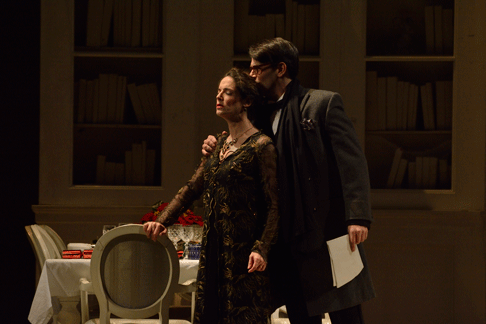 Lauren Segal (Charlotte) and Keith Phares (Albert
Lauren Segal (Charlotte) and Keith Phares (Albert
South African/Canadian mezzo-soprano Lauren Segal as Charlotte also created a flesh-and-blood “angel of duty,” with her prismatic acting skills revealing her character’s inner turmoil until her final climactic “Ah!” after Werther dies in her arms. Segal’s rich vocals also resonated during Act III’s “Va! Laisser couler mes larmes,” that grew in dramatic intensity as she realizes the poet’s path towards self-destruction.
Winnipeg-based soprano Lara Secord-Haid’s sparkling portrayal of Charlotte’s younger sister Sophie captured the impetuous optimism of youth, as she skipped and flitted about the stage with her effervescent colouratura on full display during “Du gai soleil, plein de flame.” But she also imbued her youthful character with subtle nuance, creating a fascinating sub-text for her own tragic tale of love and loss after Werther’s departure leaves her sobbing uncontrollably during Act II.
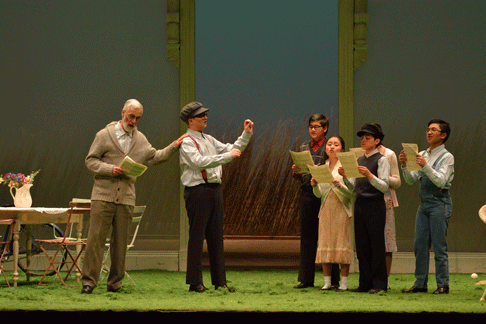 Scene from Werther
Scene from Werther
Albert performed by American baritone Keith Phares proved solid and true, besotted with his wife Charlotte, with his resonant voice clearly projecting while providing steady ballast to Werther’s eloquent arias.
The cast also includes Le Bailli performed with gravitas by baritone David Watson, and his whiskey-swilling village sidekicks, Johann (baritone Howard Rempel) and Schmidt (tenor Terence Mierau). An ensemble of six children (prepared by Carolyn Boyes) delivered a sweetly jubilant “Noel! Noel,” that heightens the dramatic tension during the final Christmas Eve scene with its twin messages of birth and death.
Having said all this, the production itself proved uneven. Hodges opted for an overall slow-burn approach to the lead characters’ respective emotional trajectories, allowing Werther’s love for Charlotte to first smolder like ashes during Act I and II, before finally erupting into flames in Act III. When the poet arrived to escort Charlotte to the dance in Act I, their first encounter came across as more polite than passionate. His understated reaction to hearing of Charlotte’s impending nuptials also did not clearly read, despite his later, angst-ridden “Un autre est son époux!"
It’s also difficult establishing a physical/emotional connection when Charlotte herself is forbidden fruit, so duty-bound she refuses to even kiss Werther until he is mortally wounded by his own hand. This created a strangely distancing effect that a few embraces – no matter how furtive – might have helped mitigate.
Still, other artistic choices were effective, including an added prologue showing the death of Charlotte’s mother. This established the opera’s overall themes, while also providing Charlotte’s motivation for remaining stonily resistant to Werther’s ardent declarations of love.
The 1920s-styled set on loan from Opéra de Montréal, with the production itself originally created by Opera Australia appeared striking in its simplicity, while also engendering fresh appeal. Nevertheless, sightlines at times became challenging, and the “big box” style of set visually dwarfed the opera’s sweeping themes of transcendent love, despite its waving grasses just beyond the formal exits that beckoned of wild nature and freedom like a siren song.
Effective lighting design by Bill Williams included a luminous moon under which Charlotte and Werther fall in love during Act I, and relatively abrupt fades during Werther’s key arias, which nevertheless focused attention on the doomed poet as he hurtled toward his own death spiral for love.
Holly Harris
image=http://www.operatoday.com/_TNK2645.png image_description=Lauren Segal (Charlotte) and John Tessier (Werther) [Photo by R. Tinker] product=yes product_title=Werther at Manitoba Opera product_by=A review by Holly Harris product_id=Above: Lauren Segal (Charlotte) and John Tessier (Werther)Photos by R. Tinker
Seattle: A seamlessly symphonic L’enfant
With its feeble libretto by an uninspired Colette, the work survives entirely due to Ravel’s extraordinary score, which creates tension and drama through almost purely musical means. I suspect that a full “realization” of the mise-en-scène specified in the printed score is almost certain to detract from the work’s power. It certainly did in my former encounters with the piece.
The SSO’s presentation employed some projections on vestigial ropelike screens and a scrim, but the best thing about them was their unobtrusiveness. Every ounce of our attention was focused on the performers.
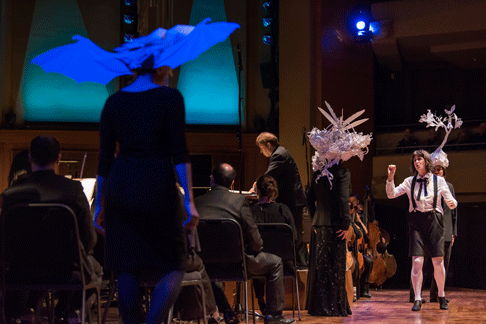
The singers in plain concert gear move with unaffected dignity among the instrumentalists in dazzlingly elaborate ivory papier-maché head-dresses, wittily suggesting their personae but leaving most of the characterization to the orchestra: the individual players were fleetingly but vividly illuminated by the spill from the singers’ follow-spots: it was enough to render them active presences Everyone of stage, from conductor to boys’ chorus, became equal participants in a common enterprise, supporting Ravel’s unexampled marvel of a score.
Conductor Ludovic Morlot came to Seattle in 2011 from Belgium’s la Monnaie; he departs again after next season, having fulfilled his mandate: to bring a capable but troubled ensemble to a new level of polish and professionalism, and to open the audience to a new kind of participation in the living orchestra repertory.
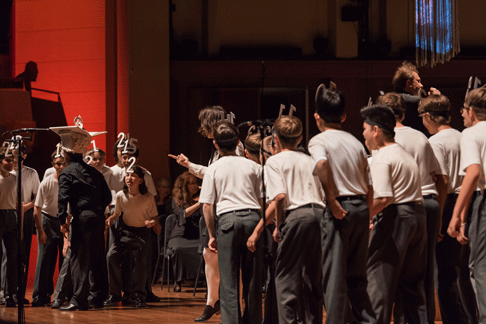
He is a fine all-round conductor; he is exceptional in his sensitivity for and dedication to 20th and 21st century French music. He will be sorely missed on the podium, but is too gifted to spend the bulk of his career with a provincial band, no matter how virtuosic. We have spent far too many years in Seattle with conductors essentially “retired in place,” to the severe detriment of imaginative music-making and orchestral morale.
Roger Downey
Cast and production information:
Michèle Losier: The Child; Delphine Haidan; (Mother, The Chinese Teacup, The Dragonfly); Rachele Gilmore: (The Fire,. The Princess, The Nightingale); Jean=Paul Fouchéfort: {The Black Wedgewood Teapot, The Little Old Man, The Frog); Allyson McHardy (The Female Cat, The Squirrel, A Shepherd); Soraya Mafi (A Shepherdess, The Bat, The Owl); Alexandre Duhamel (The Grandfather Clock, The Male Cat); Alexandre Sylvestre (The Armchair, A Tree); Northwest Boychoir (Bench, Sofa, Ottoman, Wicker Chair, Numbers); Seattle Symphony Chorale (Shepherds, Shepherdesses, Animals. Insects, Trees)
Anne Patterson, stage director & production designer; Adam Larsen, projection design; Zane Pihlstrom, head sculptures; Kina Park: associate to Ms. Patterson
image=http://www.operatoday.com/1617_concerts_ravel_opera_brandon_patoc_PREVIEW_0017.png image_description=Photo by Brandon Patoc product=yes product_title=Seattle: A seamlessly symphonic L’enfant product_by=A review by Roger Downey product_id=Photos by Brandon PatocColor and Drama in Two Choral Requiems from Post-Napoleonic France
(Brahms’s Ein deutsches Requiem is a special case: beloved, and meditating on death and consolation, but using texts directly from various books of the Bible. Other special cases include Britten’s War Requiem and Stravinsky’s Requiem Canticles.) Luigi Cherubini’s two Requiem settings (1816 and 1836) are likewise among his most-performed works, in part because of their acute responses to the Latin text. Unlike all of the aforementioned, though, they are solely for chorus and orchestra, without vocal soloists.
I was sent two CDs of Cherubini’s Requiem No. 1 in C Minor to review, and was immediately struck by how powerful and varied the work is—I hadn’t heard it in years—but also by how attitudes toward musical performance have changed in the 60-plus years that separate the two recordings.
One CD consists of the re-release of a 1952 recording, featuring the orchestra and chorus of the Santa Cecilia Society (Rome), conducted by a youngish Carlo Maria Giulini. The other is a new recording of the same work by a prominent early-music group, Le Concert Spirituel, under its longtime music director Hervé Niquet. The differences in approach are so extreme that one might be forgiven for wondering occasionally if one was hearing a different composition altogether, even though the notes are the same.
My interest in the assignment increased even further when I saw that the Niquet CD included a second setting of the Requiem text, by Charles-Henri Plantade, a composer who was contemporary with Cherubini and who, it turns out, clearly knew Cherubini’s setting.
Cherubini (1760-1842) was trained in his native Italy but spent most of his long career in Paris, writing major operas and ending up as longtime director of the Conservatoire. This C-Minor Requiem for mixed chorus and orchestra was first performed in early 1817 in the Saint-Denis basilica—soon after the beginning of the Bourbon Restoration—at a mass in memory of Louis XVI, the king who had been executed by guillotine in 1793. (The remains of the king and of his wife Marie Antoinette had been moved there the year before.) Cherubini’s C-Minor Requiem was widely performed thereafter throughout the nineteenth century. It was played at Beethoven’s funeral, Schumann and Bruckner admired and studied it, and Berlioz considered it Cherubini’s masterpiece. In his late years Cherubini wrote a second Requiem (in D minor); on that occasion he used men’s chorus and orchestra, as a response to an edict from church authorities forbidding women’s voices at funerals.
The C-Minor Requiem has had several fine recordings, e.g., by Toscanini, Muti, and Boston Baroque. Its strengths—including some subtleties of orchestration, and the marvels of the “Quam olim Abrahae” triple-fugue—have been well described by Michael Steinberg in his Choral Masterworks and by Mark Seto in the book Nineteenth-Century Choral Music (a rich compendium edited by Donna Di Grazia). Unlike some other Requiem settings, the work includes the Graduale (which begins by stating again the words of the opening, “Requiem aeternam,” but then continues differently) and also—like the Fauré Requiem decades later—the “Pie Jesu.” In 1820 Cherubini added a funeral march to open the work and an “In Paradisum” to close it. Christophe Spering included both of these wonderful pieces when he recorded the C-Minor Requiem for the Opus 111 label, and Diego Fasolis included the march but not the motet in his Naxos recording. Giulini and Niquet omit both pieces, as do most other conductors.
Cherubini has a remarkable ability to create continuity across phrases, and this comes across in nearly any decent recording, including these two. Particularly evocative are the final pages, in which (as Steinberg put it) “the chorus repeats ‘luceat eis,’ dominated by deep and solemn tolling C’s in the voices and the orchestra’s lowest and darkest instruments.”
Giulini was thirty-eight when he recorded the C-Minor Requiem. It was his first studio recording of any work. To today’s ears, the choral singing may sound a little provincial: vibrato is prominent and the frequent portamentos can border on swoops. But the contrasts of tempo and dynamics that Giulini imposes always feel motivated by the expressive point of the music and text at that moment. The CD contains only this one work and so gives short measure, ending after 51 minutes. That the Requiem lasts as long as it does derives from the very slow tempi that Giulini often adopts. Some of the tracks are nearly fifty percent longer than the equivalent track in the Niquet recording. I admit to finding Giulini’s performance quite convincing, at least when I listen to it by itself (less so in comparison). The spacious tempos certainly add seriousness and solemnity and bring out the similarities to major choral works of later composers (e.g., Gounod, Verdi, and Bruckner).
Giulini was accustomed to conducting large-scale choral works in large halls, for which large performing forces and slowish tempos were arguably appropriate or even necessary. The brisk tempos that Hervé Niquet and his period-instrument group choose would be appropriate to smaller spaces. Niquet’s recording of both works was made in the royal chapel of the chateau at Versailles. Though the chapel—with all its hard surfaces—is no doubt prone to echo, textures on the recording are very clear.
Under Niquet’s hands, the Cherubini lasts only 35 minutes. The quicker speed for the opening “Requiem” movement certainly drains the music of much of the sorrow that one hears in performances such as Giulini’s or Muti’s. Niquet also does not shape phrases in the standard (traditional/Romantic) manner, e.g., through measures-long crescendos and decrescendos. But there are wonderful compensations. The active accompanimental lines for strings (sometimes with bassoons) register more forcefully here than they do in the Giulini performance, reminding me of the similarly active presence of various sections of the orchestra throughout Cherubini’s opera Médée (or, as it is known in the inauthentic Italian version, Medea). The “Dies Irae” movement maintains great thrust and, despite the quick tempo, never sounds either routine or jaunty. Hearing Cherubini performed this way, the parallels that one draws tend to go back in time, e.g., to Haydn’s masses and oratorios, rather than ahead. Niquet adds a bit of chant before two of the movements, but the text booklet—otherwise very carefully put together—neglects to provide the words for them (nor, even more oddly, does it include the six words of the Benedictus, beautifully set by Cherubini).
Niquet completes his recording with a Requiem setting that is directly parallel to the Cherubini. Charles-Henri Plantade (1764-1839) was best admired in his lifetime as a song composer, but he also was a prominent keyboard accompanist to singers and, for some years, directed the choir at the Chapelle Royale in Paris. This Requiem setting, in D minor, was performed at a commemorative mass in 1823 in the chapel of the Tuileries palace (in Paris), the honoree being Marie Antoinette, who, like Louis XVI, was guillotined in 1793. Alexandre Dratwicki, the “scientific director” (i.e., leading scholarly authority) at the Palazzetto Bru Zane’s Center for French Romantic Music (located in Venice), brought the work to the attention of Niquet, and the Center prepared the performing parts that enabled public performances and this recording. Dratwicki’s booklet essay indicates that Plantade may have composed his D-minor Requiem earlier than 1823 but spruced it up for the occasion. The work received a lavish publication during Plantade’s day, though this apparently did not lead to many further performances.
One wonders why not, since this Requiem, like the Cherubini, requires no vocal soloists and is full of imaginative responses to the text. Plantade seems likely to have studied the Cherubini work: in both of them the tamtam is used sparingly but to well-gauged dramatic effect, and Plantade, like his predecessor, adds the Graduale movement and a Pie Jesu. In both works the lengthy Dies Irae text—all fifty-seven lines of it—is treated as a single movement, with the changing images reflected in alert shifts of mode, phrase length, orchestral figuration, and choral texture. Thus, many vivid phrases that are given extended treatment in other requiem settings (e.g., in Mozart’s and Berlioz’s “Tuba Mirum” settings or Verdi’s “Ingemisco” tenor aria) pass by rather quickly.
Dratwicki’s essay draws attention to a remarkable moaning horn solo (in Plantade’s “Pie Jesu” movement, in G minor) on the notes D-Db-D. The score specifies that the three notes be performed “open” (i.e., not stopped with the fist in the bell) and that they be slurred together. The hornist here interprets the slur, I think rightly, as indicating as eerie portamento between the notes. This short, keening solo—heard four times—suggests the soul of a dead person yearning for rest. If Berlioz knew the Plantade Requiem (perhaps from its score), he would surely have been fascinated by this moment. As is well known, in the 1830s and ’40s Berlioz would write notable wind solos that sound like offstage personae or perhaps “calls from afar”: the oboe representing an offstage shepherd in Symphonie fantastique, mvt. 3; the clarinet’s truncated statement of the idée fixe in Symphonie fantastique, mvt. 4; the flute glissando in Symphonie fantastique, mvt. 5; the shreds of tune from a clarinet in Lélio (the “Aeolian Harp” movement); and the desperate oboe phrases in the “Ride into the Abyss” in La damnation de Faust.
Other notable features of the Plantade include a choral layout that was clearly influenced by eighteenth-century French traditions: women all singing together, high tenors (hautes-contre), tenors, and basses. (Cherubini uses the standard Italianate SATB layout.) The men have a vividly stern passage—sung with grim, intentionally wiry tone—on the words “Libera animas omnium . . . de profundo lacu” (Deliver their souls . . . from the bottomless pit). At one point in the “Dies irae” movement, Plantade quotes, in full, the opening three phrases of the well-known “Dies irae” chant, harmonizing and accompanying them in his own style. The effect is as startling, in its way, as Berlioz’s and Liszt’s uses of the same tune in, respectively, the Symphonie fantastique (mvt. 5: “Dream of a Witches’ Sabbath Night”) and Totentanz (“Dance of Death”).
In both Requiem settings on this CD, I noticed a few moments where the music seems mismatched to the text. Why did Cherubini use the major mode to set the words “Mors stupebit” (i.e., even Death will be struck dumb in astonishment)? Why did Plantade create a fierce minor-mode outburst on the words “Hosanna in excelsis” (i.e., all praise to God in the highest realms) that end the Sanctus? Overall, though, these are two remarkably satisfying settings of the Requiem text, and are well worth getting to know—and, I bet, to sing!
Niquet’s chorus is small: twenty-six singers are named in the booklet. In both works, the chorus shows focused tone and excellent pitch. The performance follows many of the accepted practices of what is often nowadays called Historically Informed Performance (“HIP”). For example, the chorus gives nice biting accents to certain words and phrases. The strings play nearly without vibrato, sometimes doing a quick, “squeezed” crescendo or decrescendo on one note after another, a practice that, in many HIP recordings, can seem a mannerism but here works just fine. The tuning is lower than A=440.
One oddity: the Latin pronunciation follows the best scholarly evidence about how the language was pronounced in France during the eighteenth and early nineteenth centuries. (Crucial guidelines are provided in Sébastien de Brossard’s music dictionary of 1703.) “Jesu” is not Yeh-zoo—as in Italianate usage—but, more or less, Zhay-zyoo, and “ejus” is eh-zhyoos. Vowels followed by an “m” or “n” become nasalized, so the “m” or “n” vanishes. In this latter regard, words that sound something like cadohtt, tremodae, profodo, and sapiternam may at first—at least to the ear of someone who is not a native French-speaker—be difficult to recognize as indicating cadant, tremendae, profundo, and sempiternam. But we can learn new listening habits, right?
All in all, Niquet’s recording exudes an air of careful authenticity and highly communicative specificity, and I have grown to like it a lot, not least the determined Frenchness of the pronunciations. All too many performances nowadays—instrumental, especially, but also vocal—are devoid of regional, personalized, or closely observed period flavor. I’m delighted when a recording comes along that insists on having its own particular character, is performed at a very high level, and brings us a major work that has never been recorded before. Plus, the Cherubini—a work of high artistry—here sounds as good as it ever has, and perhaps in some ways better.
If you’re curious, you can hear excerpts from Niquet’s recording of both works here and the Kyrie from the Plantade here.
Ralph P. Locke
Ralph P. Locke is emeritus professor of musicology at the University of Rochester’s Eastman School of Music. He has written extensively on music and musical life in France and the United States, including the religious works of Hector Berlioz (in the Cambridge Companion to Berlioz, ed. Peter Bloom) and French symphonies (in The Nineteenth-Century Symphony, ed. D. Kern Holoman). The above review is a lightly revised version of one that first appeared in American Record Guide, and appears here by kind permission.
image=http://www.operatoday.com/Cherubini_Profil.png image_description=Luigi Cherubini: Requiem c-moll (Profil) product=yes product_title=Color and Drama in Two Choral Requiems from Post-Napoleonic France product_by=A review by Ralph P. Locke product_id=Profil PH16056 [CD] price=$17.99 product_url=http://www.arkivmusic.com/classical/album.jsp?album_id=2215789Der Rosenkavalier: Welsh National Opera in Cardiff
The new production debuted at the Wales Millennium Centre on Sunday 4 June 2017 conducted by Tomáš Hanus, the company's new music director, with Rebecca Evans making her role debut as the Marschallin, Lucia Cervoni as Octavian, Brindley Sherratt as Baron Ochs, Louise Alder as Sophie, and Adrian Clarke as Faninal. Designs were by Niki Turner, with lighting by Ian Jones.
Strauss and Hofmannsthal's Der Rosenkavalier is a complex theatrical mechanism which seems to defy radical re-working and Fuchs has not tried to re-invent the opera whilst still providing a way of seeing the plot anew. All the familiar details and the essential dramaturgy were there. Like many recent productions, Fuchs and Turner had set the opera in 1911, the year of its composition but the very opening showed us that this was not an entirely traditional take on the piece. During the prelude (which depicts the Marschallin and Octavian making love), we did indeed get flashes of the two characters in vigorous sexual positions, but the main focus was of an old woman, the old Marschallin (Margaret Balton), sitting remembering holding a small picture in 1949.
The old Marschallin would be present for much of Act One, and a quotation from Rilke plus the sands of time running through Turner's stripped-back yet traditional set gave us an indication that the idea of time would be important to the production. In Act Two the same essential set was partially skewed and the sands of time had started to form piles in the corners. For Act Three, the set was partially de-constructed and sand formed huge piles. The old Marschallin returned at the beginning of this act, still remembering but this time video footage seemed too evoke series of convulsive conflicts that we know would erupt between 1911 and 1949. Thankfully, this meant that the normal comic dumb-show of setting up the joke was abbreviated.
At key moments during the opera the old Marschallin (Balton) and the younger one (Rebecca Evans) seemed do interact, and it was unclear whether we were experiencing the older woman's flashbacks or the younger one's flashes of premonition, and of course during the opera the Marschallin does indeed become increasingly obsessed with time. At the very end, Fuchs allowed herself a small joke. Strauss intended the final orchestral postlude to depict the Marschallin's page Mohammed returning to the inn to find a lost handkerchief, one last jeu d'esprit. And indeed Mohammed (Kayed Mohammed-Mason) did appear but this time as an old man, still serving his mistress.
Rebecca Evans made a touching and thoughtful Marschallin, much given over to the emotions of the moment; this was a highly volatile performance with Evans beautifully reflecting the changing emotions of the text. Text was highly important, and Evans clearly was concerned to make the text as important as the music. Truly lyric soprano Marschallin's are relatively rare, and Evans performance really did make you think of Sophie grown older. Evans' voice lacks the heft to really impose itself, and occasionally I thought that Tomáš Hanus could have helped a little in the balance, but Evans never forced and sang with a profoundly beautiful sense of phrasing. This was not a luxuriant voice, instead it was touching, with Evans occasionally taking the risk to really fine her voice down to stunning effect. Clearly Evans has a long career as the Marschallin ahead of her, and this assumption was a notable achievement.
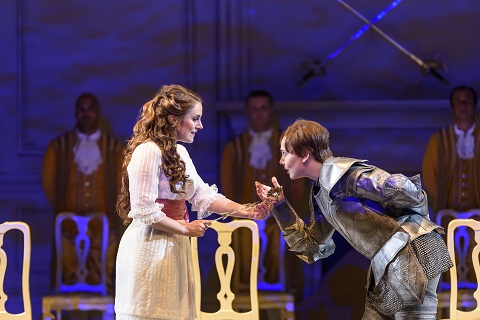 Louise Alder (Sophie von Faninal) and Lucia Cervoni (Octavian). Photo credit: Bill Cooper.
Louise Alder (Sophie von Faninal) and Lucia Cervoni (Octavian). Photo credit: Bill Cooper.
Louise Alder's Sophie was perhaps less headstrong than some we have seen recently, and Alder really conveyed the sense of Sophie still struggling to find her way in the world, sometimes bewildered sometimes angry, and somewhat confused by the sudden rush of her relationship with Octavian. Alder brought the ability to finely spin a line, but also to demonstrate a strong feel for character.
The Canadian mezzo-soprano Lucia Cervoni (a principal at Theater Magdeburg) made a nicely touchy Octavian, not a little self-obsessed and very much on his dignity. Cervoni very successfully showed the way the young man struggled both with the Marschallin's philosophising in Act One, and with the sudden rush off young love in Act Two, bringing out the sense of youthful impulsiveness. This is an opera very much defined by its relationships; Evans, Cervoni and Alder really established the sense of the different pulls in this triangle, so that when all three characters met for the first time at the end of Act Three we got a strong sense of the different tensions, with many pregnant pauses. Cervoni was successfully able to lighten her voice in the upper register so that the three women blended beautifully for a radiant final trio and duet.
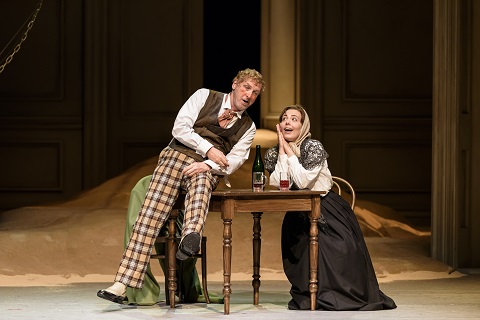 Brindley Sherratt (Baron Ochs) and Lucia Cervoni (Octavian). Photo credit: Bill Cooper.
Brindley Sherratt (Baron Ochs) and Lucia Cervoni (Octavian). Photo credit: Bill Cooper.
Into all this blunders Brindley Sherratt's comically self-obsessed Ochs. A hilarious, key moment was in his Act One scene with Evans' Marschallin when Sherratt's Ochs comically motored on with his speeches, blissfully unaware that the Marschallin was not paying him any attention. It was this blissful unawareness of other people's reactions which made Sherratt's Ochs such a comic monstrosity, his self-image never punctured until the Marschallin's biting retort at the end of Act Three.
What really brought the production alive was the constant sense of detail in the characterisation, not only had Fuchs clearly worked with her principals but these major characters were set against a welter of smaller details. In a sense this was a superb ensemble production, and this really counted when it came to providing a setting for the complex relationships between Evans, Alder, Cervoni and Sherratt's characters. Only a couple of moments seemed too generic, or jarred; Ochs retainers in Act Two could have come from a number of productions, whilst the characterisation of his son Leopold (George Newton-Fitzgerald) verged in the patronising, but overall there was a feeling of the production being vividly thought through. This was certainly helped by Niki Turner's stylish period costumes (though I would have preferred something other than cod-armour for Octavian in Act Two).
The sense of detailed characterisation paid off when combined with Tomáš Hanus superb pacing of the opera, so that the action flowed smoothly and there were few, if any, of the longeurs which can occur (particularly towards the end of Act 2). I have no idea what the exact timings were, but this felt like one of the swiftest accounts of the opera that I have heard, not because Hanus' speeds were fast but because the drama flowed and held one's attention. Even complex scenes such as the Marschallin's levée were filled with lovely little details which, rather than holding up the action, simply made the drama fall into place.
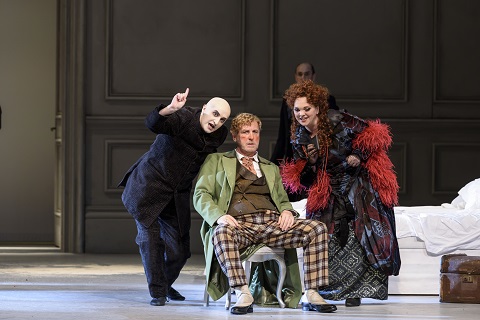 Peter van Hulle (Valzacci), Brindley Sherratt (Baron Ochs) and Madeleine Shaw (Annina). Photo credit: Bill Cooper.
Peter van Hulle (Valzacci), Brindley Sherratt (Baron Ochs) and Madeleine Shaw (Annina). Photo credit: Bill Cooper.
Providing this back-drop was a fine array of supporting characters. Adrian Clarke's Faninal was superbly characterful and his Act Two outburst made far more of a dramatic impact than often is the case. Peter Van Hulle and Madeleine Shaw as the intriguers were a delightfully over the top couple (who even got their own enthusiastic sex-scene at the opening of Act Three!). Paul Charles Clarke made a fine Italian tenor, very much obsessed with the effect he is having on his potential patron, Matthew Hargreaves was a finely upright commissar of police. Angharad Morgan's Marianne Leitmetzerin managed to combine vividness with very fine diction (which does not always happen in this role). Morgan is a member of the WNO Chorus and the production was notable for the number of chorus members in small solo roles.
This was not the most luxuriant of performances, with cast with largely lyric voices you felt that in Act One Tomáš Hanus could have been a little more aware of the balance. But Hanus had a good feel for the music's flow, keeping it moving whilst allowing a nice fluidity and giving the singers space to shape their lines. The orchestra responded well to Hanus' direction and produced a performance which finely complemented the singers in its musicality.
This was a notable achievement from the whole company, and I certainly hope that we do not have to wait too long to see the production again. WNO's new production of Der Rosenkavalier is at the Wales Millennium Centre on 10 & 17 June, and at the Birmingham Hippodrome on 1 July 2017.
Robert Hugill
Richard Strauss: Der Rosenkavalier
The Marschallin: Rebecca Evans, Old Marschallin: Margaret Baiton, Baron Ochs of Lerchenau: Brindley Sherratt, Octavian: Lucia Cervoni, Sophie; Louise Alder, Von Faninal; Adrian Clarke, Italian Singer: Paul Charles Clarke, Annina: Madeleine Shaw, Police Commissar: Matthew Hargreaves, Valzacchi: Peter Van Hulle, Mohammed: Kayed Mohamed-Mason, Marianne: Angharad Morgan, First Noble Orphan: Anitra Blaxhall, Innkeeper/Animal Trainer: Michael Clifton-Thompson, Faninal’s Major-Domo: Gareth Dafydd Morris, Boots: Laurence Cole, Footmen: Simon Crosby Buttle, Stephen Wells, Joe Roche, Laurence Cole, Third Noble Orphan: Helen Jarmany, Milliner: Emma Mary Llewellyn, Notary: Alastair Moore Marschallin’s Major-Domo: Adam Music, Second Noble Orphan: Louise Ratcliffe, Waiters: Simon Crosby Buttle, Howard Kirk, Philip Lloyd-Evans, Alastair Moore.
Director: Olivia Fuchs, Conductor: Tomáš Hanus, Assistant Conductor: Kalle Kuusava, Designer: Niki Turner.
Welsh National Opera at Wales Millennium Centre, 4 June 2017.
image=http://www.operatoday.com/wno_der_rosenkavalier_-_lucia_cervoni_octavian_rebecca_evans_the_marschallin_photo_credit_bill_cooper_0848.jpg image_description=Der Rosenkavailer, Welsh National Opera product=yes product_title=Der Rosenkavailer, Welsh National Opera product_by=A review by Robert Hugill product_id= Above: Lucia Cervoni (Octavian) and Rebecca Evans (The Marschallin)Photo credit: Bill Cooper
Don Giovanni takes to the waves at Investec Opera Holland Park
Moreover, 1930s ocean-going offered a panoply of pleasures and luxuries: the Queen Mary featured everything from indoor swimming pools and beauty salons, to libraries and outdoor tennis courts. Just the right leisured milieu for a libertine hedonist eager for a ‘good time’. Irish’s visually arresting design allows the centre of the deck to crease backwards, revealing evocations of the smoking rooms, grand salon, richly decorated with art deco details. Dramatically, too, an ocean liner seems a potentially acute setting. Britten’s Billy Budd confirms just how the claustrophobic tension can rise aboard ship, and unless he takes to a life-boat, there will certainly be no possibility of the Don escaping his pursuers mid-ocean.
But, peer a bit closer, and the rust spreading between the steel panels is disconcerting. In the event, the concept proves a bit leaky too. One problem is the strict class stratification on board: strolling on the Sun Deck, or dining in their exclusive restaurants, first-class passengers such as Donna Anna and Don Ottavio would never cross paths with the likes of Masetto and Zerlina, who would be confined in cramped third-class cubby-holes in the bowel of the ship. In fact, what are Masetto and Zerlina doing on board in the first place? They haven’t even married yet!
Two of the crucial dramatic features of Don Giovanni thus run aground on Platt’s idea. First, Don Giovanni’s ‘slipperiness’ - his ability to make himself at home amid company from any social class - is essential to his musical identity, or lack of it: for, apart from the ‘champagne aria’, Giovanni has no real aria of his own and instead adopts the musical idiom of those he is attempting to charm. But, class-crossing between the staterooms and the Starlight Club of first-class and the lower realms of steerage just wouldn’t be possible on board in the 1930s. Thus, the opera’s political radicalism is also weakened. When Don Giovanni offers to host a wedding feast for Zerlina and Masetto, he does so to deflect the latter’s jealousy, using his wealth and status to take advantage of the peasant pair. But, in Platt’s production, Giovanni comes across the wedding party when he’s wandering, implausibly, around third-class decks, and when the masked aristocrats later appear too, their cries - ‘Viva la liberté!’ - have lost their dramatic context.
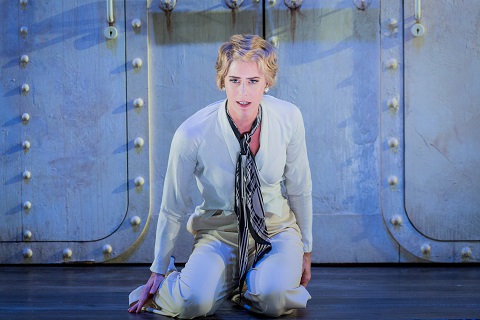 Lauren Fagan as Donna Anna. Photo credit: Robert Workman.
Lauren Fagan as Donna Anna. Photo credit: Robert Workman.
But, perhaps this is to take it all a bit too literally. One advantage of Irish’s design is that it pushes the singers to the front of the stage and reflects their voices back into the large auditorium, helping them to project across the orchestra, who are not housed in a pit. However, it does mean that there is not a lot of space for the sort of ‘stage business’ which creates both tension and humour; a case in point was Zerlina’s ‘Batti, Batti’ which seemed, in terms of the drama, rather like driftwood. At times, Platt must resort to ‘gags’ - albeit often witty - to create some energy, such as when Zerlina attempts to ‘hide’ behind the celery stalk in her cocktail glass. Elsewhere, things take an unexpectedly violent turn: there’s blood on the walls when the Commendatore is stabbed and Giovanni threatens Donna Anna with a revolver before making his end-of-Act 1 getaway.
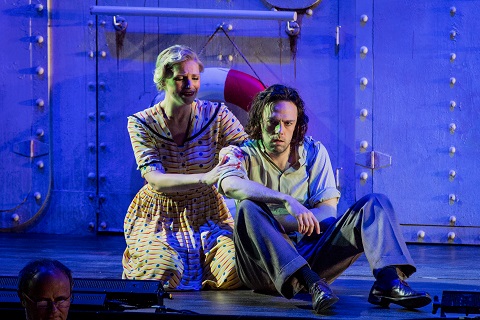 Ellie Laugharne as Zerlina and Ian Beadle as Masetto. Photo credit: Robert Workman.
Ellie Laugharne as Zerlina and Ian Beadle as Masetto. Photo credit: Robert Workman.
The centre of the stage does open up, though wisely Platt does not allow the angled rooms to recede too far. The complicated Act 1 ending is well-choreographed and a sense of intrigue is created when, in Act 2, Leporello and his master change cloaks and we zip between various cramped cabins. But, some of the set-piece arias are a little too ‘set’. Leporello literally teaches Elvira a lesson, as she sits before a blackboard and chalks up the Don’s conquests - you do the Maths, the schoolmaster seems to mock! Don Giovanni’s champagne aria is delivered as he attempts to change for dinner in a cabin which brought to mind Charles Dickens’ description of one of Cunard’s cabins as a ‘profoundly preposterous box’.
Fortunately, the talented young cast do much to stabilise the rocky vessel. As the eponymous libertine, Ashley Riches looked debonair in his light-tan sports-suit, Panama hat and two-tone shoes, and he demonstrated a vocal suavity to match in ‘Là ci darem la mano’. Riches’ tone was firm and warm throughout, cunningly veiling his contemptuousness; he had the breath control to whirl through the champagne aria, too, despite having to simultaneously squeeze into evening dress in a cupboard.
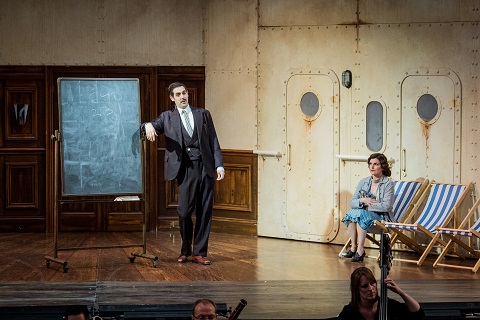 John Savournin as Leporello and Victoria Simmonds as Donna Elvira. Photo credit: Robert Workman.
John Savournin as Leporello and Victoria Simmonds as Donna Elvira. Photo credit: Robert Workman.
John Savournin was an effective partner for Riches; Savournin made Leporello more sympathetic than is sometimes the case, revealing the natural comic timing which was in evidence when I saw him perform in WNO’s Kiss Me, Kate in November last year.
Of the trio of duped women, Lauren Fagan shone brightest, as Donna Anna, injecting real drama into both recitatives and arias. The Australian’s soprano is powerful and bright, and she mastered the vocal acrobats of ‘Non mi dir’ with ease. As her consort, Ben Johnson struggled a bit with Don Ottavio’s ‘Il mio tesoro’, seeming to need a slightly broader pace than that set by conductor Dane Lam.
A year ago, I enjoyed Ellie Laugharne’s Zerlina for Classical Opera at Cadogan Hall, and she charmed with the same sweetness of tone and wicked sparkle here, forming an effective contrast with Victoria Simmonds’ fervent - sometimes quasi-hysterical - Elvira. Simmonds’ was not entirely on top of the role’s demands - the intonation strayed at the top - but this was a convincing performance dramatically. Ian Beadle (Masetto) and Graeme Broadbent (Commendatore) also gave accomplished performances. The latter’s bass had lots of colour, helping to make the vengeful patriarch a more credible figure, in the absence of a statue, after he’s spent most of the opera on a slab in the ship’s food refrigeration unit - one dreads to think what was served for dinner.
Dane Lam drew forthright playing from the City of London Sinfonia, though at times it was lacking in stylishness; the Opera Holland Park Chorus were in good voice.
Unable to conjure the fires of hell in the middle of the Atlantic, Platt has Giovanni plunge overboard and meet a watery end. Overall, there is much fine singing to enjoy in this Don Giovanni, and no doubt the cast will settle into their roles as the run progresses. But, I couldn’t help thinking that the production itself is not waving but drowning.
Claire Seymour
Mozart: Don Giovanni
Don Giovanni - Ashley Riches, Leporello - John Savournin, Donna Anna - Lauren Fagan, Don Ottavio - Ben Johnson, Donna Elvira - Victoria Simmonds, Il Commendatore - Graeme Broadbent, Zerlina - Ellie Laugharne, Masetto - Ian Beadle; Director - Oliver Platt, Conductor - Dane Lam, Designer - Neil Irish, Lighting Designer - Mark Howland, Choreographer - Caitlin Fretwell Welsh, City of London Sinfonia, Opera Holland Park Chorus.
Investec Opera Holland Park, London; Saturday 3rd June 2017.
image=http://www.operatoday.com/Ashley%20Riches%20as%20Don%20Giovanni%20with%20members%20of%20the%20principal%20cast%20and%20the%20Opera%20Holland%20Park%20Chorus.jpg image_description=Don Giovanni, Investec Opera Holland Park product=yes product_title=Don Giovanni, Investec Opera Holland Park product_by=A review by Claire Seymour product_id=Above: Ashley Riches (Don Giovanni) with members of the principal cast and OHP ChorusPhoto credit: Robert Workman
June 3, 2017
"Recreated" Figaro at Garsington delights
This production was the last production performed at Garsington Manor, in 2010, before the company’s move to Wormsley; and, in conversation recently, Garsington’s Artistic Director, Dougie Boyd - who conducted on that occasion and under whose baton the production returns to the Garsington stage - told me that the wider stage and improved technical facilities had led to changes to design and staging which encouraged Garsington to describe this as a ‘recreation’ rather than a revival. I had not seen Cox’s vision in its previous manifestation, but I found the nestled layers of Robert Perdziola’s design to be a brilliant conceit.
The shabby garret room bestowed by Count Almaviva on the soon-to-be wed Figaro and Susanna, settles into the angled corner of the Countess’s soft-silk boudoir, which itself sits snug in the walls of the Count’s portrait-lined study. Surrounding all is the garden: the pines, topiary hedges, shrubbery and terraces. Beyond that, of course, are the gardens of Wormsley, and Cox made good use of the location: not only did the one-day time scale of Figaro perfectly mirror the real-time progression to dusk and darkness, but when Cherubino leapt from the Countess’s window to evade the Count’s wrath, we witnessed his somersault over the balcony and subsequent helter-skelter dash through the Garsington grounds, towards the lake, with disgruntled, inebriate gardener, Antonio, in hot pursuit.
And, so, the trajectory of Shakespeare’s Othello - which moves from the streets of Venice to distant Cyprus, to ever more enclosed settings culminating in the private chamber where Desdemona meets her death at the hands of her jealous, duped husband - is reversed in Figaro , which progresses from inner rooms, first private then of state, to external nooks and crannies of intrigue and deception. And, this is emphasised by Cox’s staging and Perdziola’s set, in which, paradoxically, the rings of the onion are peeled away, thus taking us ever further from the domestic interior.
The individual spaces were each well utilised, too. Though Figaro’s attic bedchamber was somewhat cramped, crowded with upturned boxes and bed-frames, a step ladder at the rear enabled supernumeraries and principals alike to climb up, creating an impression of space and an opportunity to project. The vista widened for the Countess’s boudoir, with the towering window and terrace beyond further extending the stage-scope stage-left, and the swivelling periaktoi stage-right exposing the Countess’s closet for our delectation when first Cherubino and then Susanna were therein concealed. Into the Count’s study trouped Marcellina, Bartolo and various notaries and maid-servants during Act 3, bringing the outside world to the Count’s private domain. And, in Act 4, the expanse of the Garsington stage created a credible garden milieu, with all its nooks, crannies and caves which facilitate the domestic intrigue.
The production also showcased Garsington’s values and ethos, with several significant roles filled by returnees and those who had planted the roots of their careers in Garsington’s figurative musical gardens. This was baritone Joshua Bloom’s fourth season at Garsington; he made his debut here in La Cenerentola in 2009, and sang Leporello in the 2012 Don Giovanni. Here, he was a wonderfully controlled and methodically crafted Figaro, his huge vocal capacity never once overwhelming his musical intellect. When challenging the Count’s proprietorial assumptions, Bloom’s voice was indignantly resonant; but when, in Act 4, Figaro believed himself duped and betrayed, Figaro was endowed with a credible vulnerability, which tempered Bloom’s sturdy baritone. Bloom has presence, panache and vocal power: a winning triplet.
Soprano Jennifer France is returning to Garsington following her role debut as Marzelline in Fidelio in 2014 (when Bloom was Don Fernandez) for which she was awarded the prestigious Leonard Ingrams Foundation Award for outstanding young artists. ‘Outstanding’ is certainly an adjective I would use to describe her Susanna on this occasion. This Susanna is a feisty lass - verbally and physically - not beholden or subordinate to husband, mistress or master; but, her fierce will and self-belief never once temper the sweetness of her vocal utterances. France’s soprano is lithe, clean and her stamina unflagging; she was as bright and brisk in the final Act as in the first. She is also a consummate actress, adaptable, relaxed and vivacious. A star in the making.
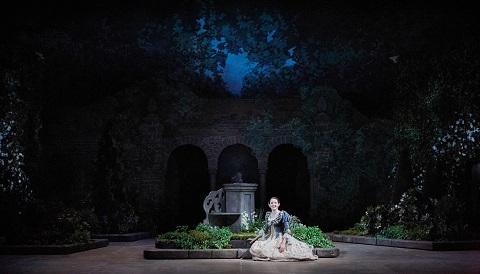 Jennifer France (Susanna). Photo credit: Mark Douet.
Jennifer France (Susanna). Photo credit: Mark Douet.
Some of the cast were new to Garsington. And, Duncan Rock’s Count was an interesting proposition. Cox and Rock dispense with vulgar aristocratic assumption, and with buffoonery, and present a Count who is thoughtful and, at times, acute and subtle, but whose duping is thus doubly effective and prompts sympathy alongside gleeful comeuppance. There was the usual incredulity and confusion, but also a genuine wish to understand how it has come about his servants are running rings around him, and a, perhaps, justified disgruntlement at his dependents’ independent willfulness. Rock balanced aristocratic presumption with human susceptibility.
I wasn’t entirely convinced by Canadian soprano Kirsten MacKinnon’s Countess. She certainly looked the part - beautiful, stately - and MacKinnon has a bristling richness at the top. But, ‘Porgi amor’ was somewhat hesitant, and she struggled to control and shape her vibrato; while first Act nerves might have been understandable, MacKinnon also seemed to rush through the phrases of ‘Dove sono’ and wandered off-pitch. There were a few rough edges too; there are places where glitzy dazzle is no compensation for lack of dulcet sweetness. That said, she made a positive contribution to the ensembles and her Act 3 duets with Susanna were a delectable intertwining.
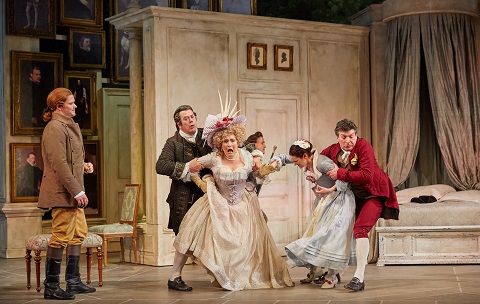 Duncan Rock (Count), Stephen Richardson (Bartolo), Janis Kelly (Marcellina), Timothy Robinson (Basilio), Jennifer France (Susanna), Joshua Bloom (Figaro). Photo credit: Mark Douet.
Duncan Rock (Count), Stephen Richardson (Bartolo), Janis Kelly (Marcellina), Timothy Robinson (Basilio), Jennifer France (Susanna), Joshua Bloom (Figaro). Photo credit: Mark Douet.
The last time I saw Janis Kelly, at Glyndebourne in 2016 as Berta in Rossini’s Barbiere, she threatened to steal the show. And, the same was true here: her Marcellina was a cross between 'Hyacinth Bucket' and Queen Elizabeth II, but her voice is still fresh and youthful. The Act 3 revelations of Figaro’s origins were expertly done - Kelly switched from financial grabbing matriarch to matronly concern in the twinkling of an eye; and, Kelly’s theatrical experience no doubt was of enormous help to the younger members of the cast.
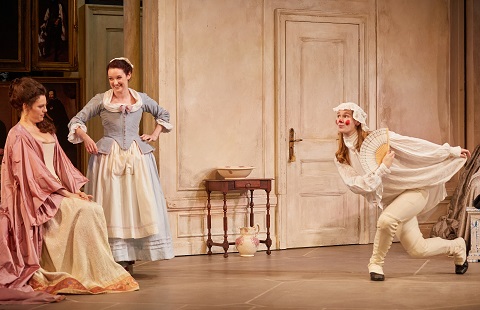 Kirsten MacKinnon (Countess), Jennifer France (Susanna), Marta Fontanals-Simmons (Cherubino). Photo credit: Mark Douet.
Kirsten MacKinnon (Countess), Jennifer France (Susanna), Marta Fontanals-Simmons (Cherubino). Photo credit: Mark Douet.
My first thought was that Marta Fontanals-Simmons was too tall for the adolescent Cherubino, but she proved a master (mistress) of fresh-voiced enthusiasm and cross-dressing faux-awkwardness. There were strong performances too from Timothy Robinson as Basilio - ‘What I said about the page was just a suspicion’ was nasally declaimed with wicked delight - and Stephen Richardson’s Dr Bartolo. Richardson ran away from the orchestra in the patter of ‘La vendetta’ but he was a surprisingly sympathetic character, his yearning for love and reconciliation outweighing that for revenge. Alison Rose’s Barbarina was a strongly delineated musical character portrait and Andrew Tipple’s inebriated gardener, Antonio, was gruff of sentiment but precise and vigorous of tone.
There were a few rough edges at this first-night performance, and though Dougie Boyd conducted with vivacious alertness, drawing a full range of emotions from his band, he couldn’t quite keep the Chorus tightly in rein, and the Act 3 Act ending was a little messy. But, the accelerating progression through the Act 2 finale was spot on, and I’m sure any minor teething problems will iron themselves out.
This is a delightful Figaro revival/recreation - what you will - that will undoubtedly get even better as the run progresses.
Claire Seymour
Le nozze di Figaro is performed on 4, 8, 10, 17 June and 3, 6, 8, 11, 14, 16 July.
Mozart: Le nozze di Figaro
Figaro - Joshua Bloom, Susanna - Jennifer France, Count - Duncan Rock, Countess - Kirsten MacKinnon, Cherubino - Marta Fontanals-Simmons, Bartolo - Stephen Richardson, Marcellina - Janis Kelly, Basilio - Timothy Robinson, Curzio - Alun Rhys-Jenkins, Antonio - Andrew Tipple, Barbarina - Alison Rose; Director - John Cox, Conductor - Douglas Boyd, Associate Director - Bruno Ravella, Designer - Robert Perdziola, Lighting Designer - Mark Jonathan, Choreographer - Kate Flatt.
Garsington Opera, 2 June 2017.
image=http://www.operatoday.com/Bloom%20%28Figaro%29%2C%20Jennifer%20France%20%28Susanna%29%20credit%20Mark%20Douet.jpg
image_description=Le nozze di Figaro, Garsington Opera
product=yes
product_title=Le nozze di Figaro, Garsington Opera
product_by=A review by Claire Seymour
product_id=Above: Joshua Bloom (Figaro), Jennifer France (Susanna)
Photo credit: Mark Douet
Semele: star-dust and sparkle at Garsington Opera
Derived from Euripides and Ovid, Semele relates the Greek myth of the eponymous princess, daughter of King Cadmus of Thebes, who prefers Jupiter - Jove, in his mortal form - to her betrothed, Athamas, Prince of Boethia, who is in turn loved by Semele’s sister, Ino. Semele craves more than simply a dalliance with a god, however; she wants immortality. Her judgement clouded by ambition, she is tricked by Jove’s vengeful wife Juno into demanding that Jupiter make love to her in his immortal form, thereby sealing her own destruction.
When Handel’s and William Congreve’s ‘secular oratorio’ was first seen 1744, the composer’s regular librettist Charles Jenners condemned it as ‘a bawdy opera’, and the contemporary London public were disconcerted by the risqué insinuations of the text - English, not the expected Italian - and frequent dramatic incursions by the chorus which broke with the da capo conventions of opera seria.
But, ever the man of the theatre, the politically astute Handel knew what he was doing. Congreve’s text had been written thirty years earlier for John Eccles, but the work had been withdrawn, throwing as it did rather too acute a light national anxiety over the succession in the aftermath of the Glorious Revolution of 1688. By the 1740s, the political context had changed. After the death of his wife, King George II had set up one of his many mistress, Amalie von Wallmoden, with a title and large income, and the public feared that she might become Queen. Moreover, the nation was still troubled by the threat of a Jacobite Revolution. This latter danger was embodied by the dissolute figure of Charles Edward Stuart - the young pretender, Bonnie Prince Charlie - whose religious leniency and sexual licentiousness were lamented in equal measure by the dour Hanoverians, who surely found anti-Jacobite resonances in Handel’s portrayal of Jupiter.
Handel’s tale of human ambition and marital infidelity among the immortals is thus a heady mix of sex and power which, at the time, shone a satirical spotlight on both national and theatrical politics. But, as Miskimmon and Shaw recognise, it’s a passionate brew that is no less relevant today, as the soap operas that play out on both the television screen and the political stage confirm. Handel stirs sensuousness into the satire and, if she does not quite always control the balance between triviality and tragedy, then Miskimmon offers both playfulness and pathos, potently illuminating the perils of jealousy, self-love and ‘vaulting ambition’.
Miskimmon presents a busy mime during the overture as high-society guests in fashionable modern dress gather for the wedding of Semele (Heidi Stober) and Athamas (Christoper Ainslie) in a plush civil hall - royal-blue curtains, an outsize red heart, golden chandeliers and towering cake - while Llio Evans’ Iris, the messenger of the gods (part stage-manager, part Shakespeare’s Ariel), runs a tech check and takes position atop the heart to watch the nuptials unfold. But, as the edgy rhythms and nervous motivic interplay strike up in the pit, so the jealous Juno - tired out by pregnancy and her husband’s infidelity, pushing a double-buggy and surrounded by her pink-clad brood - appears, to remind us that drastic divine intervention is imminent.
That’s when the fun starts. As Semele is dragged to the altar by Cadmus (David Soar) and urged by the chorus to bring peace and luck to the nation through this auspicious wedlock, Jupiter (Robert Murray) saunters around the anxious guests, drawing nonchalantly on a cigarette. When Semele calls upon the deity for guidance, he short-circuits the chandeliers, shatters the heart of roses and blows up the wedding cake. The drapes are drawn back to reveal the planetary paradise whence Semele is whisked by a crew of celestial flight attendants, their berets capped with golden wings. Ensconced in Jupiter’s lunar love-nest, she is stripped of her earthly wedding frock and dressed in the silvery beams of stars and moons - or, more prosaically in lamé cloaks and cat-suits.
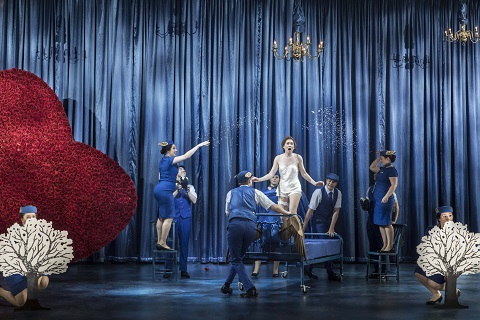 Heidi Stober (Semele) with Garsington Opera Chorus. Photo credit: Johan Persson.
Heidi Stober (Semele) with Garsington Opera Chorus. Photo credit: Johan Persson.
Shaw makes the most of the wide Garsington stage and presents us with a night-blue observatory panorama of pendulous orbs amid zodiacal light and nebulae. The splintered chandeliers are replaced by gleaming globes. It’s a hypnotically beautiful vista, and as the real night descends around the Garsington pavilion one can almost hear the cosmic harmony. When the globes lower, to nestle around the sleeping Semele, she looks like Tytania amid her faery bower of magic lanterns.
However, despite the air of enchantment there’s mischief afoot, in the form of the wrathful Juno (Christine Rice) who, with childbirth imminent, impatiently - and hilariously - grabs the gas and air from her inattentive nurse, David Soar’s drowsy Somnus. The latter also proves reluctant to join in the plan to destroy Semele, until the scheming Juno bewitches his duvet into an erotic bedpartner and promises him the love of the nymph Pasithea. Disguised as Ino, Juno convinces Semele to demand that Jupiter comes to her in his immortal form. As Stober’s Semele poses and preens - ‘Myself I shall adore,/ If I persist in gazing./ No object sure before/ Was ever half so pleasing’ - framed within a wonky light-bulb rimmed heart, the message to selfie-snappers and narcissistic Instagrammers is clear.
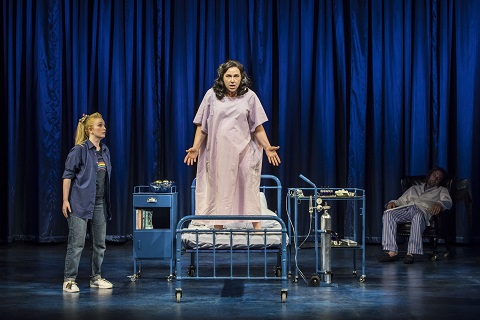 Llio Evans (Iris), Christine Rice (Juno), David Soar (Somnus) Photo credit: Johan Persson.
Llio Evans (Iris), Christine Rice (Juno), David Soar (Somnus) Photo credit: Johan Persson.
Bewitched by Somnus, Jupiter is unable to deny her request and removes his mortal form’s leather gloves; when the inevitable thunderbolt flashes, Semele becomes a luminous astronomical body. But, despite her overweening egoism, the image created by Shaw and lighting designer Mark Jonathan of her progress towards the heavens, reflected in a huge mirror-orb, creates genuine pathos. She climbs into her cosmic coffin and the Chorus returns, the wedding guests now mourners at Semele’s funeral, their candles of remembrance placed in a stellar formation of flames over which her ashes - like interstellar dust - are scattered.
Back on earth, happiness is being restored. Hermes has come to Ino in a vision, revealing her sister’s fate and Jupiter’s wish that Ino marry Athamas. He seems happy to oblige. Apollo appears to announce that a new god will rise from Semele’s ashes: cue the arrival of a golden cherub, Bacchus - in a neat touch, played by Stober’s cute young son - who is snatched up by the be-winged, gold-suited Jupiter, to the fury and despair of Juno who departs, presumably to plot her next act of retaliation.
It is the choruses that betray the work’s ‘oratorio’ origins and Miskimmon’s direction of the twenty-eight-voiced Garsington Opera Chorus is superb: precise, detailed, imaginative, credible. The choreography and timing is perfect: even Juno’s children - a veritable clan of van Trapps - collect up the shining orbs with flawless exactness. And, the Chorus are in tremendous voice. They almost steal the show.
Not quite, though. For me, that accolade goes to Christine Rice who, piercing Juno’s nails into Iris’s palm as her coloratura roulades attest to her suffering, uses every inch of her wide range to convey the goddess’s fury. Hearing her low notes burn one could not doubt her scorching spite and resentment. Rice’s Juno is both terrifying and comic, and her flashes of vocal fire are the equal of her husband’s lightning strikes.
In the title role, American soprano Heidi Stober captures of all of Semele’s headstrong ambition and solipsism, but the sensuousness of her phrasing and the amber glow which swathes her soprano from bottom to top makes the wilful princess an absolutely mesmerising minx. She has the breath control and agility to tackle the virtuoso arias with confidence, but each one is individually characterised. Her achievement is all the more noteworthy given that Stober twisted her knee during Act 2; one would never have known, so physically and vocally lively and engaged was she.
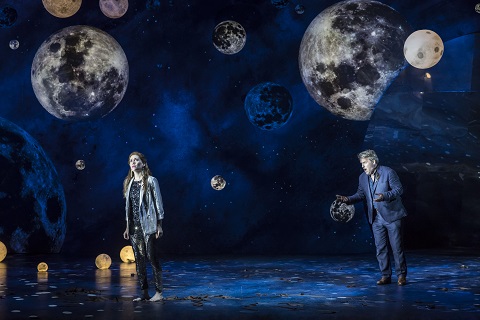 Heidi Stober (Semele) and Robert Murray (Jupiter). Photo credit: Johan Persson.
Heidi Stober (Semele) and Robert Murray (Jupiter). Photo credit: Johan Persson.
Handel’s characterisation of Jupiter is unusual, for there is little imperiousness and majesty. Robert Murray’s easeful, sweet tender was perfect for the opera’s ‘greatest hit’, ‘Where’er you walk, cool gales shall fan the glades’ - an attempt to beguile Semele to distract her from her demands for immortality. Murray moved from the amusingly futile hope that his ‘softest thunder’ and ‘most melting bolt’ might do least harm to his beloved, to a love song of great tenderness. As the petals fell on his prone darling, poetic artifice and sincere devotion were fused. In contrast, ‘Ah! take heed’ rang with thrillingly with dread.
Doubling up as the authoritative Cadmus and slapstick Somnus, David Soar showed his dramatic range. His bass had terrific power and resonance; and, like all the cast and chorus, his diction was superb - for once, surtitles were genuinely redundant.
Ino’s Act 1 aria, in which she pleads with the rejected Athamas to turn his sad eyes in her direction, was expressively sung by mezzo soprano Jurgita Adamonytė, and beautifully accompanied by Ashok Gupta (organ) and Jane Fenton (cello). During the aria, the Chorus removed the chairs set out for the aborted nuptials and, typically of the care and precision executed throughout, for once action in the background did not distract at all from the expressive focus established by Adamonytė.
I was not entirely convinced by the relationship between Ino and Christopher Ainslie’s Athamus, but perhaps one is not meant to be. Ainslie has a fairly soft-grained countertenor, and Athamas’ first aria of passion, ‘Hymen, haste, thy torch prepare’ did not project with the requisite weight, though it was technically accomplished and stylishly phrased.
In the minor roles, Welsh soprano Llio Evans sang with strong character as Iris, while Christian Valle was a stentorian Priest, overseeing the marriage ceremony. Mikael Onelius’s Apollo was a potent soothsayer. Conductor Jonathan Cohen drew vibrant playing from the Garsington Opera Orchestra.
‘Endless pleasure, endless love’, Semele enjoys in her celestial boudoir. This witty, winning production allows us to share in her delight.
Claire Seymour
Semele will be performed on 1, 3, 9, 11, 15, 24, 30 June and 4 July: https://www.garsingtonopera.org/performance/semele
Free screenings will be shown on 1 July (Skegness & Oxford), 22 July (Ramsgate), 29 July (Bridgwater), 15 October (Grimsby): http://www.garsingtonopera.org/news/opera-all-2017-screenings
Handel: Semele
Semele - Heidi Stober, Jupiter - Robert Murray, Juno - Christine Rice, Cadmus & Somnus - David Soar, Athamas - Christopher Ainslie, Iris - Llio Evans, Ino - Jurgita Adamonytė, Apollo - Mikael Onelius, High Priest - Christian Valle; Director - Annilese Miskimmon, Conductor - Jonathan Cohen, Designer - Nicky Shaw, Lighting Designer - Mark Jonathan, Movement Director - Sarah Fahie.
Garsington Opera, Thursday 1 June 2017.
image=http://www.operatoday.com/Christine%20Rice%20%28Juno%29%2C%20Heiei%20Stober%20%28Semele%29%2C%20Jurgita%20Adamonyte%20%28Ino%29%20credit%20Johan%20Persson.jpg image_description=Semele, Garsington Opera product=yes product_title=Semele, Garsington Opera product_by=A review by Claire Seymour product_id= Above: Christine Rice (Juno), Heiei Stober (Semele), Jurgita Adamonyte (Ino)Photo credit: Johan Persson
June 2, 2017
La rondine at Investec Opera Holland Park
The two operas with which Puccini followed Madama Butterfly
(1904), La fanciulla del West (1910) and La rondine
(1917) are the two operas where Puccini used to be seen as not being
completely on form, before he returned with his final operasIl Trittico and Turandot. ThoughLa fanciulla del West has been somewhat rehabilitated, La rondine still somewhat languishes and can be seen as combining
pleasant melodies with plot which is a bad re-hash of La Traviata
and Die Fledermaus. But the period after Madama Butterfly
saw Puccini trying to extend and develop his art both thematically and
harmonically, for instance La fanciulla del West uses an advanced
harmonic language and a daring lack of free-standing aria, and the triptych
form of Il trittico was highly innovative.
So La rondine can be seen in this light, as an experiment in the
other direction, trying something lighter. Originally intended as an
operetta, Puccini dropped the idea of spoken dialogue (though other Italian
contemporaries would try operetta), but La rondine remains lighter
in style with greater use of popular dance rhythms. And the plot can be
seen as re-visiting La boheme; it helps to make sense of the
dramaturgy if you think of Magda and Prunier as Musetta and Rodolfo (from La boheme) some years later, and Magda's fond memories of
Bullier's in Act One a reminiscence of Cafe Momus. We heard Puccini's
original version of the opera (the one usually done), though Ruggero's Act
One solo was included from Puccini's final revision.
Martin Lloyd-Evan's production set the piece loosely in the 1950s which meant
that Chez Bullier became the sort of smoky French cafe/bar familiar from
films, whilst the hotel on the Riviera in Act Three had certainly seen
better days. Costumes were stylish, and I was impressed that the outline
and high-waistlines of the men's suits were correctly in period. I can
understand that Magda's Act One costume was intended to make her stand out,
but its rather acid yellow colour was anything but flattering.
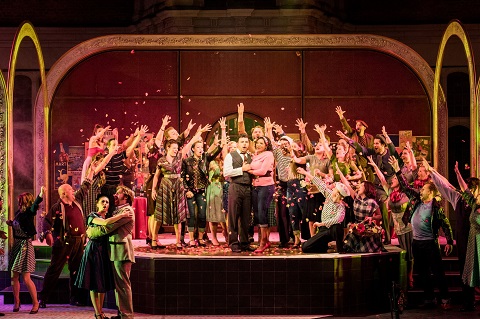 Elizabeth Llewellyn as Magda and Matteo Lippi as Ruggero, with the Opera Holland Park Chorus. Photo credit: Robert Workman.
Elizabeth Llewellyn as Magda and Matteo Lippi as Ruggero, with the Opera Holland Park Chorus. Photo credit: Robert Workman.
Act One is very much an ensemble piece with Magda (Elizabeth Llewellyn)
being surrounded by Prunier (Stephen Aviss), Rambaldo (David Stephenson)
and the guests (Henry Grant Kerswell, Timothy Langston, Alistair
Sutherland, Pia Harris, Alice Privett, Sophie Dicks), and much of Puccini's
writing is in the same ensemble conversation style which he used in the
opening of La fanciulla del West; it is a style which can be
tricky to bring off on the large open stage at Opera Holland Park and the
act took some time to settle. What really counted was the dramatic
interaction between the performers, so that though Puccini and his
librettists give us very little background, Lloyd-Evans and his cast established
a real atmosphere between Magda and Rambaldo.
The transition to Act Two was done almost instantaneously with the cast
dramatically ripping off the decor for Act One. Chez Bullier really
showcased the excellent Opera Holland Park Chorus (chorus master Nicholas
Jenkins) and this provided the lively backdrop for the developing
relationship between Llewellyn's Magda and Matteo Lippi's Ruggero,
counterpointed by the lively bickering of Aviss's Prunier and Gevorgyan's
Lisette. The use of the original version of the opera means that the third
act ultimately concentrates on Magda and Ruggero (no trio of vendeuses, no
scene for Rambaldo), and Lloyd-Evans's production made the most of this.
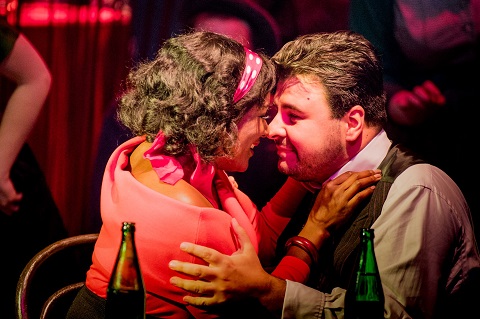 Elizabeth Llewellyn as Magda and Matteo Lippi as Ruggero. Photo credit: Robert Workman.
Elizabeth Llewellyn as Magda and Matteo Lippi as Ruggero. Photo credit: Robert Workman.
Elizabeth Llewellyn's Magda took some time to develop. In Act One she was
very much part of the ensemble with only the verse of 'Chi il bel sogno di
Doretta' to show off. This was done with great character making it part of
the drama rather than milking it as a big solo. In Act Two it is the
relationship with Ruggero (Matteo Lippi) which counted and the two made a
real connection, soaring in the love duet. It was this connection which
made Act Three blossom, Llewellyn and Lippi soared again in the final duet,
and if the ending is not quite as heart-rending as some Puccini's ones,
Llewellyn showed how to make it count with sheer beauty of line and a
glorious sheen to the voice. This certainly showed how having a real spinto
soprano in the role can count.
Matteo Lippi (who sang Pinkerton with Glyndebourne in 2016) made a
delightfully sympathetic Ruggero, emphasising the character's small-town
naivety, this was really brought over in his delightful Act One solo.
Throughout Lippi sang with a lovely rich, bronzed sound which also helped
imbue Ruggero with sympathy. He and Llewellyn made a wonderfully balanced
pairing, with Lippi including just the right combination of bravura solo
and supportive partnering, matching Llewellyn in beauty of tone.
Tereza Gevorgyan made a delightful, hyperactive Lisette, singing Puccini's
coloratura-style line with both style and accuracy, plus a sense of wit.
Stephen Aviss made a robust, characterful Prunier providing a necessary
contrast in tenorial style from Lippi, and providing his own piano
accompaniment in 'Chi il bel sogno di Doretta'. But it was the way Aviss
and Gevorgyan developed a really sparky relationship, carrying us through
all three acts, which formed a nice complement to the two leading
characters.
David Stephenson made a nicely sympathetic Rambaldo, whilst Henry Grant
Kerswell, Timothy Langston, Alistair Sutherland, Pia Harris, Alice Privett,
and Sophie Dicks provided strong and characterful support, and Alys Roberts
gave us the delightful solo at the end of Act Two.
Matthew Kofi Waldren kept the ensemble scenes in the first two acts moving
with vivid impetus, encouraging the orchestra to provide characterful,
full-blooded drama which complemented the stage though occasionally I would
have liked vibrancy to give way to something more relaxed. But in the
duets, Waldren showed that he could balance things, allowing the singers to
shape Puccini's melodies. This wasn't the most luxuriant account of the
score, but the playing of the City of London Sinfonia brought out the
vibrant colours and details of Puccini's writing.
There are seven more performances of La Rondine and I suspect that
the performance, particularly the opening act, will bed down nicely and
develop. But it is in the superb partnership of Elizabeth Llewellyn and
Matteo Lippi that the strength of this production lies.
Puccini: La Rondine
Opera Holland Park, 1 June 2017
Magda: Elizabeth Llewellyn, Ruggero: Matteo Lippi, Lisette: Tereza Gevorgyan, Prunier: Stephen Aviss, Rambaldo: David Stephenson, Henry Grant Kerswell, Timothy Langston, Alistair Sutherland, Pia Harris, Alice Privett, Sophie Dicks
Director: Martin Lloyd-Evans, conductor: Matthew Kofi Waldren
City of London Sinfonia
image=http://www.operatoday.com/la-rondine-015.jpg image_description=La rondine, Investec Opera Holland Park product=yes product_title=La rondine, Investec Opera Holland Park product_by=A review by Robert Hugill product_id=Above: Stephen Aviss as Prunier and Elizabeth Llewellyn as MagdaPhoto credit: Robert Workman
